Это был третий день нашего знакомства с Лиссабоном. В первый – мы прошли город пешком с севера на юг, до площади Коммерции (Praca do Commercio), во второй – изучали город при помощи 28-го трамвая, фуникулеров, смотровых площадок и, само собой, своих ног. Третий день решили посвятить району Белен, туда всех туристов привозит трамвай №15.
Стартовали мы с самой дальней точки нашего маршрута – Башни Белем (Torre de Belem), возведенной более пяти веков назад как важное стратегическое и оборонительное сооружение.
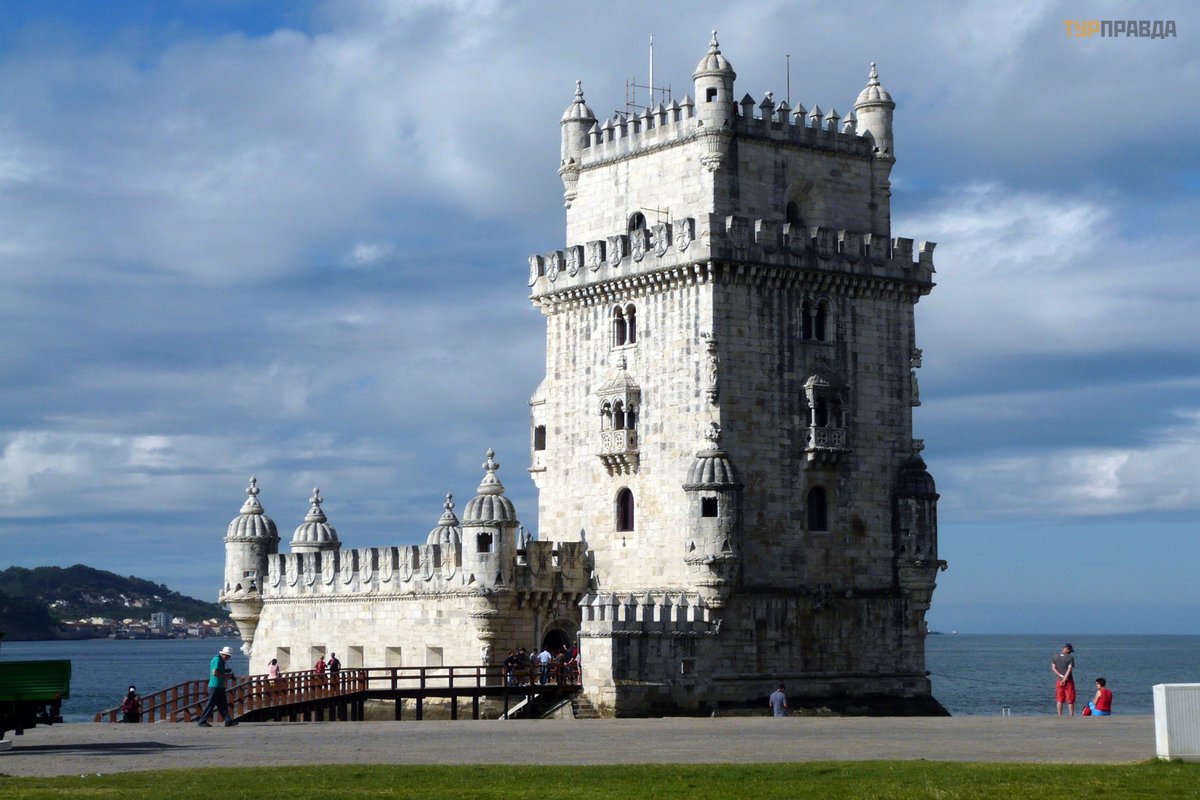 Лиссабон. Башня Белем
Лиссабон. Башня Белем
Построенная в 1515 году на середине реки, она должна была защищать вход в гавань Лиссабона. Именно ее видели мореплаватели, возвращаясь после долгих странствий домой, она же была « последним взглядом на свою Родину» для португальцев, отбывавших в дальние морские экспедиции. А небольшая статуя Богоматери с младенцем на террасе башни стала символом защиты моряков во время их плаваний.
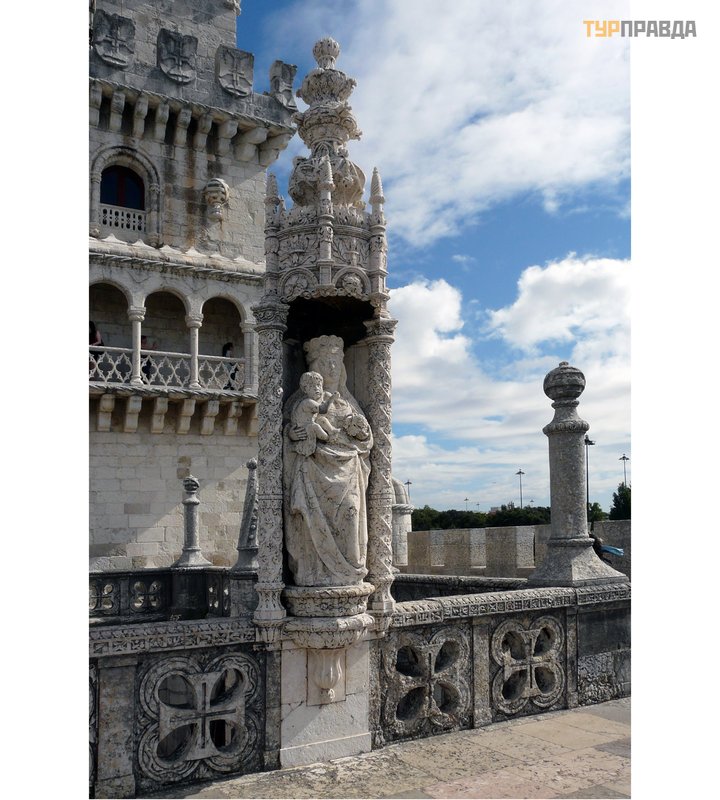 Башня Белем, статуя Богоматери
Башня Белем, статуя Богоматери
Мы приехали к Башне Белем незадолго до открытия, уже собралась небольшая очередь. Сразу взяли комплексный билет на посещение башни и монастыря Жеронимуш. Я точно не помню цену, помню лишь, что такой билет получался дешевле, нежели бы мы покупали билеты отдельно в каждый объект. Да и после в монастырь мы зашли, минуя огромную очередь.
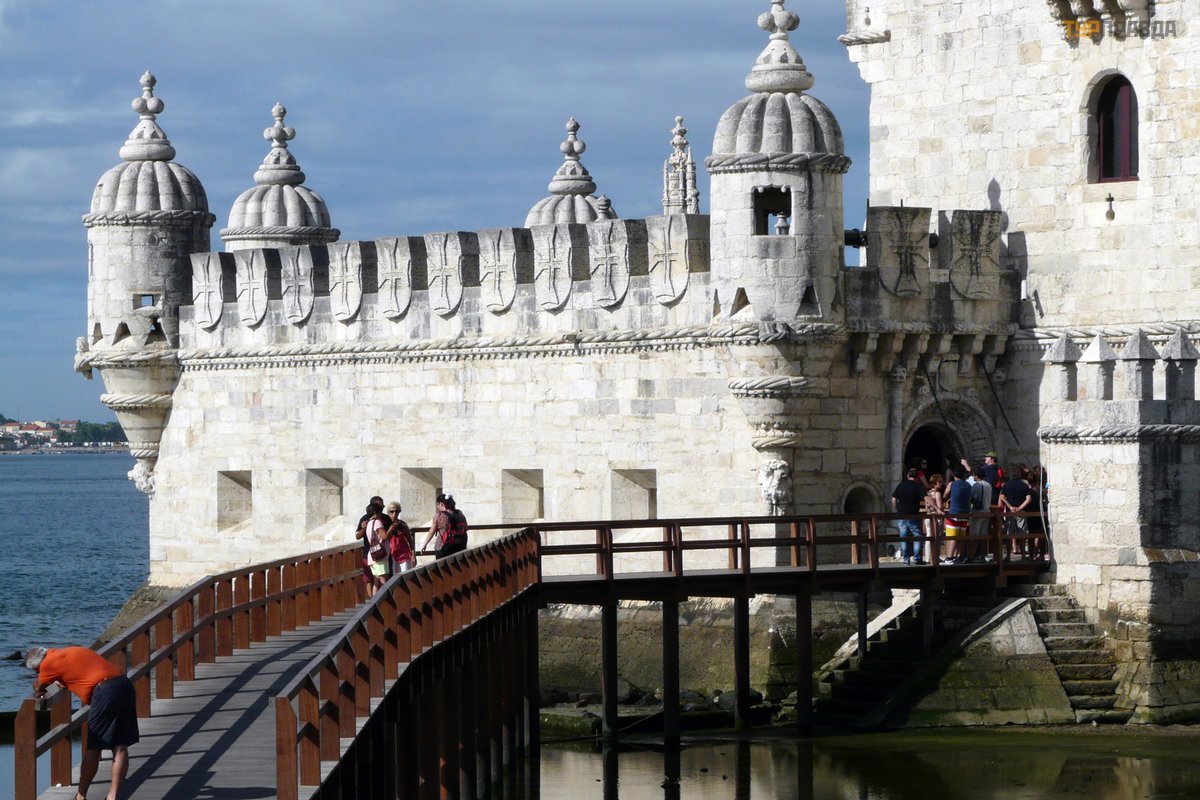 Лиссабон. Башня Белем
Лиссабон. Башня Белем
Башня представляет собой этакий мини-замок в окружении зубчатых стен с бойницами на оборонительных ярусах, со множеством дозорных башенок, увенчанных мавританскими куполами, с балконами и лоджиями в венецианском стиле. На первом этаже расположена небольшая крытая галерея с выходом во внутренний дворик. На втором уровне – открытая терраса с ажурной балюстрадой. Оттуда узкие крутые ступени ведут на вершину замка. На верхних этажах – Королевский и Губернаторский залы и Зал для аудиенций.
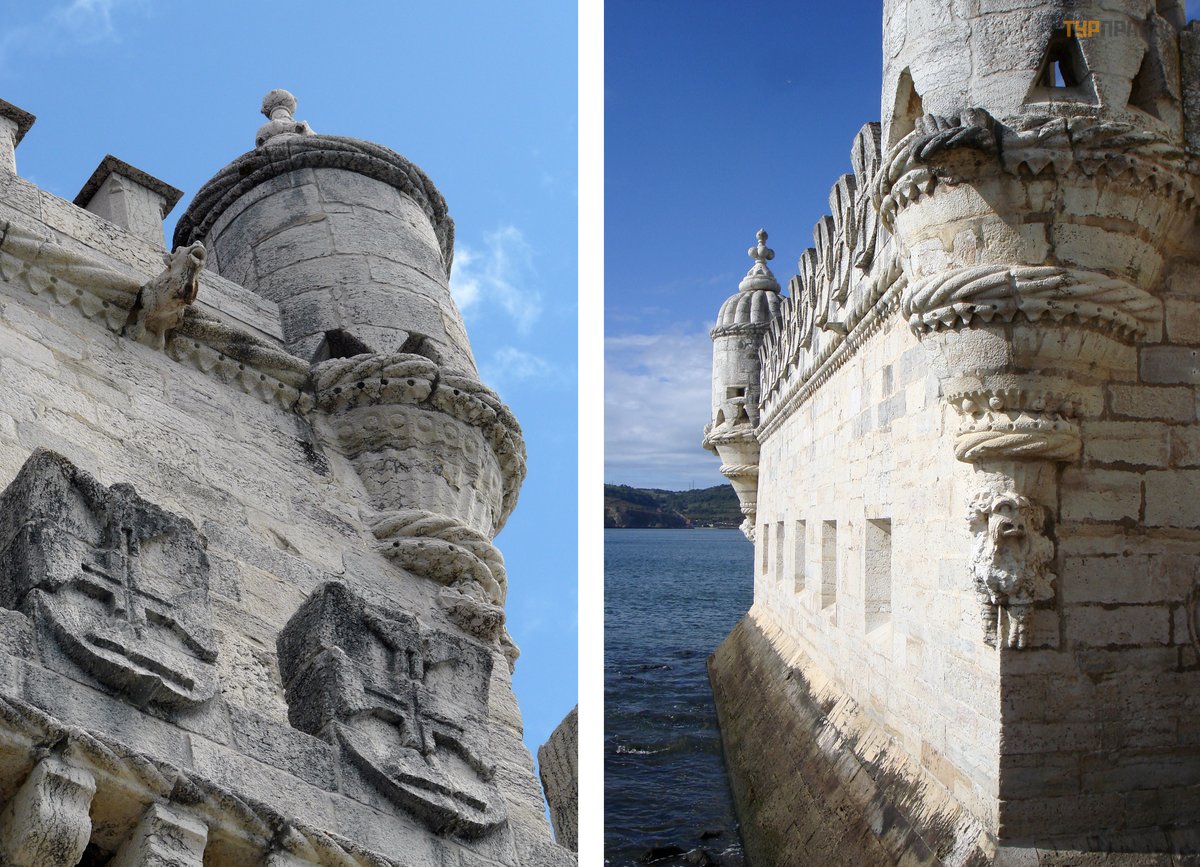 Башня Белем
Башня Белем
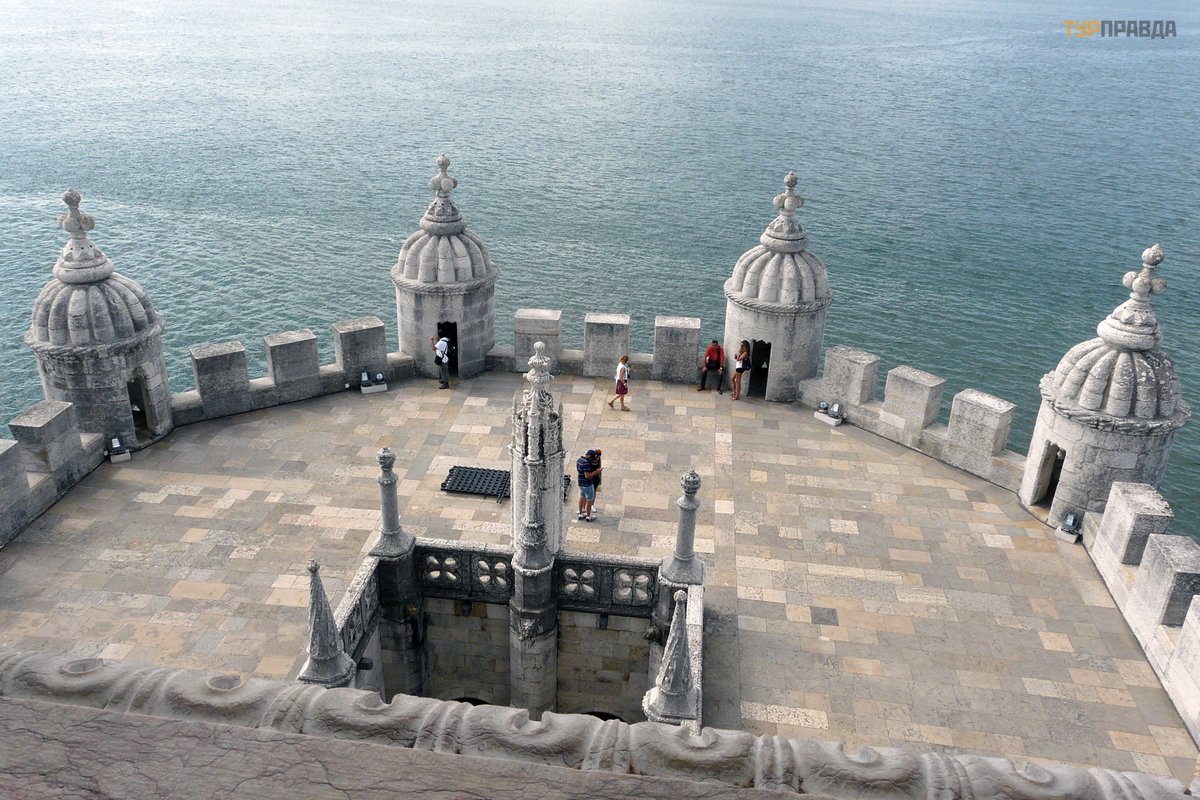 Башня Белем, терраса
Башня Белем, терраса
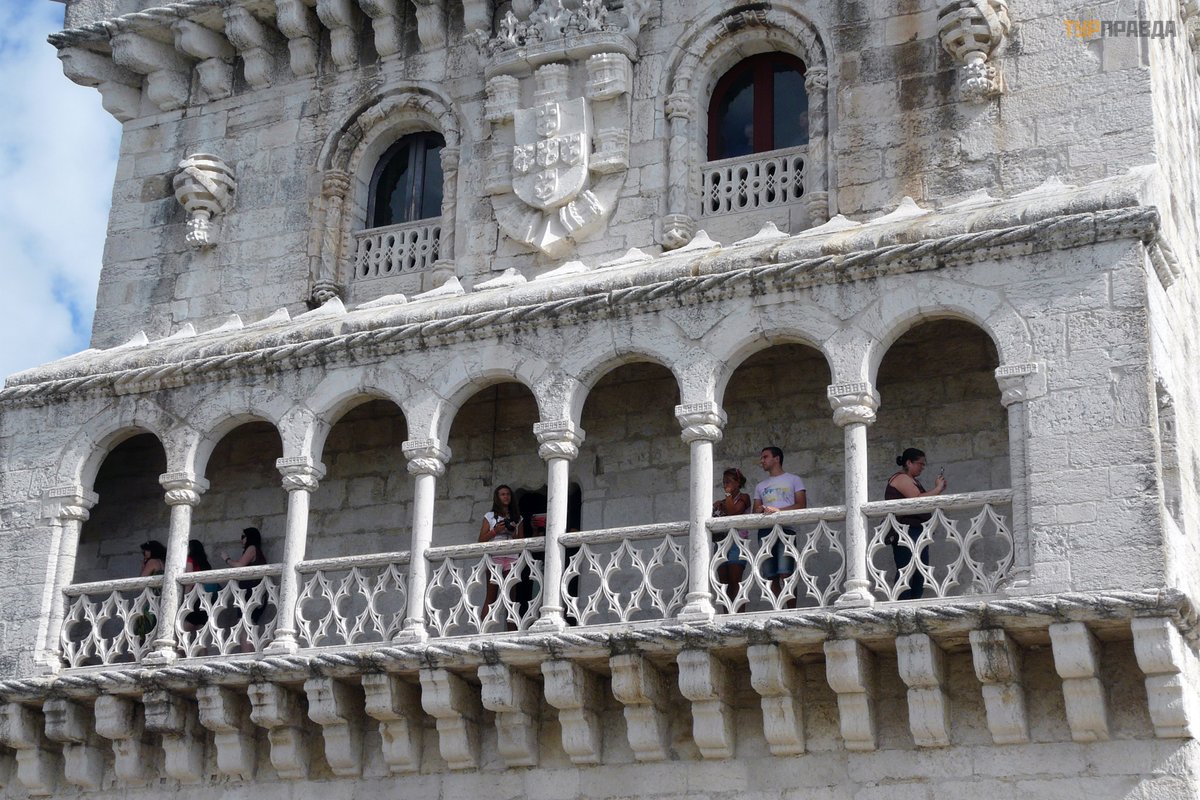 Башня Белем
Башня Белем
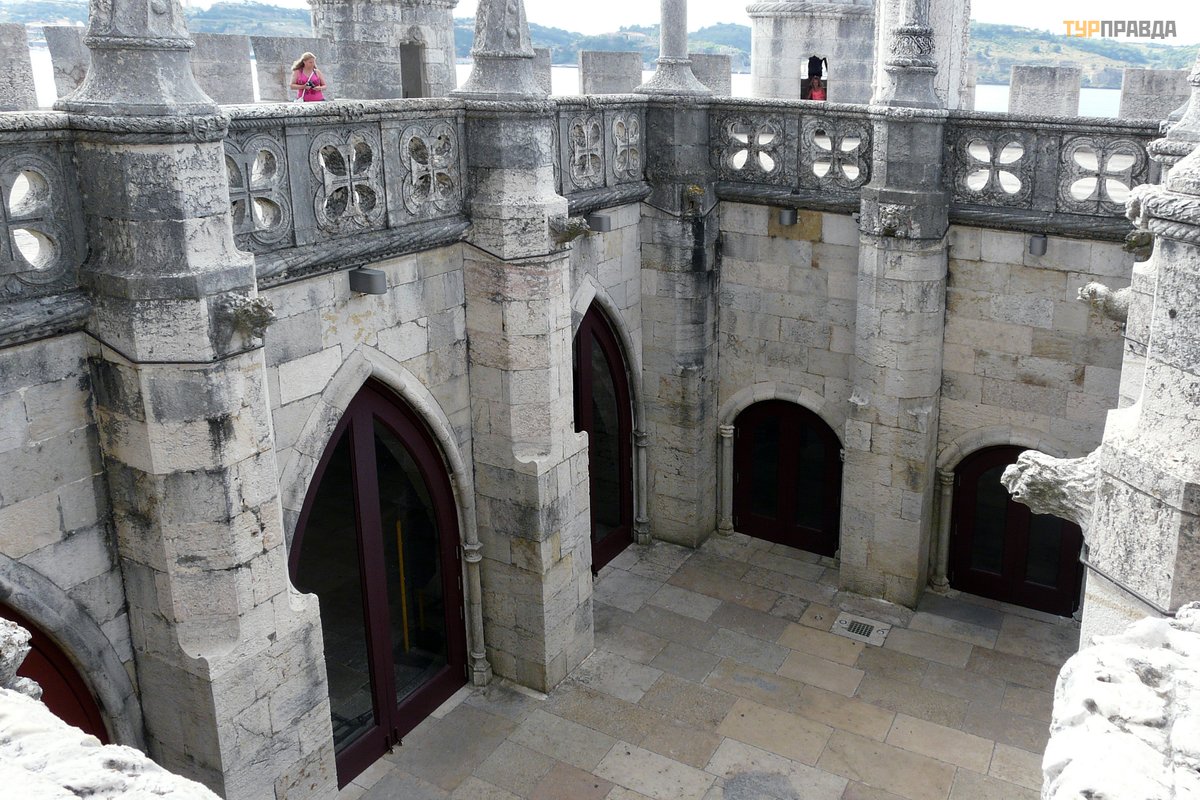 Башня Белем
Башня Белем
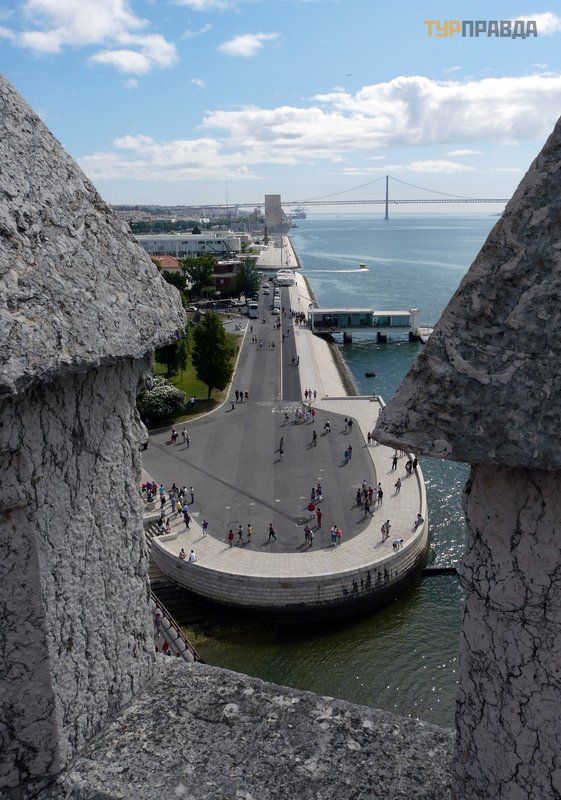 Башня Белем
Башня Белем
Землетрясение 1755 года изменило русло реки, и сейчас башня стоит уже практически на берегу.
Любопытно – чтобы развести встречные потоки туристов на узкой крутой лестнице, для регулирования движения сделаны специальные светофоры с таймером времени.
Следующая точка нашего маршрута – Монастырь Жеронимуш, самое грандиозное сооружение Лиссабона, относящееся к одному из семи чудес Португалии. Добраться к нему можно, вернувшись к трамваю и проехав одну остановку, но мы решили пройти вдоль набережной мимо возведенного в 1960 году памятника Первооткрывателям.
Памятник напоминает гигантскую каравеллу. Во главе – знаменитый принц Энрике Мореплаватель, под влиянием которого Португалия когда-то стала великой морской державой. За ним – Король Афонсу V и Васко да Гама. Всего по обеим сторонам монумента расположены 32 фигуры выдающихся людей страны, внесших вклад в становление Португалии как морской империи. Наверху есть смотровая площадка, к которой можно подняться на лифте.
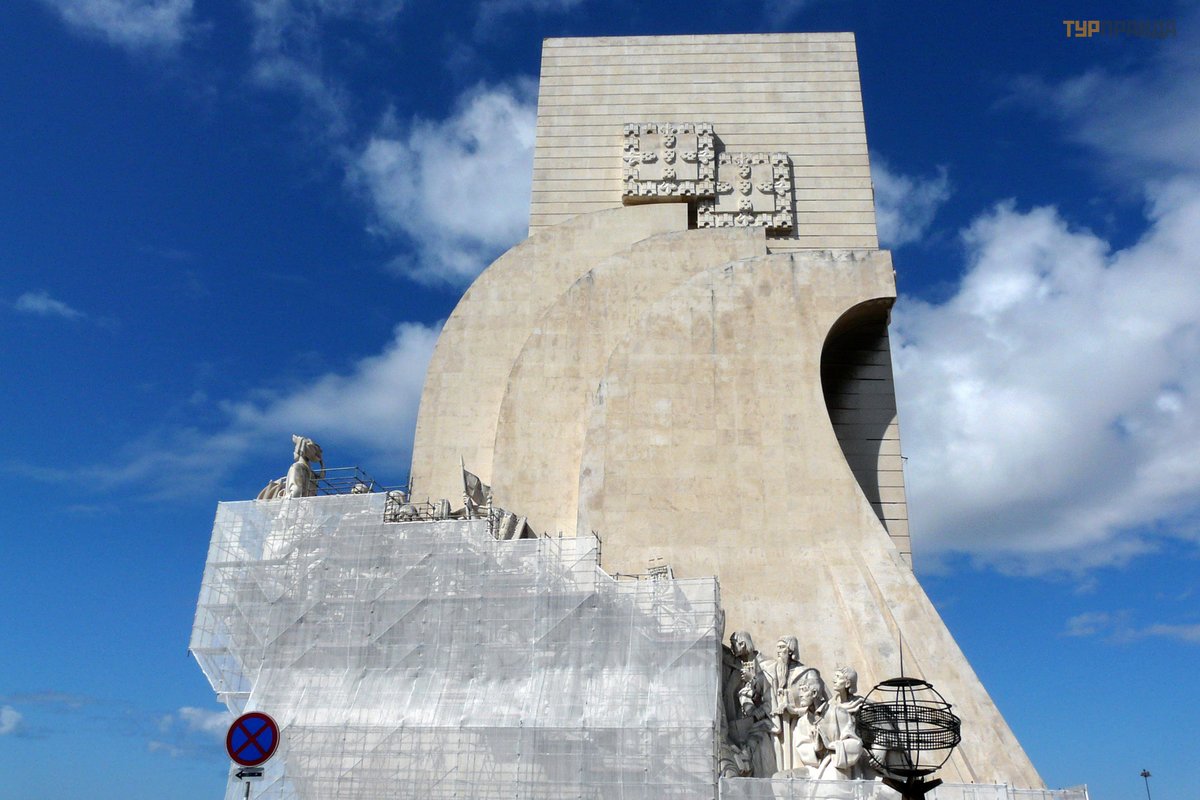 Лиссабон. Памятник Первооткрывателям
Лиссабон. Памятник Первооткрывателям
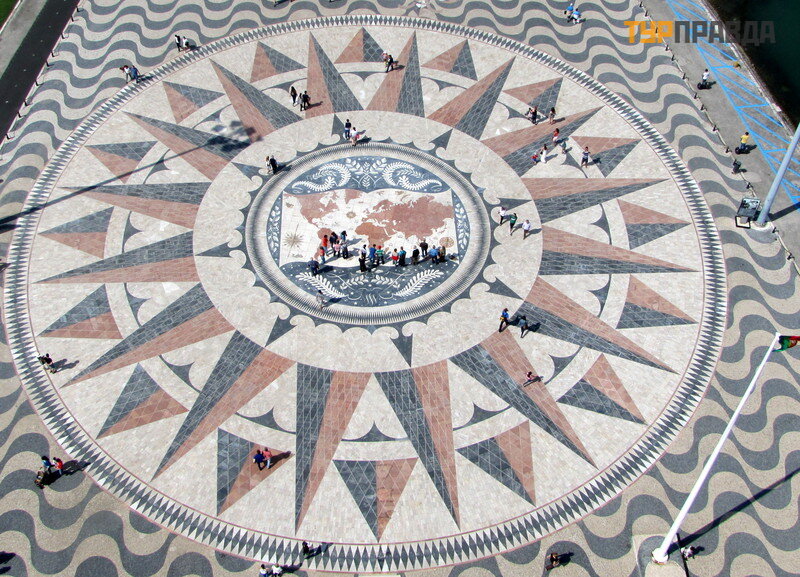
Лиссабон. Площадь перед памятником Первооткрывателям. Снимок взят из интернета
Памятник был затянут сеткой – что-то нам везло в этой поездке на реставрирующиеся достопримечательности : )). Но огромная карта мира, выложенная цветным мрамором на площади перед стеллой, надолго привлекла и наше внимание и внимание множества туристов.
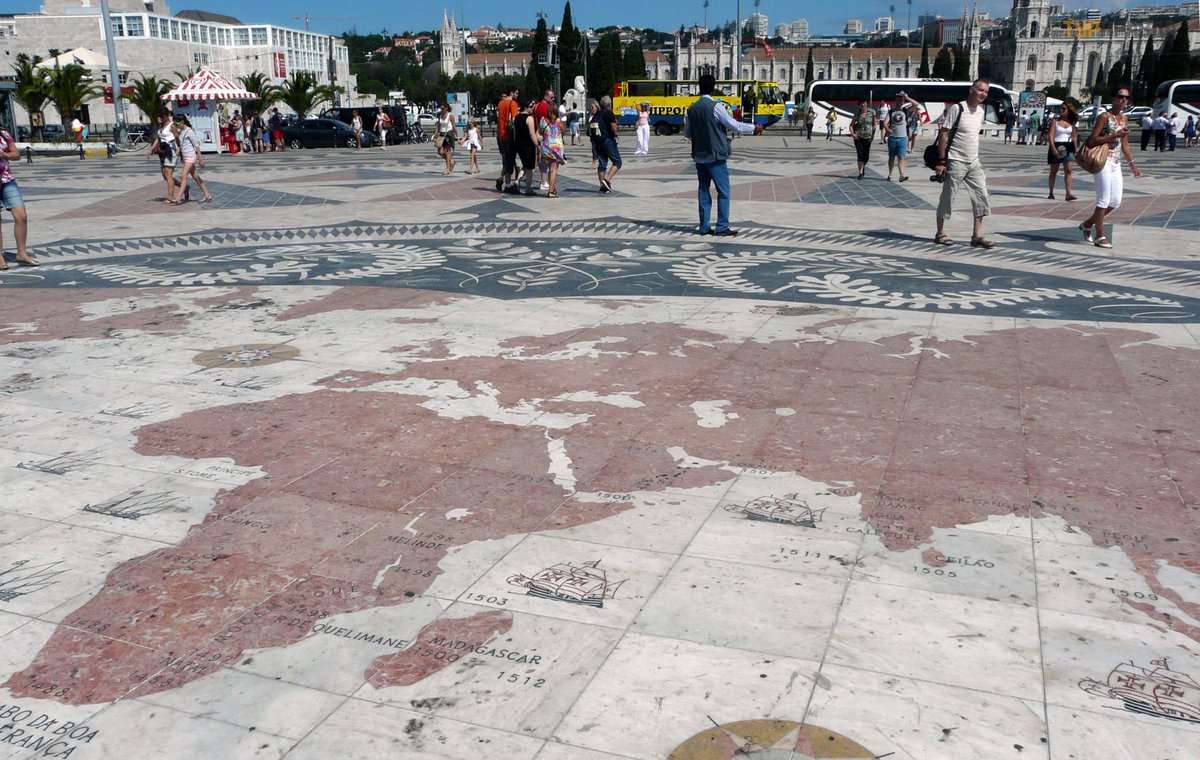 Лиссабон. Площадь перед памятником Первооткрывателям
Лиссабон. Площадь перед памятником Первооткрывателям
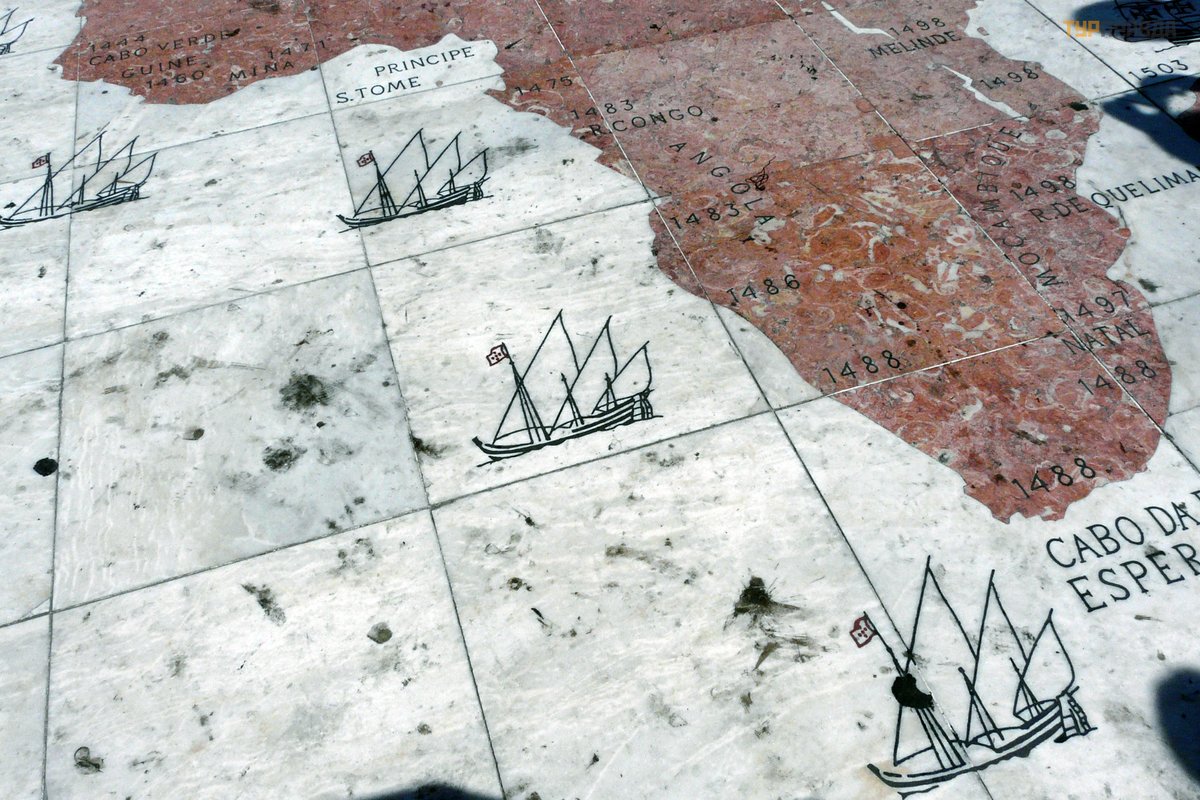 Лиссабон. Площадь перед памятником Первооткрывателям
Лиссабон. Площадь перед памятником Первооткрывателям
Прочитав все надписи на карте : ), пересекаем огромную, красивую площадь с фонтаном. Прямо перед нами – Монастырь Жеронимуш (Mosteiro dos Jeronimos), впечатляющее здание, символ мощи и богатства Португалии в эпоху Великих географических открытий.
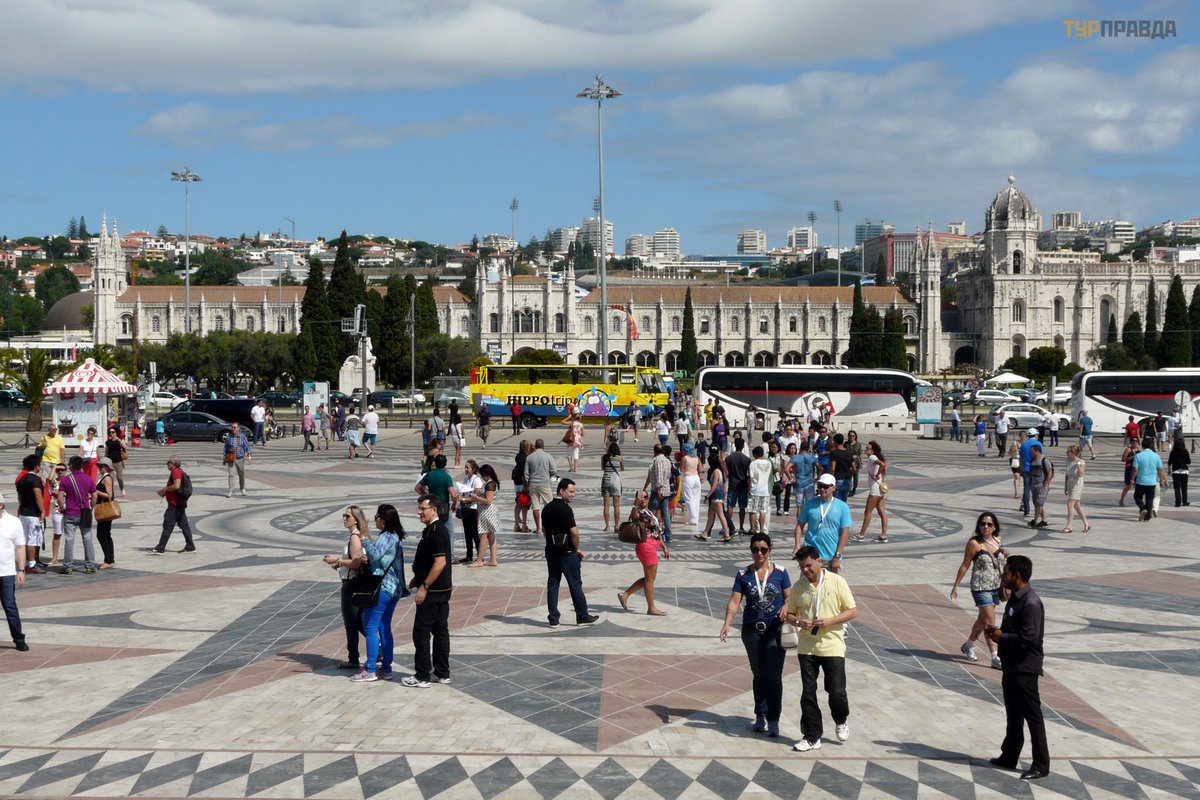 Лиссабон. Площадь перед памятником Первооткрывателям
Лиссабон. Площадь перед памятником Первооткрывателям
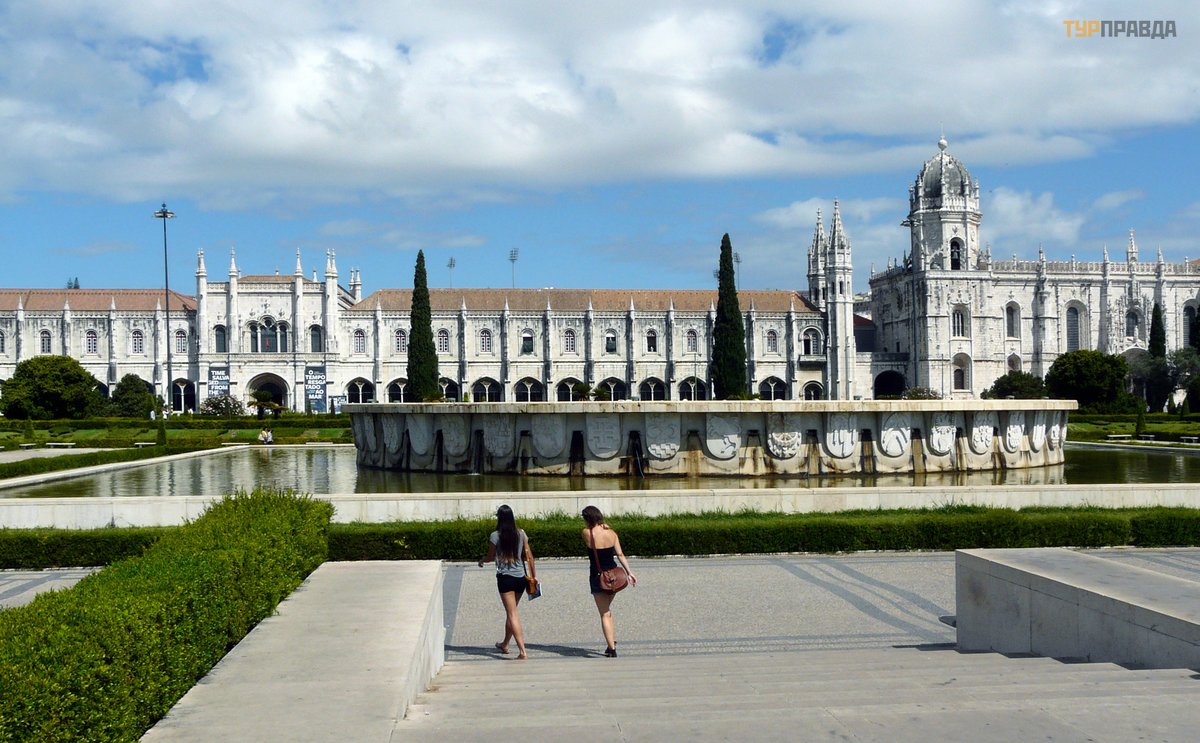 Лиссабон. Монастырь Жеронимуш
Лиссабон. Монастырь Жеронимуш
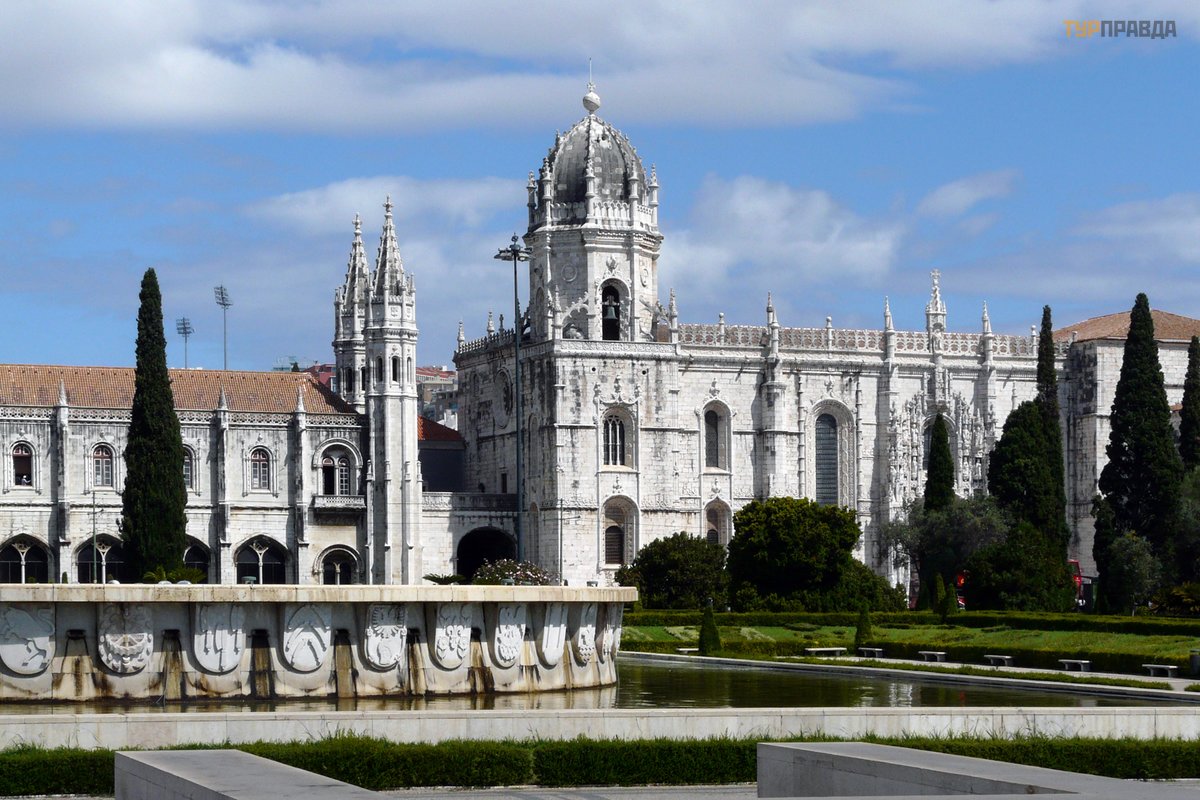 Лиссабон. Монастырь Жеронимуш
Лиссабон. Монастырь Жеронимуш
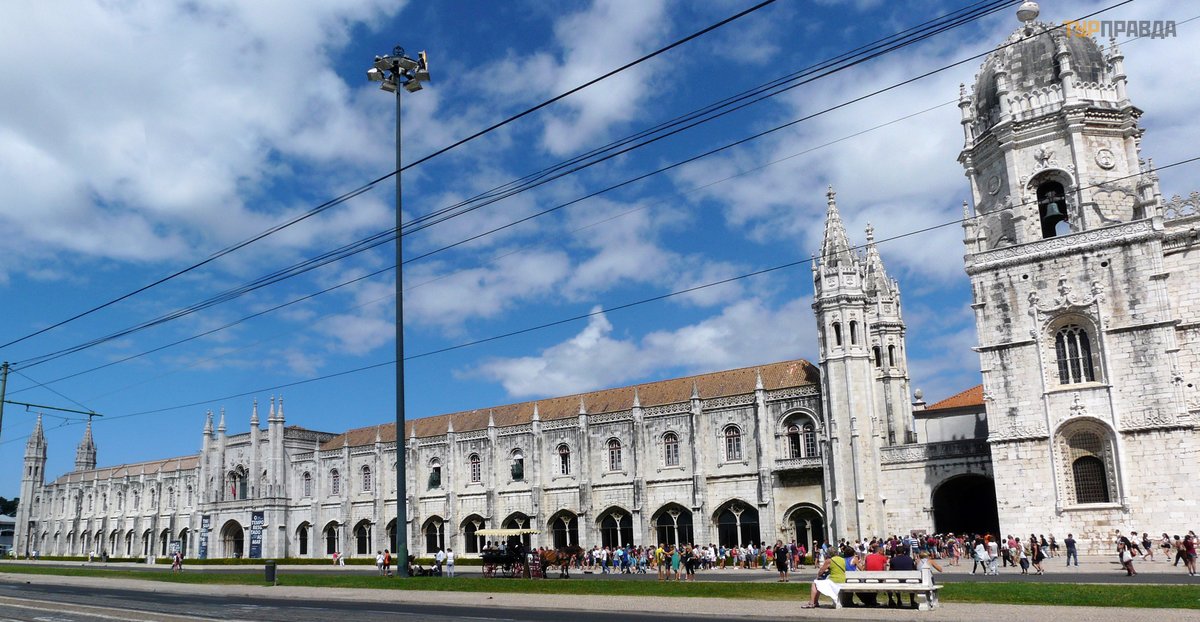 Лиссабон. Монастырь Жеронимуш
Лиссабон. Монастырь Жеронимуш
Король Мануэль I начал строительство монастыря в 1501 году на месте часовни, возведенной принцем Генрихом Мореплавателем. В этой часовне Васко да Гама и его команда провели последнюю ночь в молитвах перед своим отплытием в Индию.
Генрих был известен своей страстью к открыванию новых земель. Он снаряжал экспедиции для систематического исследования ближнего берега Атлантики и побережья Африки, и далее – в Индию. Именно средства, вырученные от продажи специй и сокровищ, привезенных из Азии, Африки и Южной Америки, стали постоянным источником финансирования строительства и расширения монастыря, которое продолжалось более полувека. И обходилось казне ежегодно в 750 тонн золота.
Монастырь построен в память об экспедиции Васко да Гама и как благодарность Деве Марии за успешное путешествие мореплавателя.
Король назвал новый монастырь де-Санта-Мария-де-Белен и отдал его ордену Святого Иеронима – чтобы монахи ежедневно молились за души короля и его преемников, а также всех моряков, отплывающих из Португалии.
Так получилось, что мы проскочили вход в монастырскую церковь и сразу попали в клуатр, окруженный галереями с монастырскими помещениями. Ажурные арки и балюстрады, украшенные морскими мотивами – сплетения канатов, изображения кораллов и морских раковин, фигуры животных, морских чудовищ, уникальные резные орнаменты, каждый элемент которых не повторялся дважды – от всего увиденного перехватывало дыхание, глаза разбегались от невозможности все охватить. Хотелось рассматривать каждую деталь украшений, названных « стилем мануэлино» – стилем, объединившим позднюю готику, мавританский стиль и влияние раннего Ренессанса.
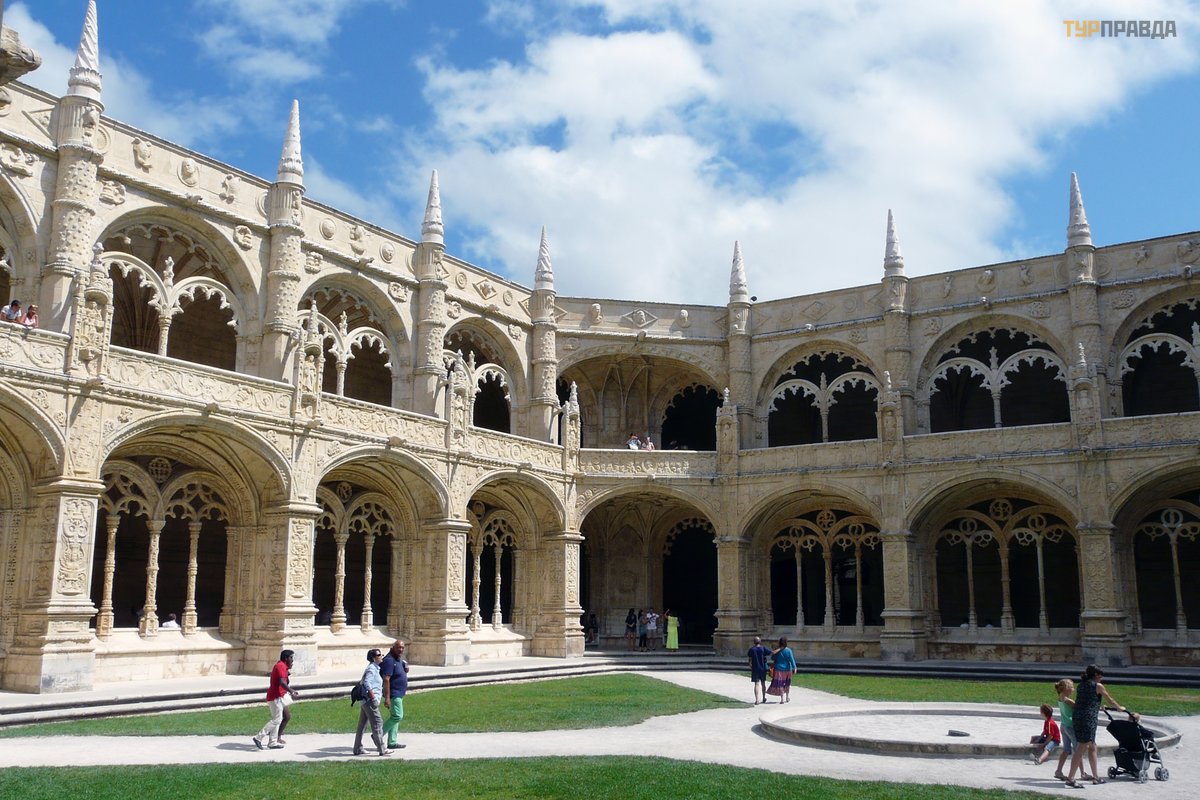 Монастырь Жеронимуш. Клуатр
Монастырь Жеронимуш. Клуатр
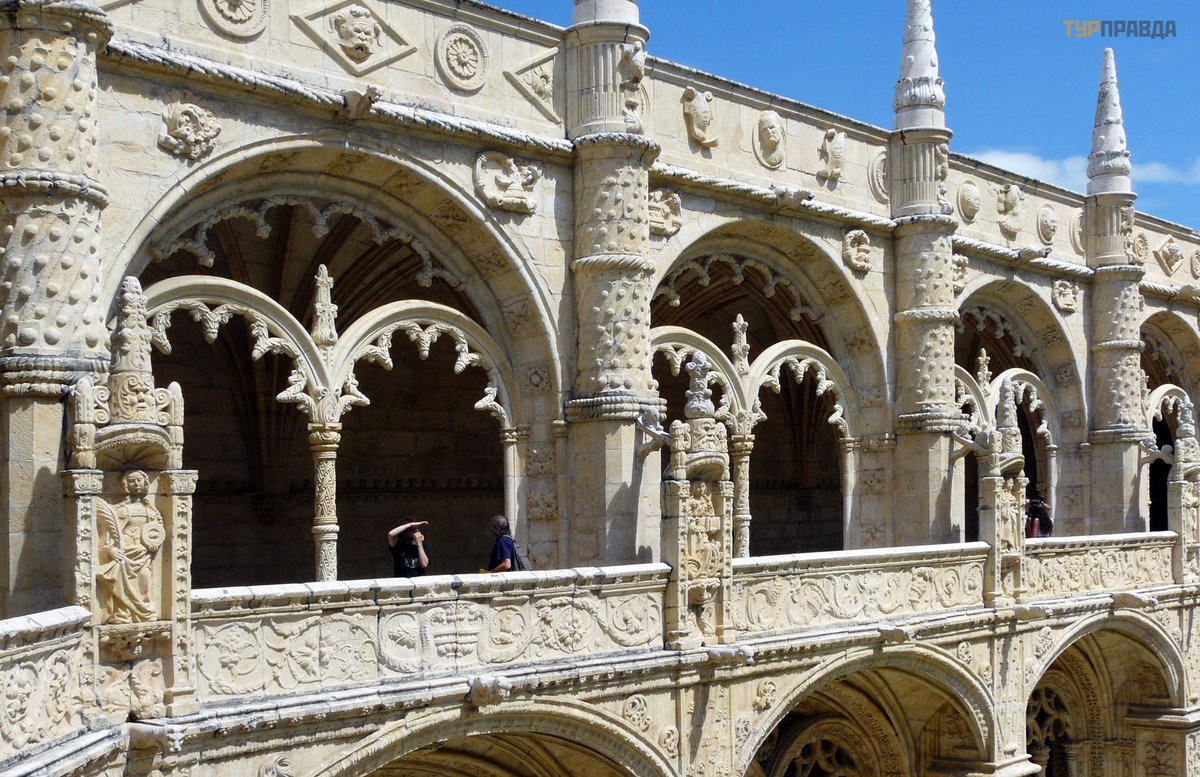 Монастырь Жеронимуш. Клуатр
Монастырь Жеронимуш. Клуатр
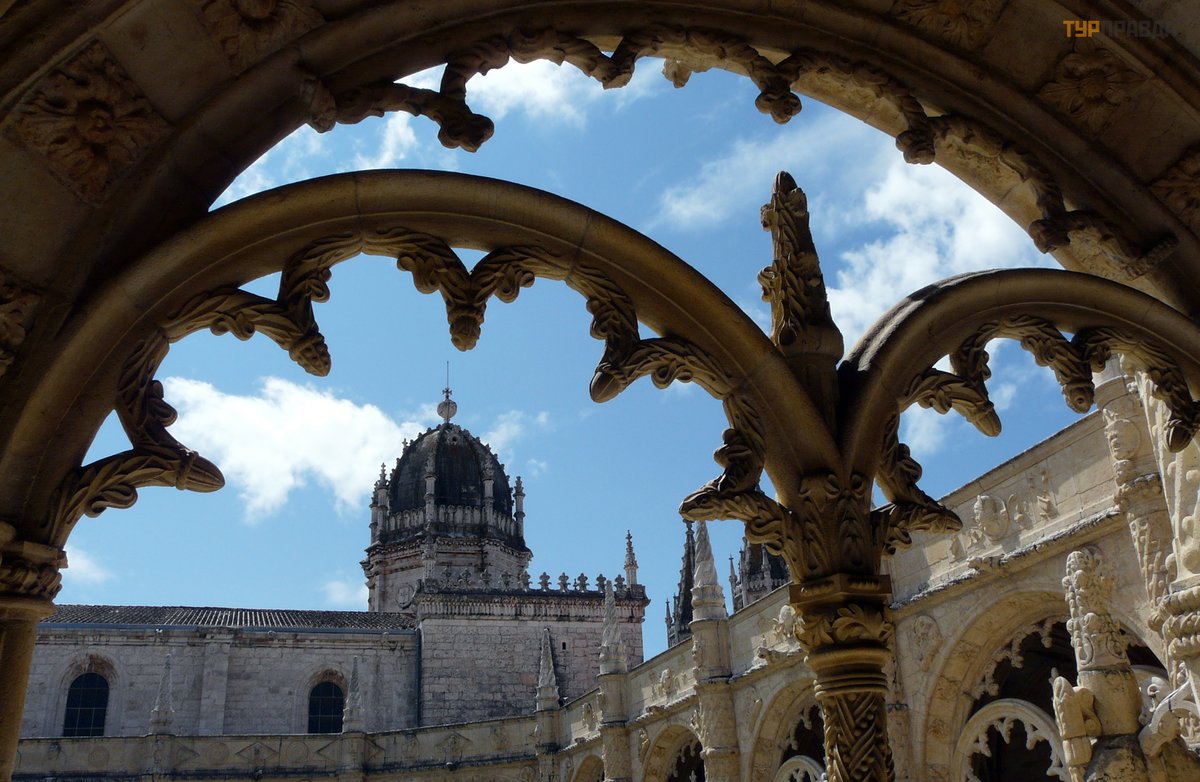 Монастырь Жеронимуш
Монастырь Жеронимуш
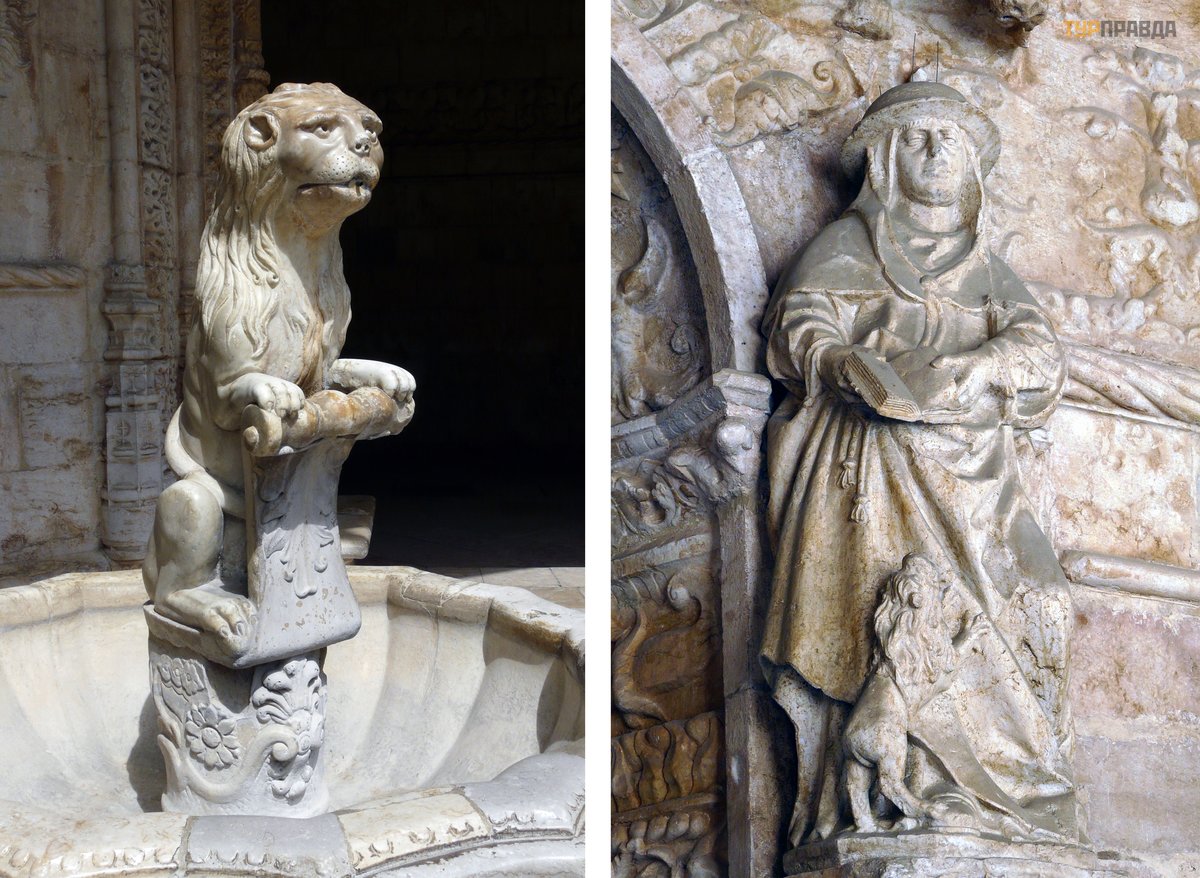 Монастырь Жеронимуш
Монастырь Жеронимуш
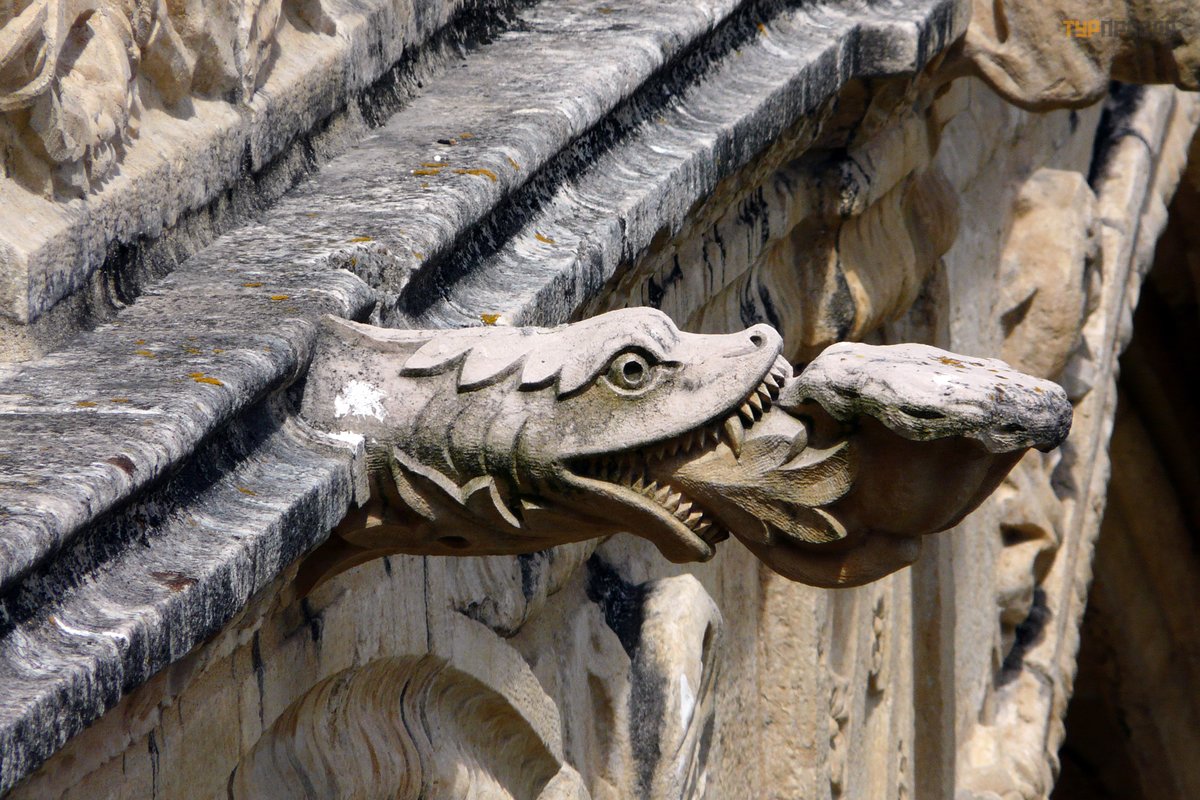 Монастырь Жеронимуш
Монастырь Жеронимуш
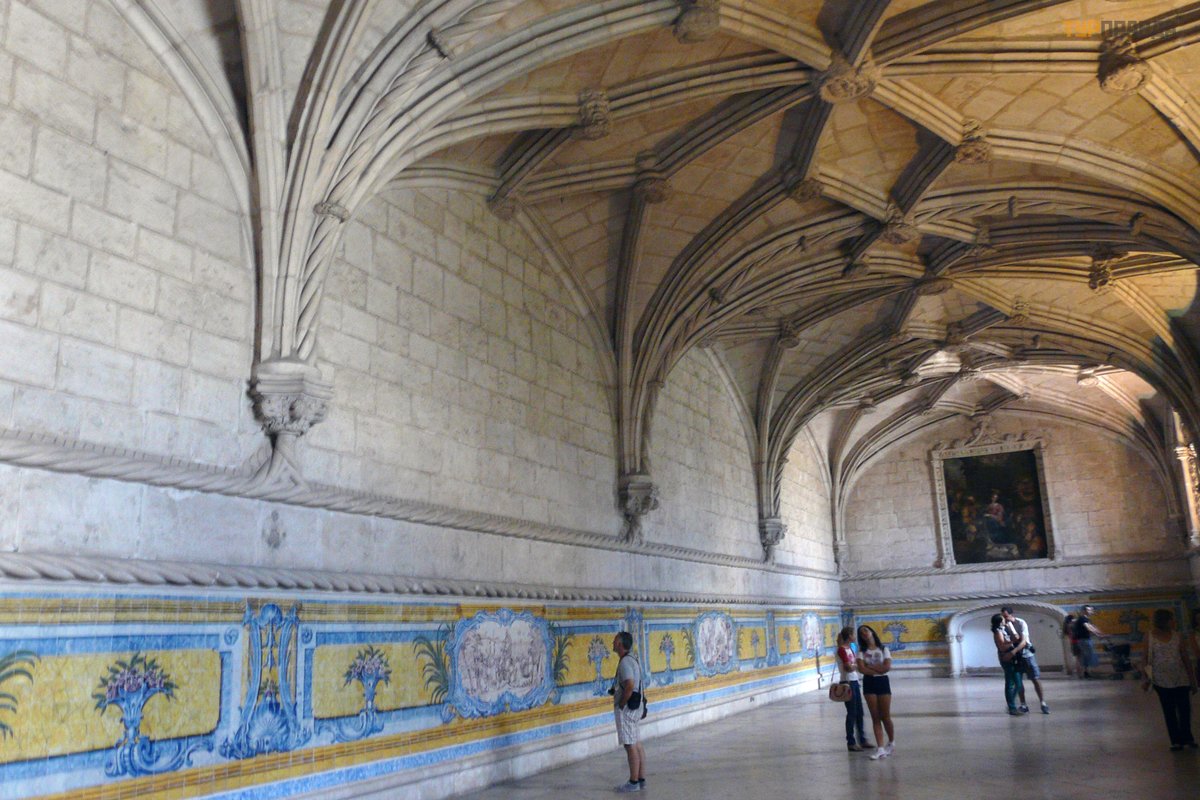 Монастырь Жеронимуш. Трапезная
Монастырь Жеронимуш. Трапезная
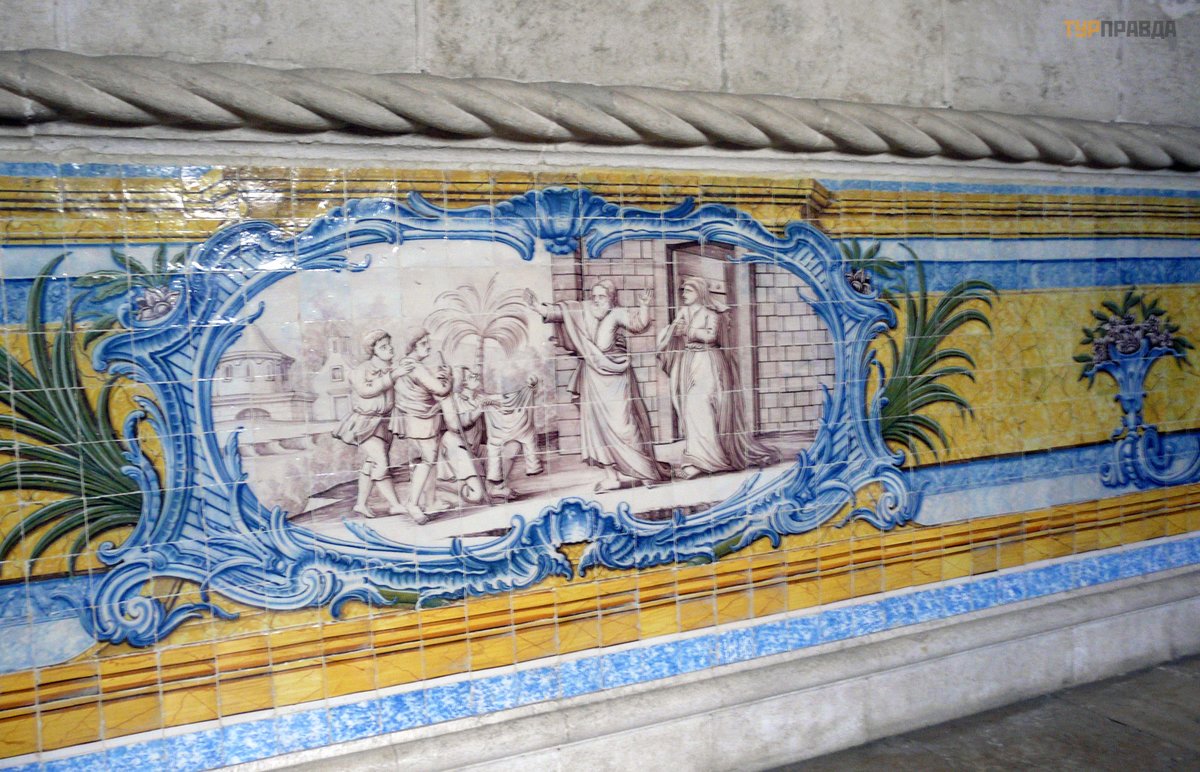 Монастырь Жеронимуш. Трапезная
Монастырь Жеронимуш. Трапезная
Внутри монастыря находятся гробницы Васко да Гама и поэта Луиса де Камоэнса, автора поэмы « Лузиады» , в которой тот прославляет триумф да Гамы и его товарищей. Так же здесь погребены короли Мануэль I и Жуан III, поэты Фернандо Пессоа и Алессандро Геркулано и другие великие личности, создававшие историю Португалии.

Гробница Васко да Гама, данный снимок из интернета
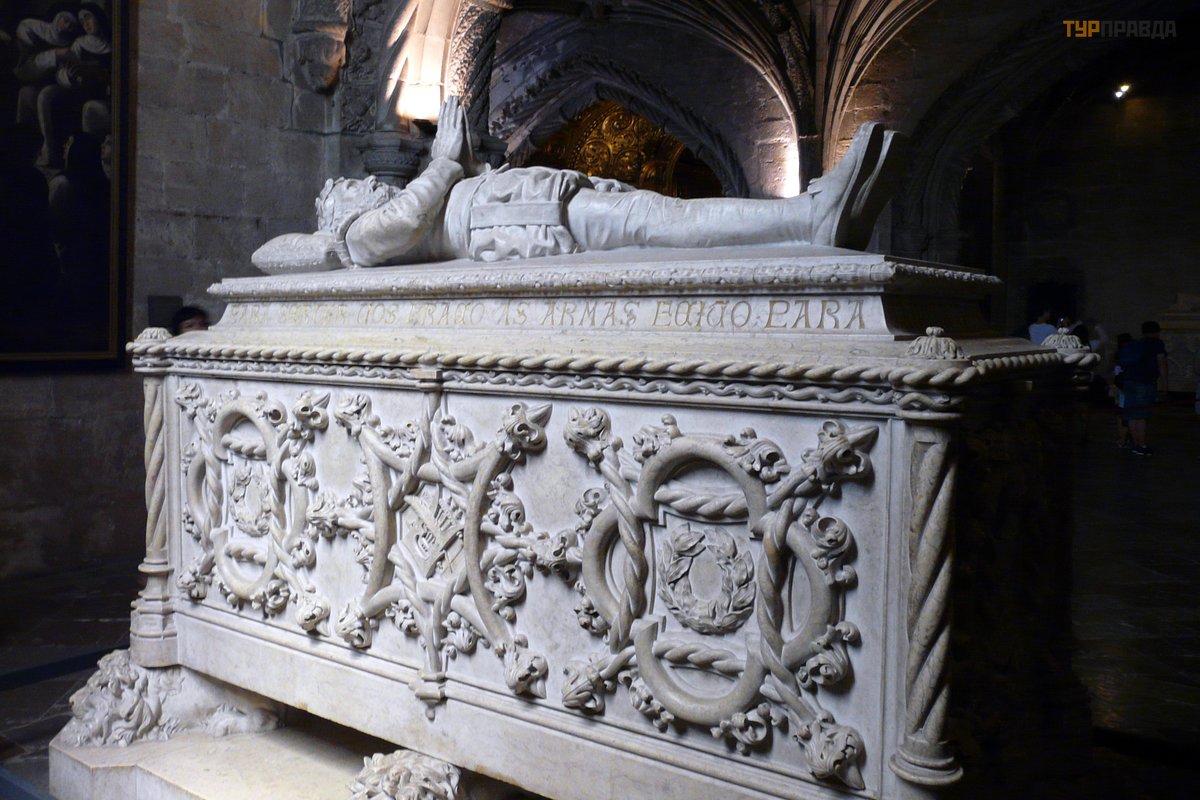 Монастырь Жеронимуш. Гробница Луиса Камоэнса
Монастырь Жеронимуш. Гробница Луиса Камоэнса
И вот тут случился казус – пытаясь найти вход в монастырскую церковь, мы заблудились. Несколько раз обошли все помещения вокруг монастырского дворика, поднялись на второй ярус, попали на балкон, выходящий в зал церкви и осмотрели ее « сверху» , но никак не могли найти основной вход. : ) Решили вернуться в центральному входу в монастырь, туда, где с улицы большая очередь желающих попасть : ), и сразу же справа обнаружили нужную дверь. : )
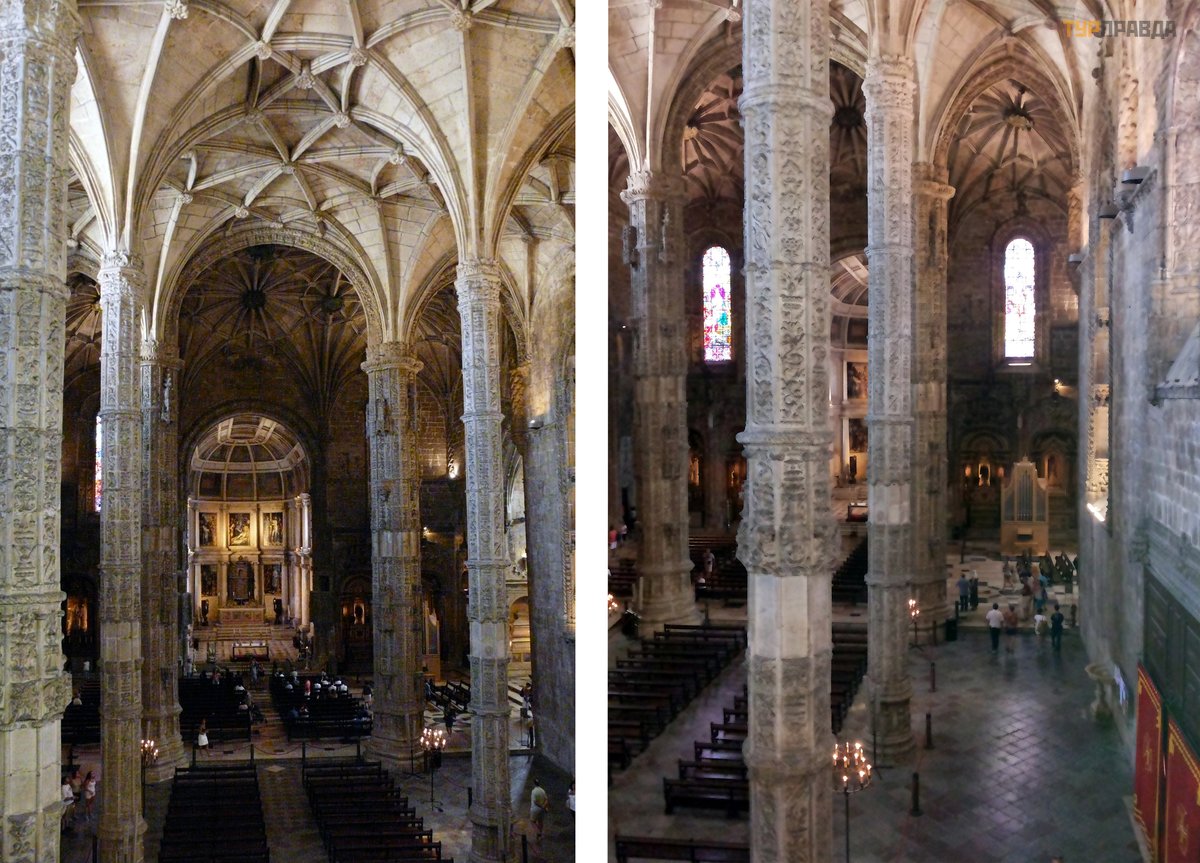 Монастырь Жеронимуш. Собор
Монастырь Жеронимуш. Собор
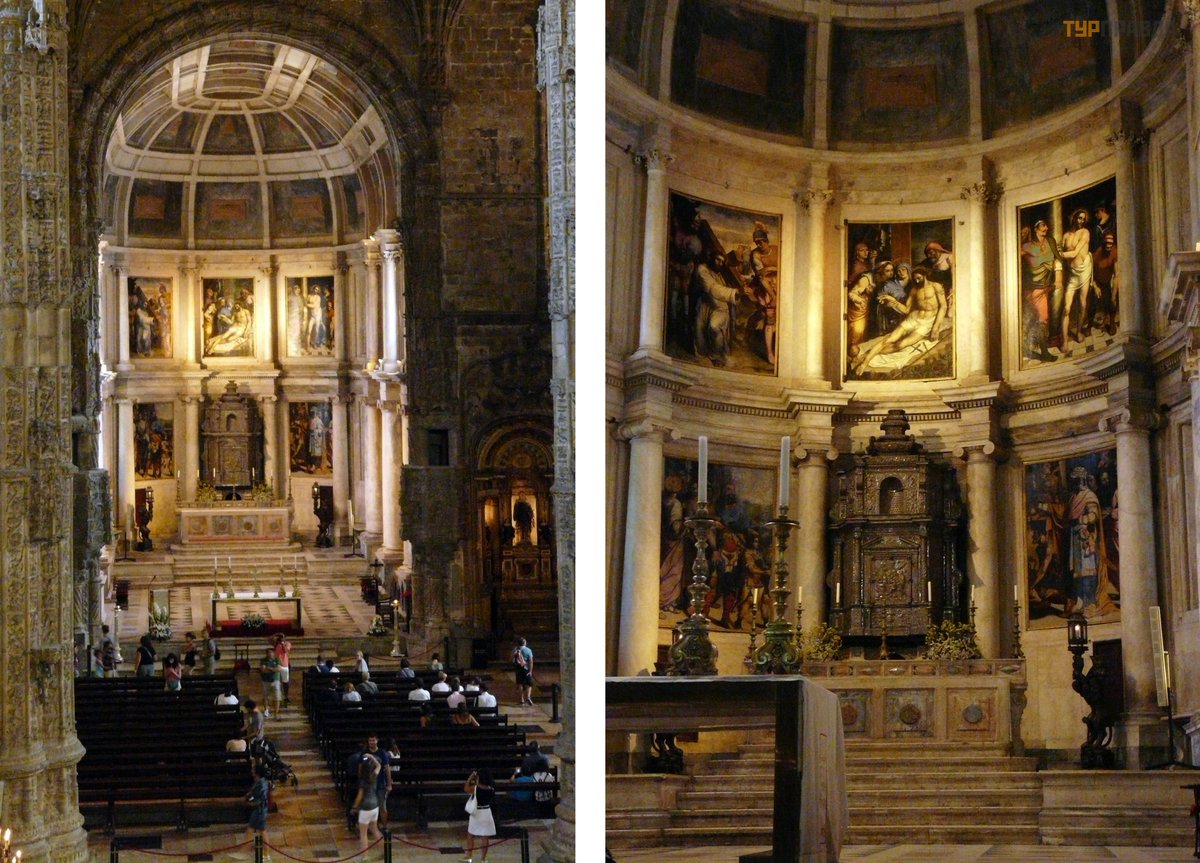 Монастырь Жеронимуш. Собор
Монастырь Жеронимуш. Собор
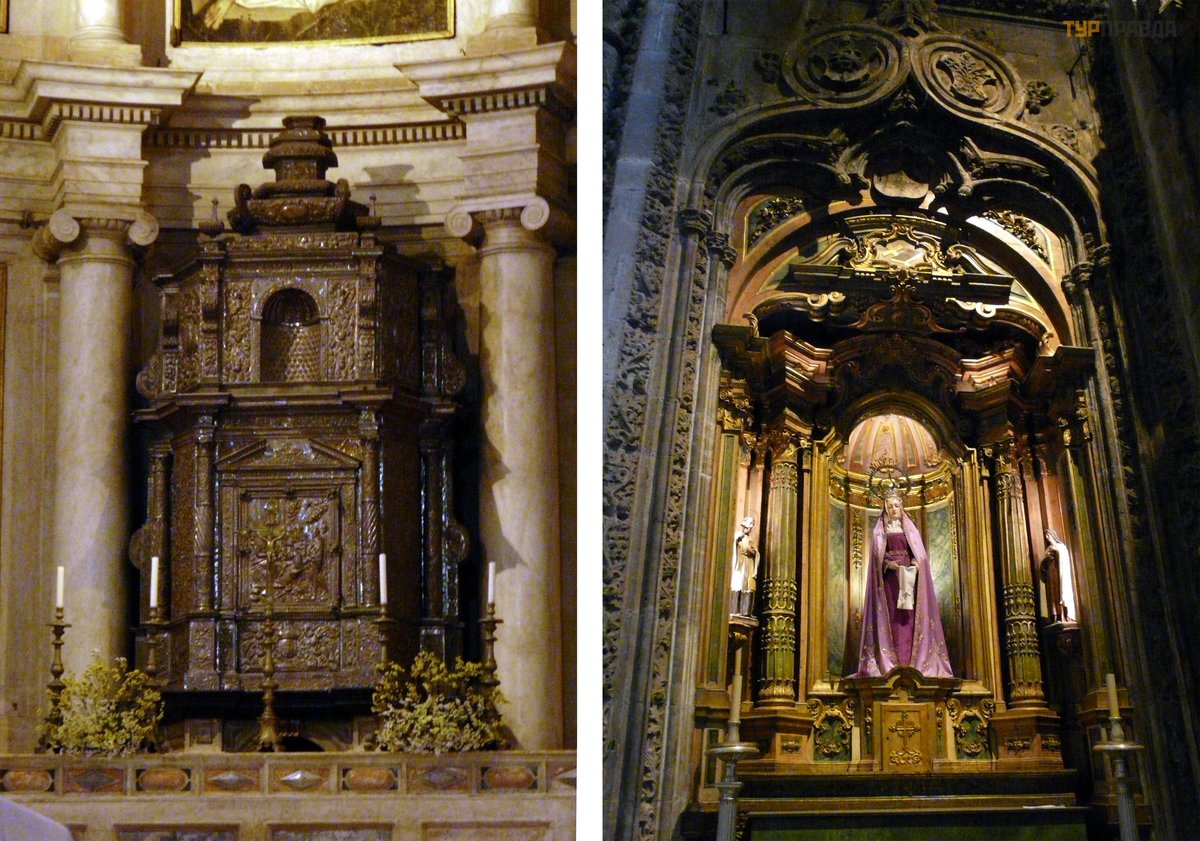 Монастырь Жеронимуш. Церковь
Монастырь Жеронимуш. Церковь
Церковь монастыря Жеронимуш знаменита своими порталами. Самым красивым считается южный портал на фасаде, протянувшемся вдоль реки. В центре портала – скульптура Богоматери с младенцем, держащая в руках вазу с дарами волхвов, по бокам от нее – фигуры пророков, апостолов, церковных деятелей и святых. Здесь представлены сцены из жизни святого Иеронима, чуть выше – герб Португалии. Внизу, между дверями церкви, – скульптура Генриха Мореплавателя с мечом, у ног которого застыли в схватке каменные львы.
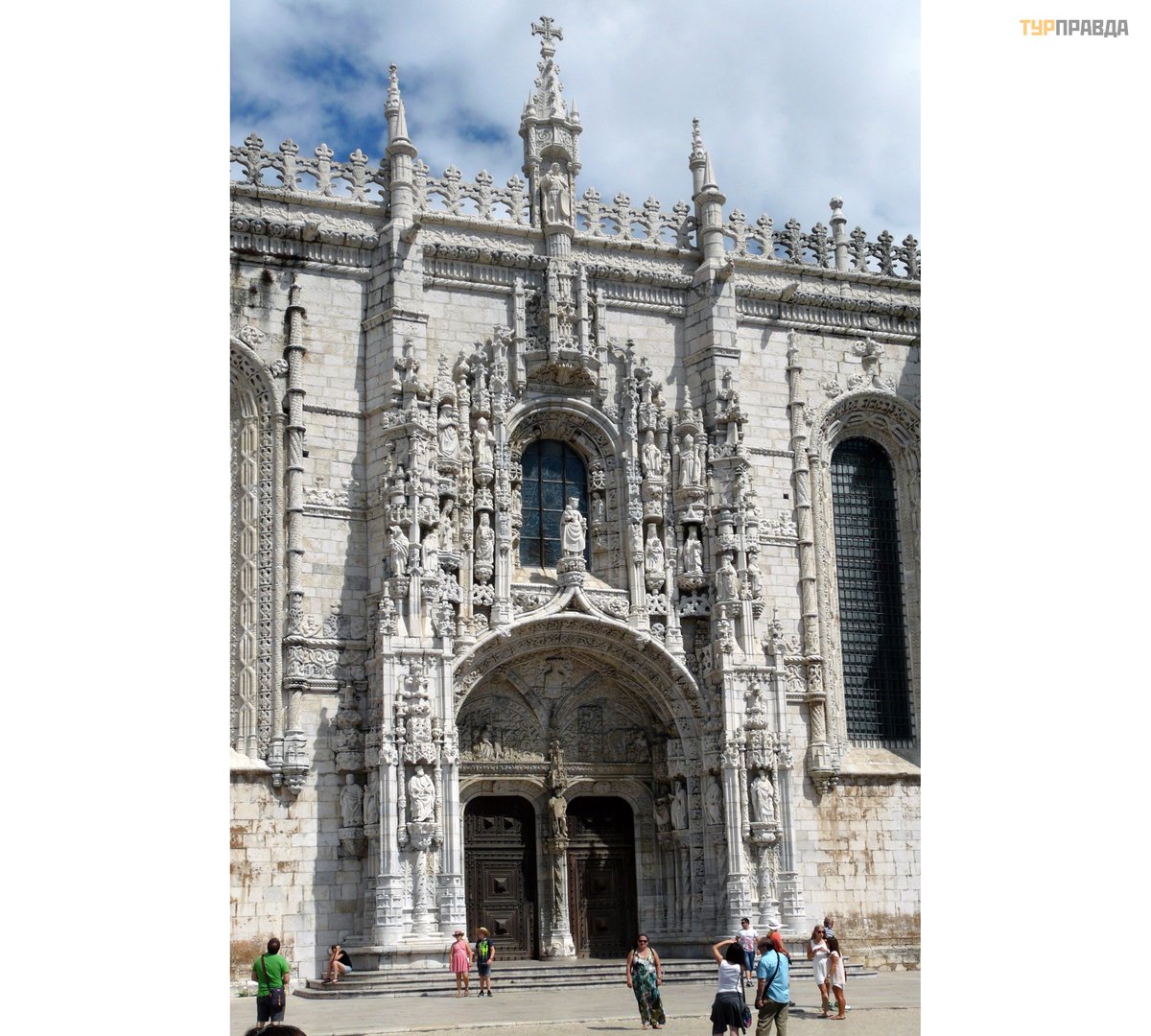 Монастырь Жеронимуш. Южный портал
Монастырь Жеронимуш. Южный портал
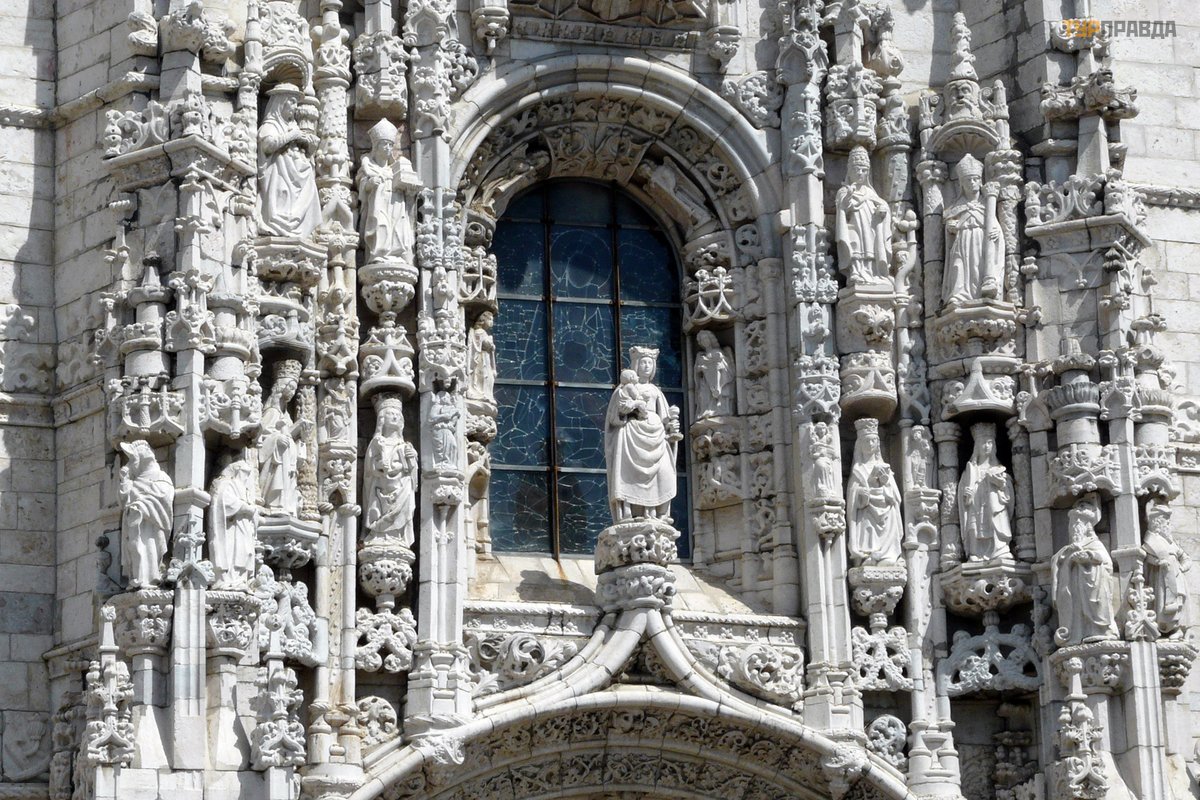 Монастырь Жеронимуш. Южный портал
Монастырь Жеронимуш. Южный портал
В западном крыле монастыря находится Национальный археологический музей и часть Морского музея. Официальный сайт: www. mosteirojeronimos. pt
Белемская башня и монастыре Жеронимуш – единственные большие памятники эпохи Великих географических открытий, уцелевшие в Лиссабоне во время землетрясения 1755г.
Выйдя из монастыря в полном восторге от увиденного, решили выпить кофе в кафе Pasteis de Belem, где, говорят, самые вкусные пирожные pasteis de nata (паштейш де ната). Да и как можно пройти мимо самого известного лиссабонского кафе, репутация которого неизменна с 1837 года, если оно и расположено рядом с Монастырем Жеронимуш? ? : )) Кроме кофе и паштейш взяли по кусочку пирога с разными начинками – время незаметно приблизилось к обеду. Присев в кафе за столик, познакомились с москвичами – обменялись впечатлениями о Португалии, расспросили их о Синтре, в которую мы собирались на следующий день.
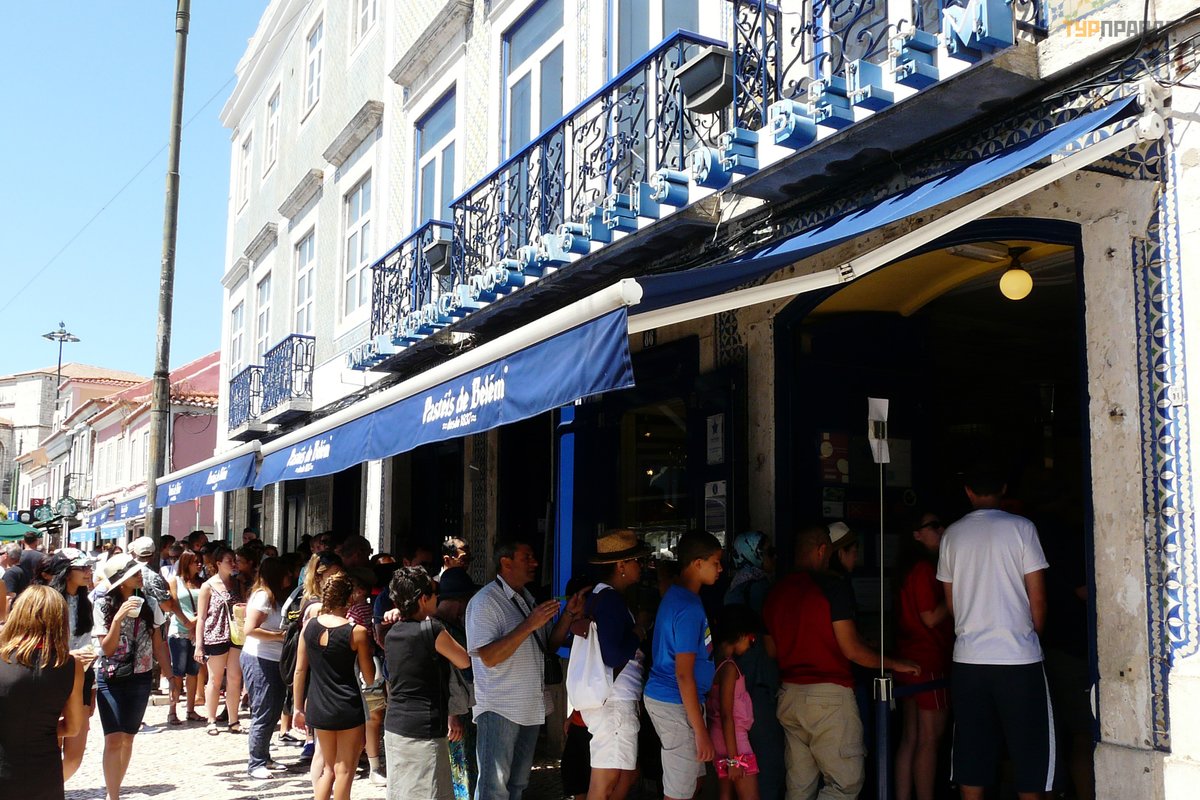 Лиссабон, кафе Pasteis de Belem. Очередь в кафе во второй половине дня
Лиссабон, кафе Pasteis de Belem. Очередь в кафе во второй половине дня
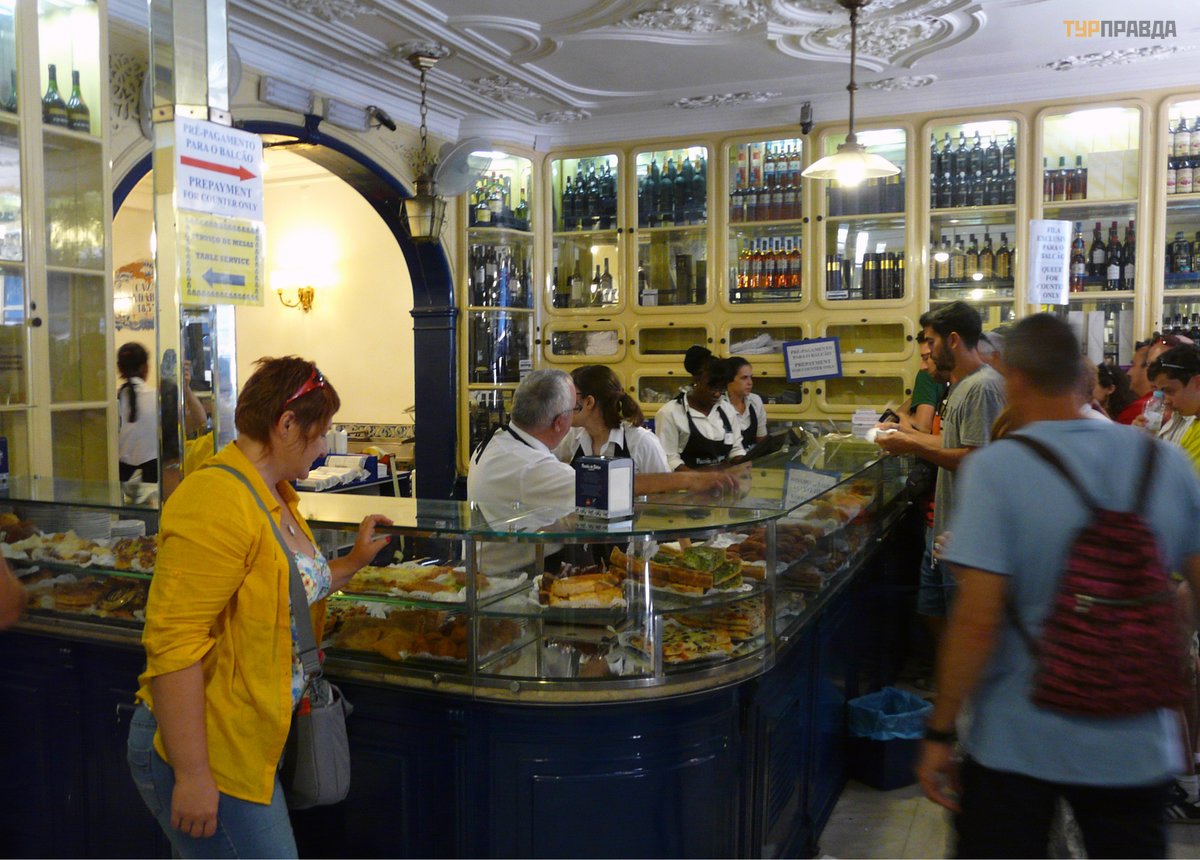 Лиссабон, кафе Pasteis de Belem
Лиссабон, кафе Pasteis de Belem
Как девочки, которые в детстве любили сказку о Золушке и мечтали хотя бы раз прокатиться в роскошном экипаже, пропустить музей карет, считающийся самым лучшим в мире, мы не могли. Тем более, что находится он чуть далее по той же улице, что и монастырь иеронимитов. : )
Национальный музей карет (Museu Nacional dos Coches) расположен в здании бывшей школы верховой езды при королевском дворце, который ныне стал резиденцией президента Португалии.
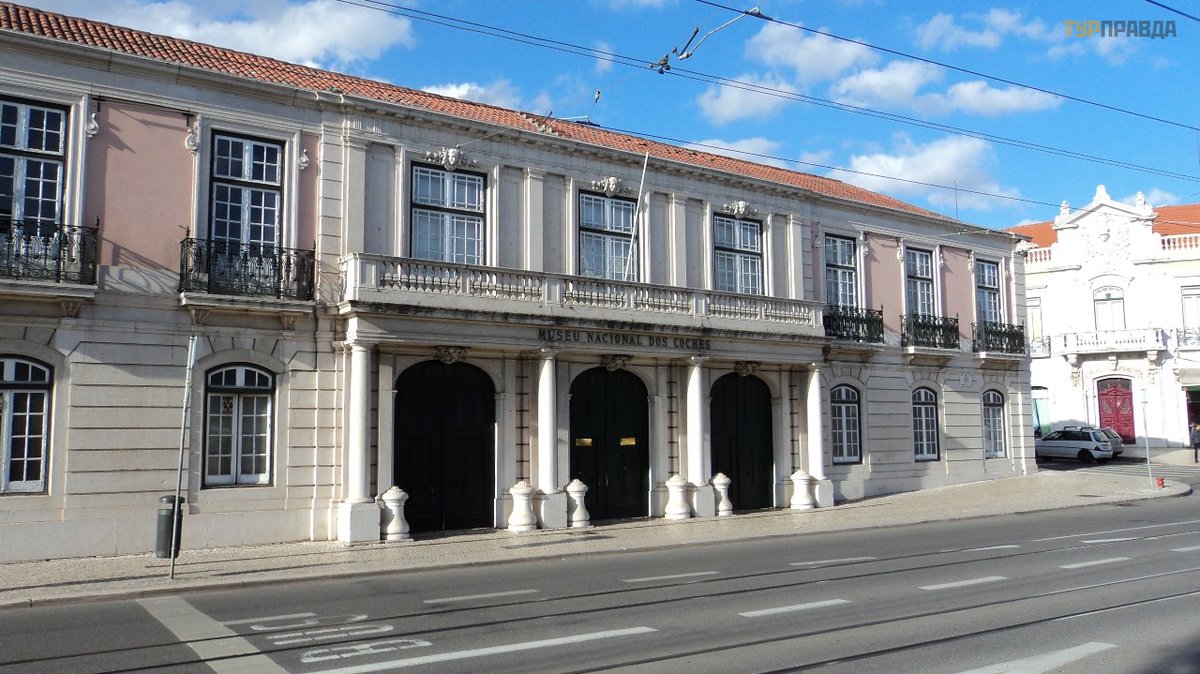 Лиссабон. Национальный музей карет. (снимок из интернета)
Лиссабон. Национальный музей карет. (снимок из интернета)
Чтобы сохранить реквизит португальского королевского двора, королева Амелия в 1905 решила создать в здании королевского манежа музей карет. Большинство карет принадлежало португальской королевской семье. Но в коллекции имеются и кареты посольств, и кареты, когда-то принадлежавшие Папе – главе католической церкви.
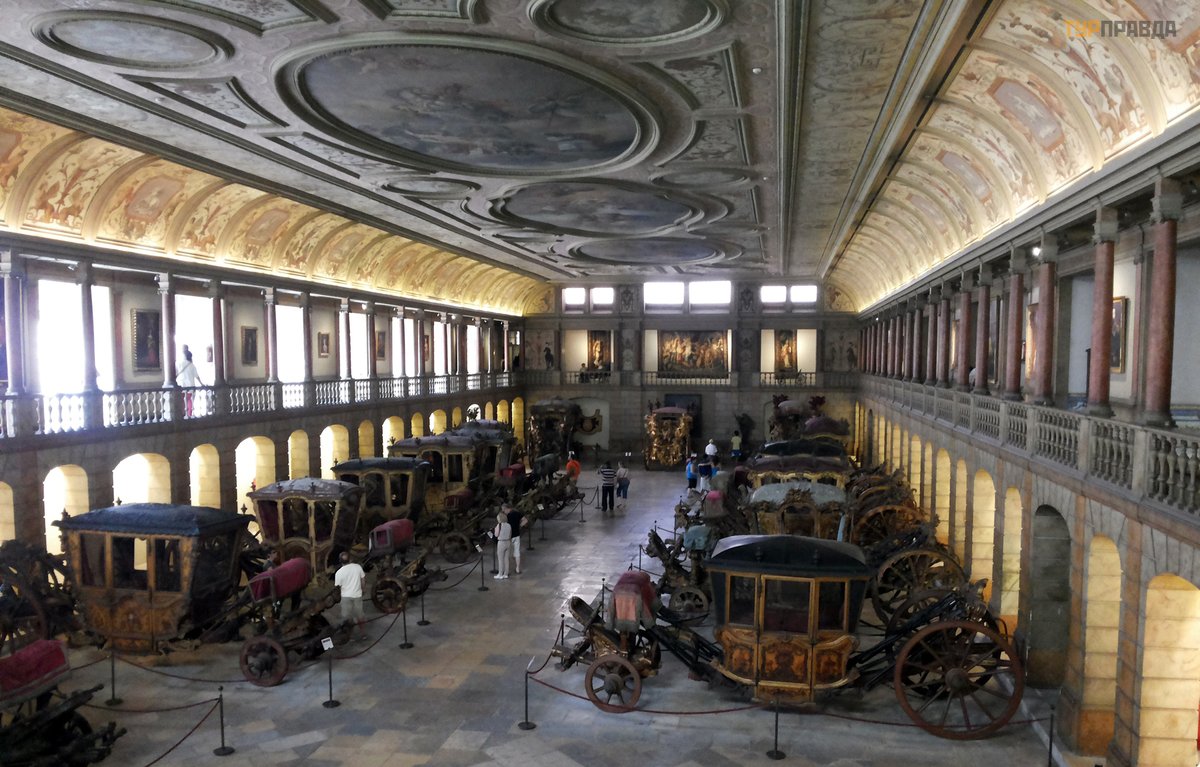 Лиссабон. Национальный музей карет
Лиссабон. Национальный музей карет
Коллекция музея считается одной из самых уникальных коллекций в мире – в ней собраны экипажи, изготовленные в Португалии, Италии, Австрии, Испании и Франции. Кроме карет здесь представлены кабриолеты, ландо, портшезы, шарабаны, фаэтоны и детские повозки, в которых запрягались пони, и др.
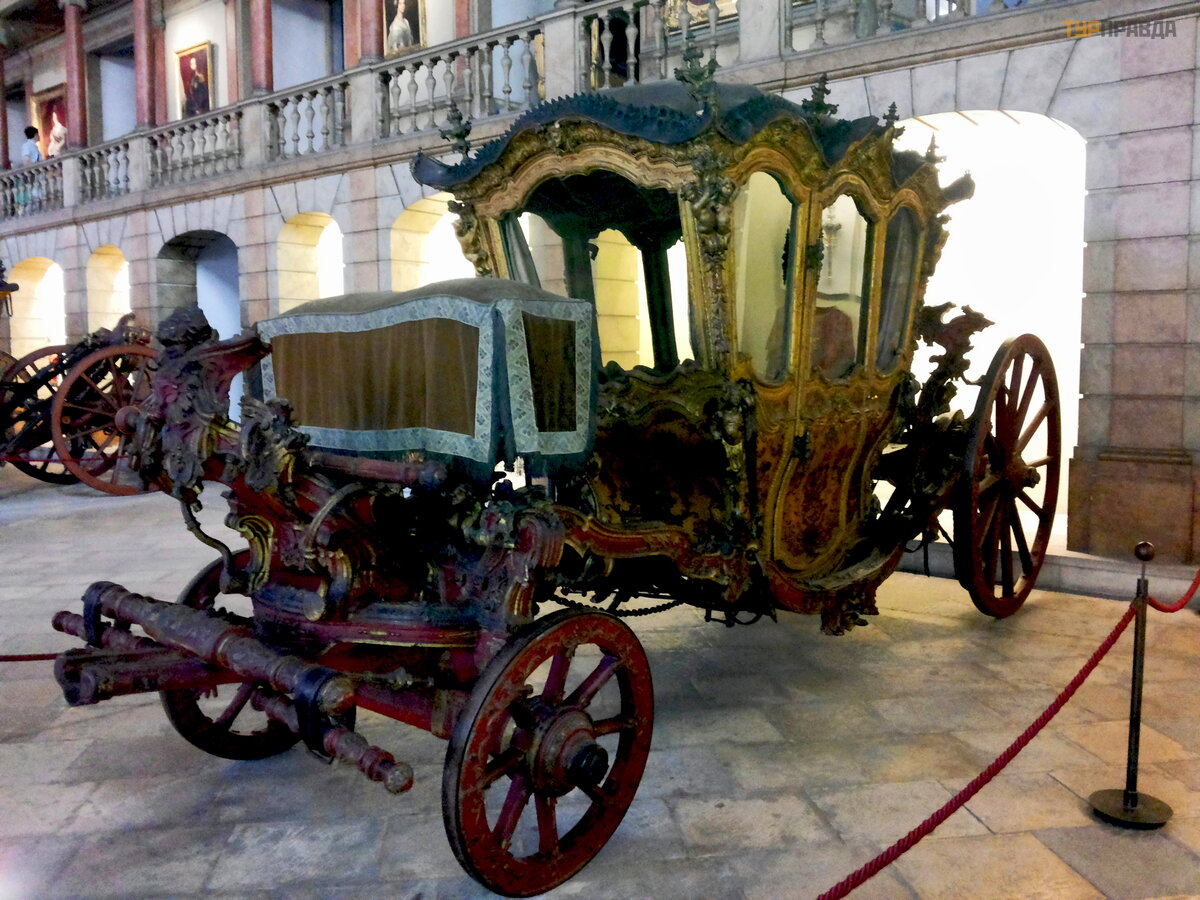
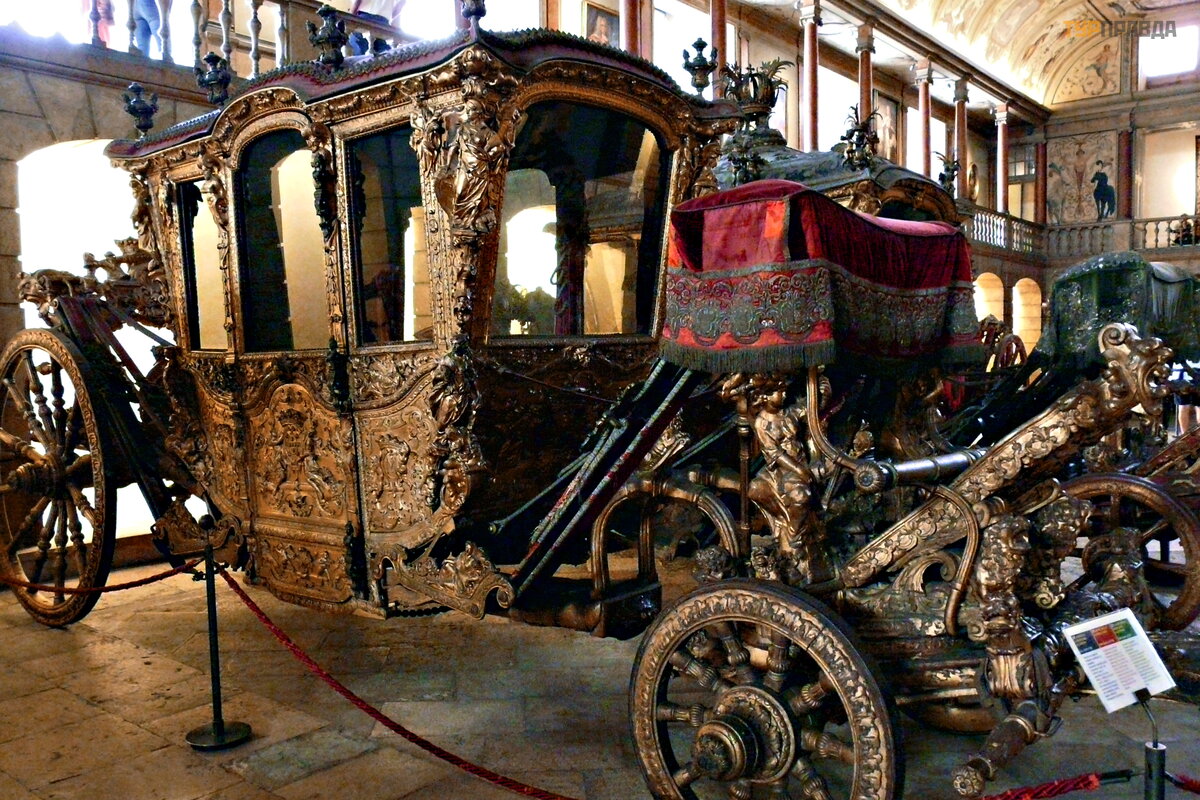
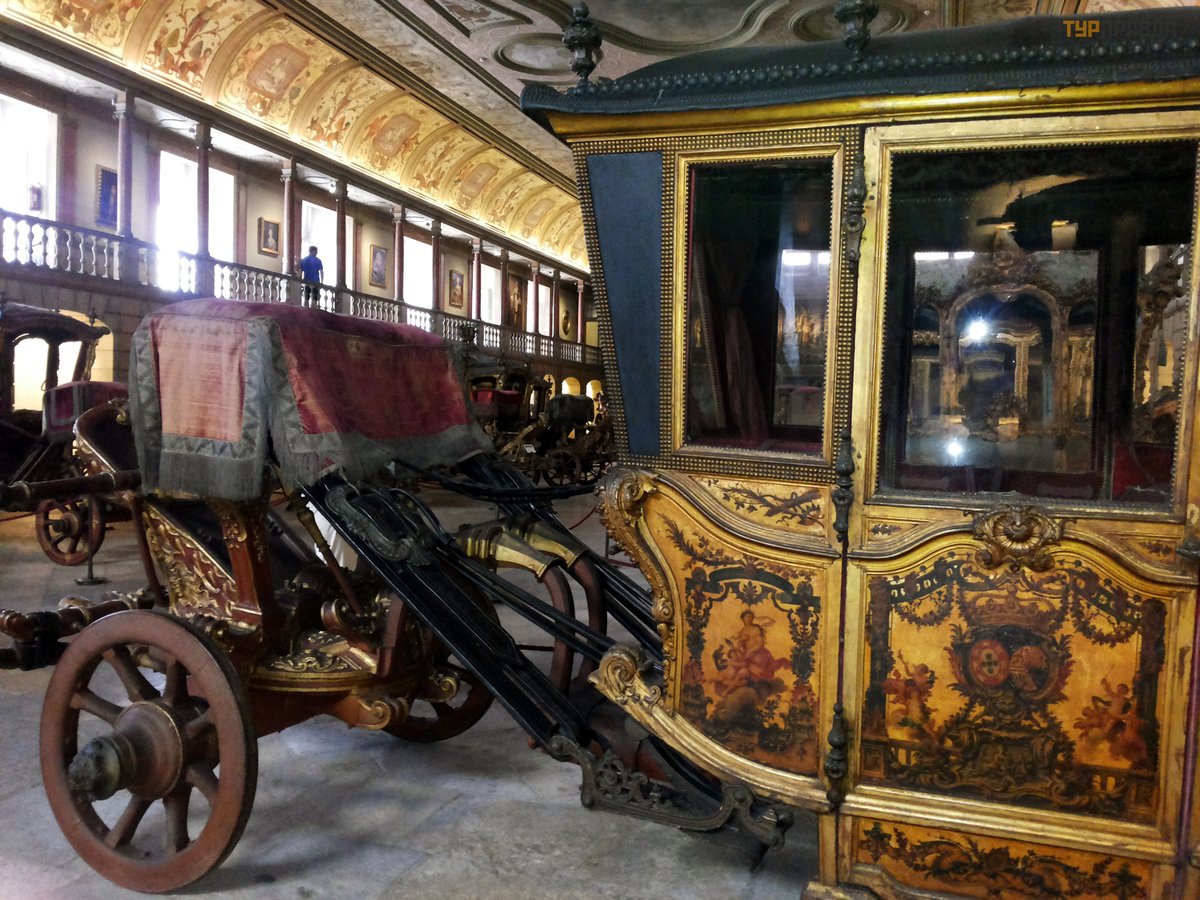
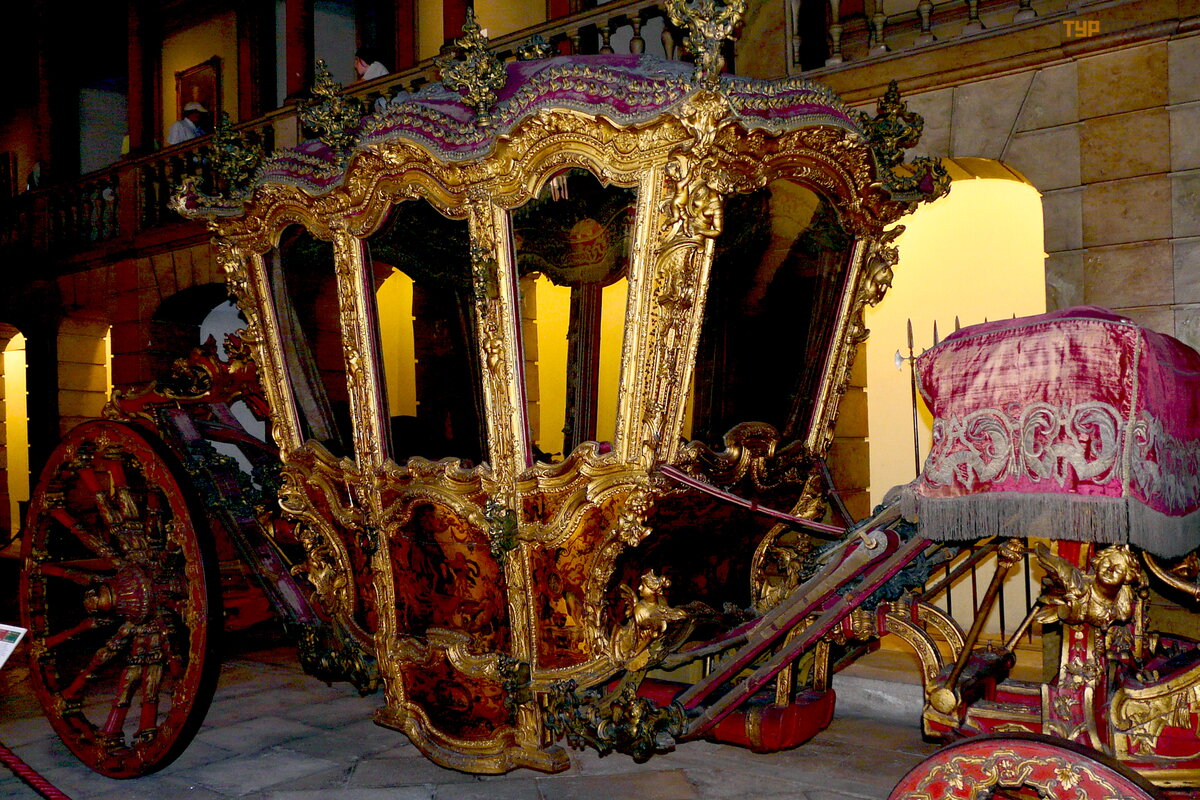
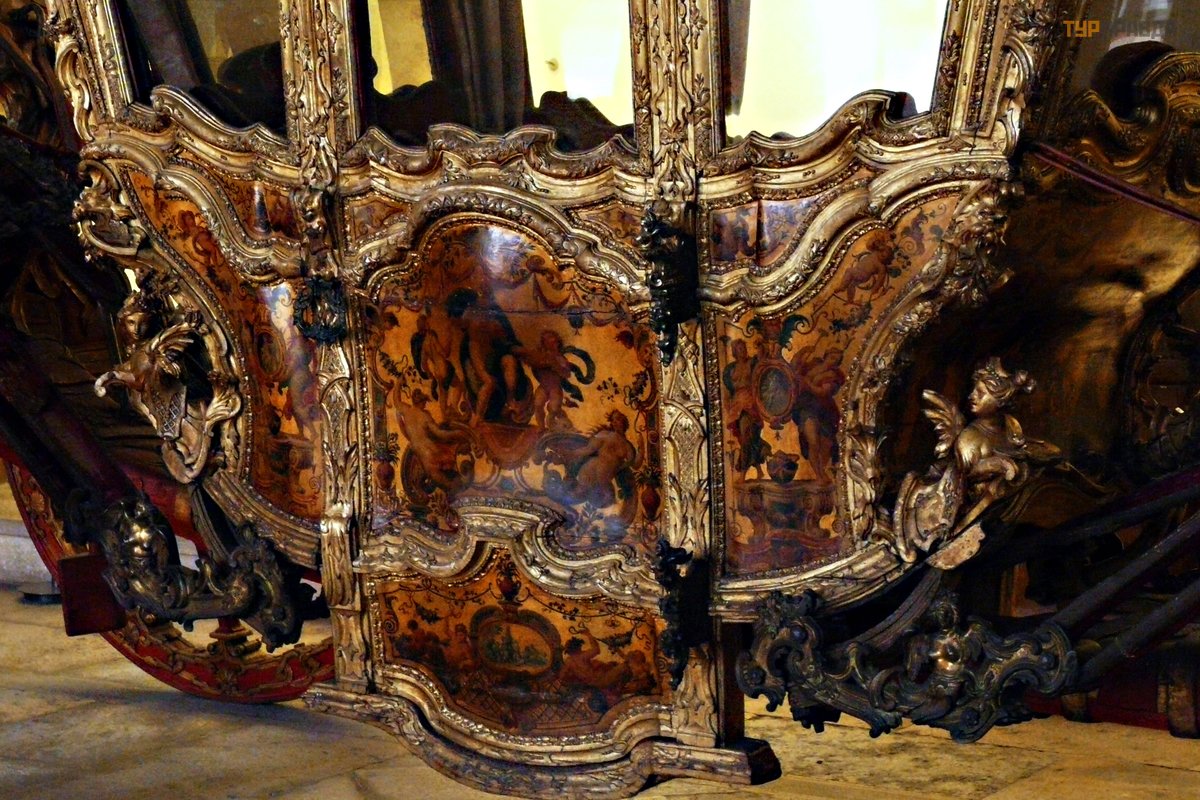
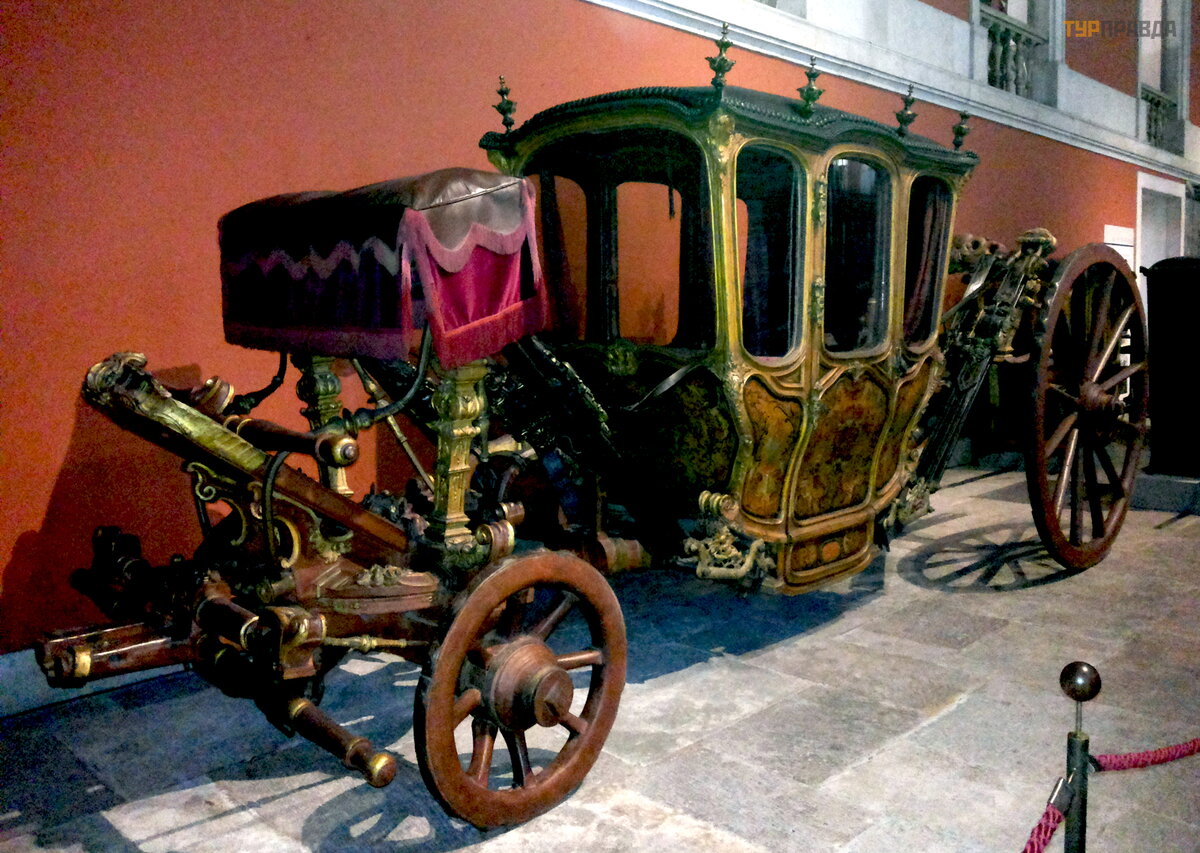
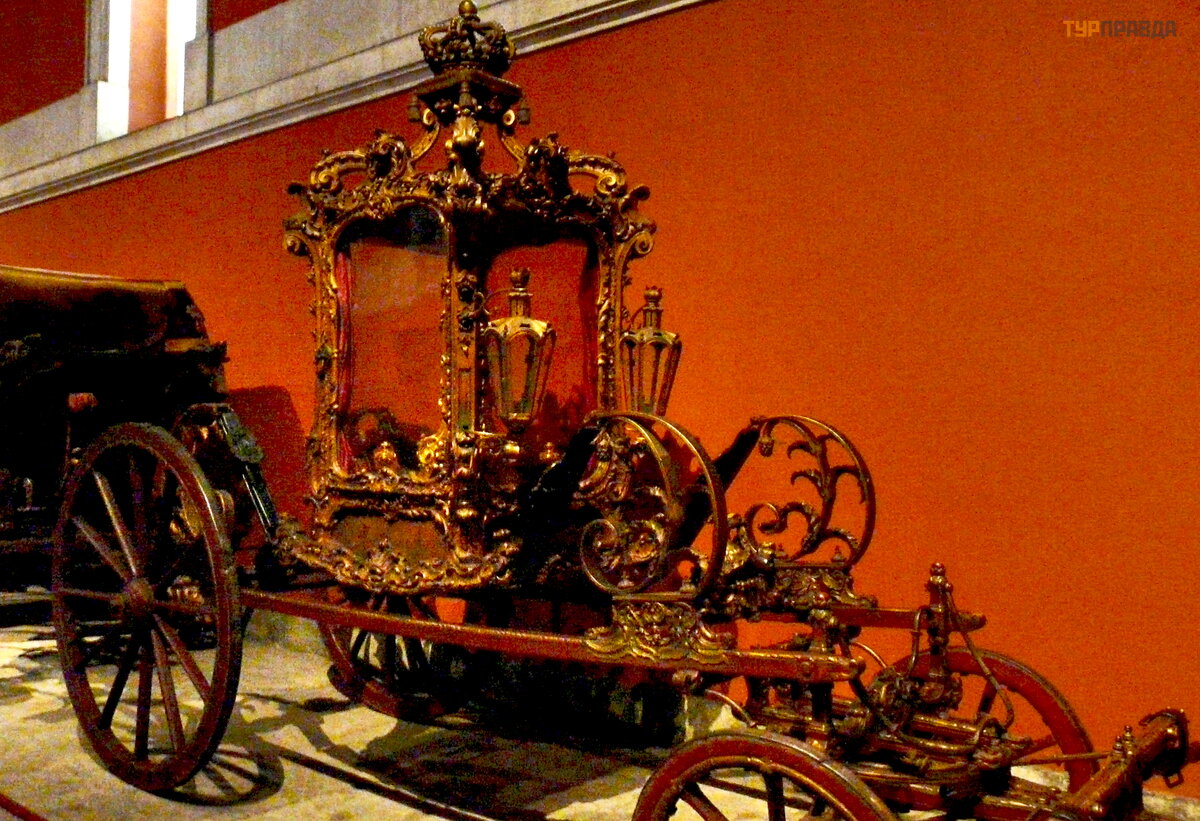
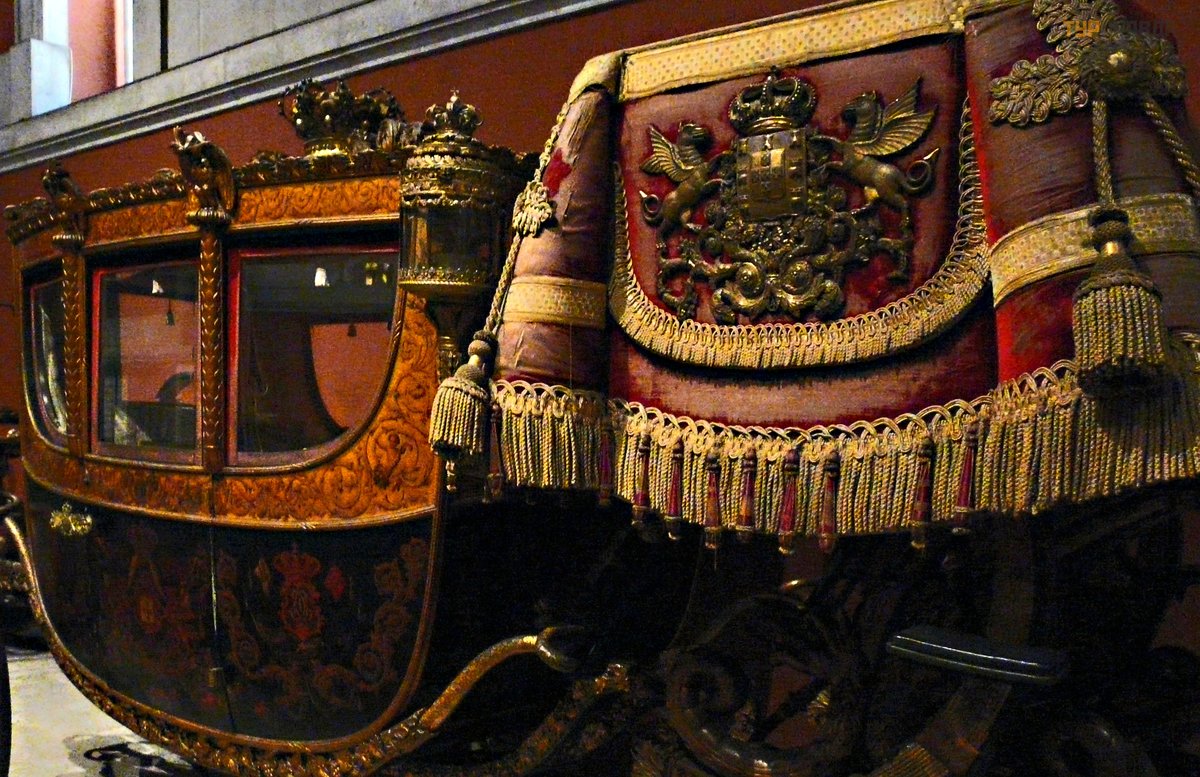
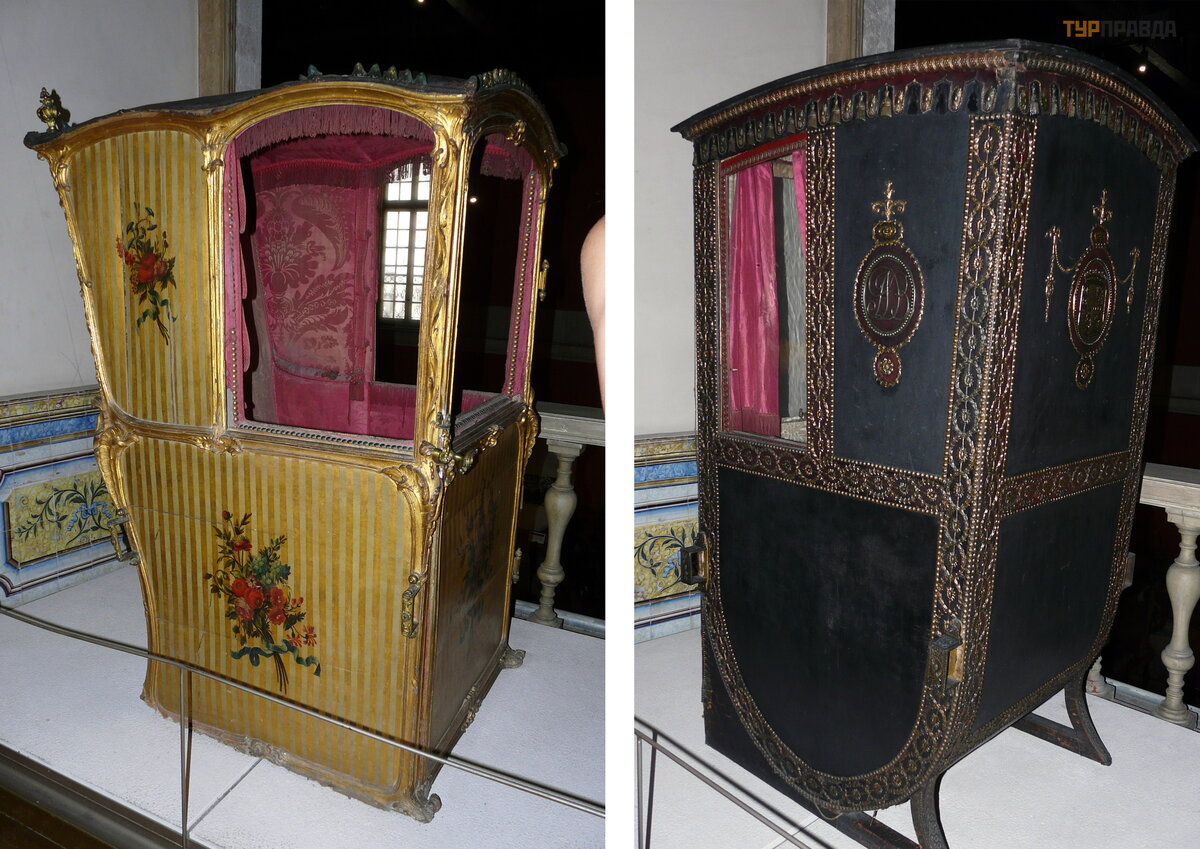
Самый старый и самый ценный экспонат коллекции, датируемый концом XVI – началом XVII века, – карета короля Испании Филиппа II, на которой он приезжал в Португалию в 1619 г. Карета не только самая старинная, но и самая скромная. Менялась мода – изменялось и оформление экипажа. С течением времени кареты становились все роскошнее и изысканнее, появилась отделка из бархата, позолоты и красного дерева, их начали украшать статуями и канделябрами.
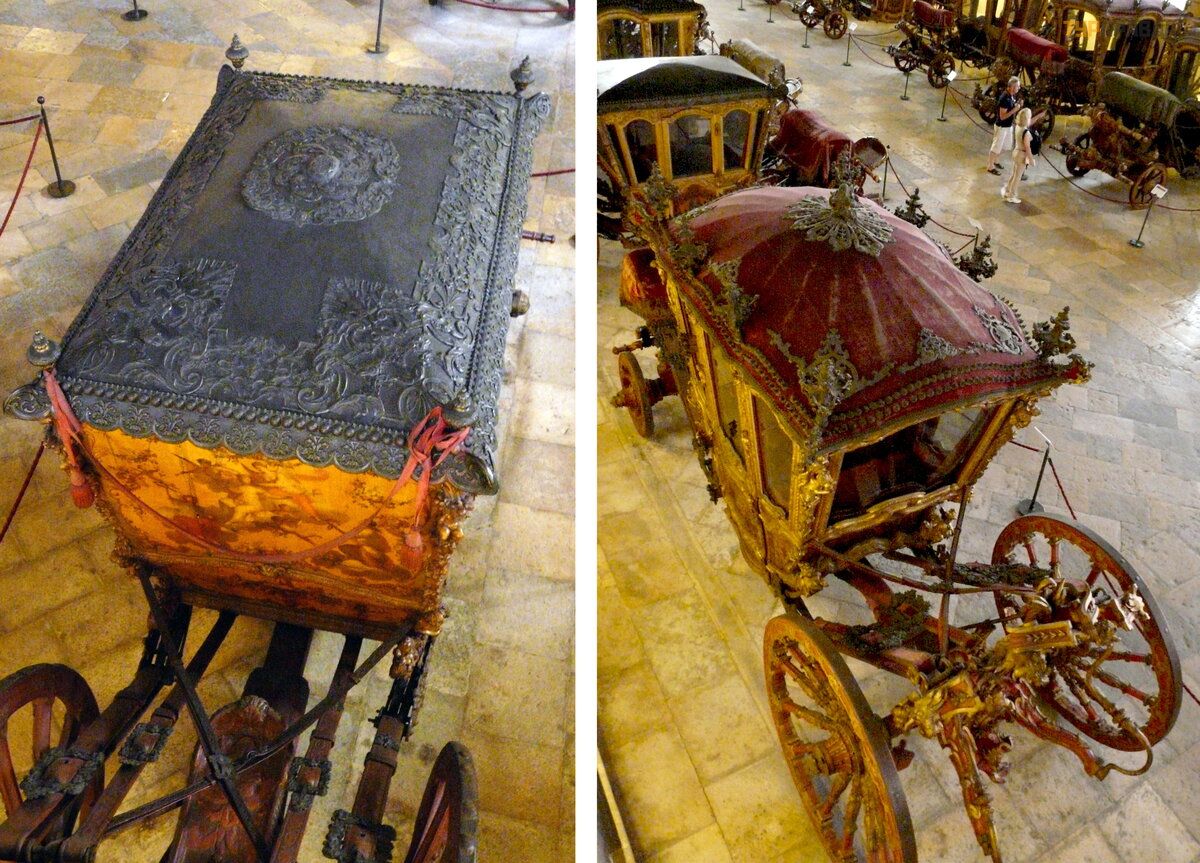

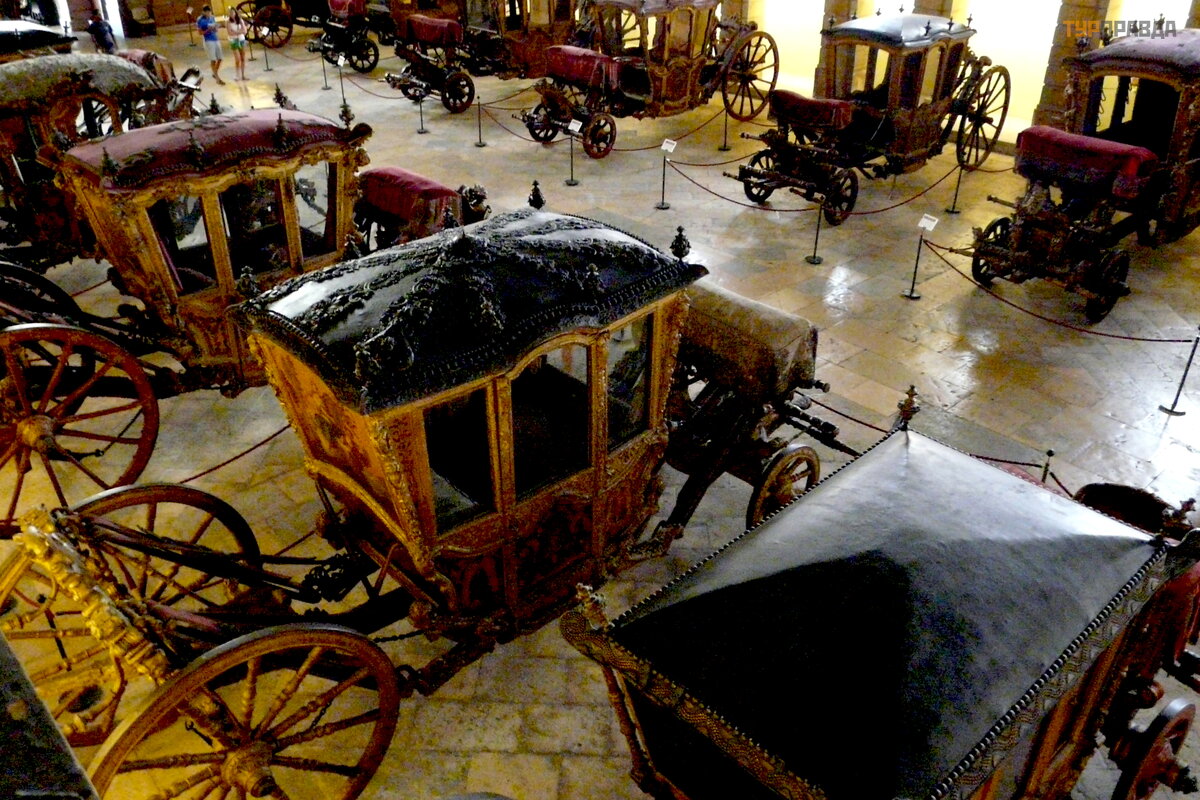
В конце зала стоят три огромные барочные кареты, изготовленные в Риме для посла Португалии в Ватикане: в 1716 году король Жоао V отправил большое посольство в Ватикан. К тому моменту лучшие времена португальской империи были уже позади, но тщеславному монарху хотелось пустить пыль в глаза Папе Римскому и продемонстрировать, что и на краю Европы живут не « Бог знает кто» . Для этого в Риме было заказано пять роскошных карет, выполненных по эскизам португальских художников, три из которых сохранилась до наших дней.
Они выделяются особенно роскошной отделкой и украшениями в виде позолоченных статуй, выполненных в рост человека. Есть легенда, что впоследствии многие годы ни один европейский монарх не решался отправить послов в Рим, чтобы не подвергнуться невыгодному сравнению с великолепием португальской депутации.
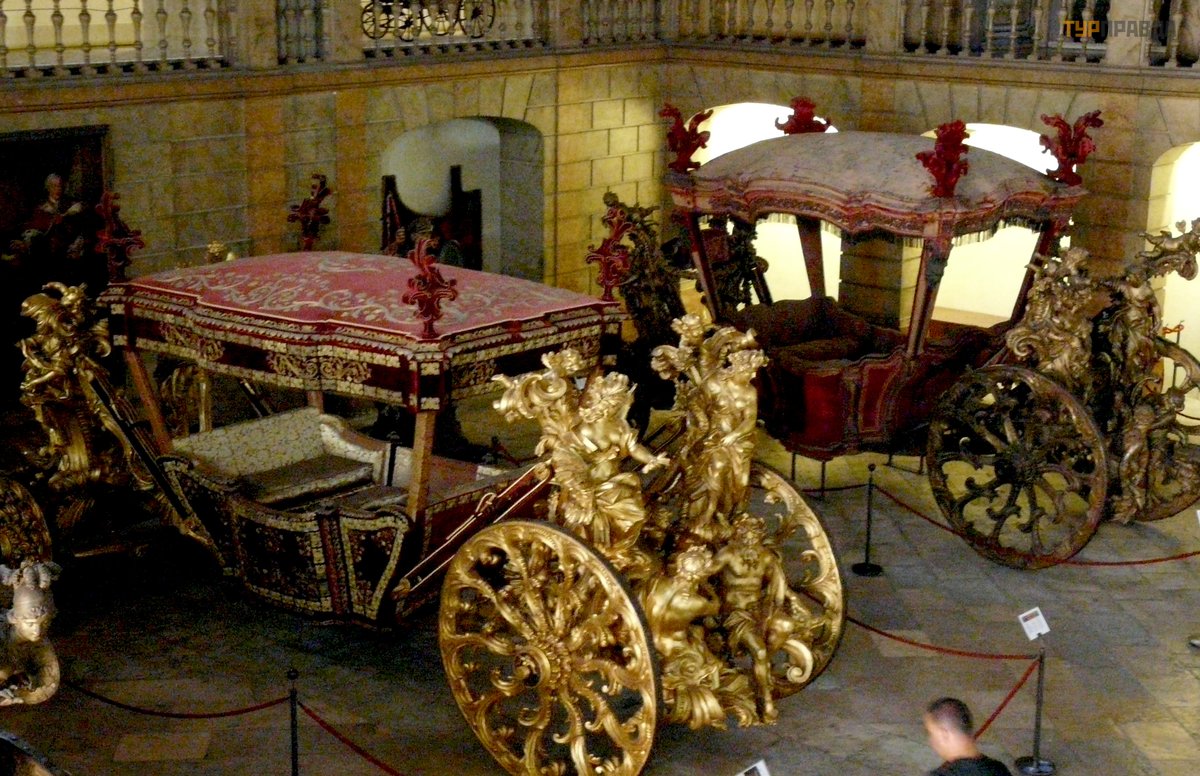
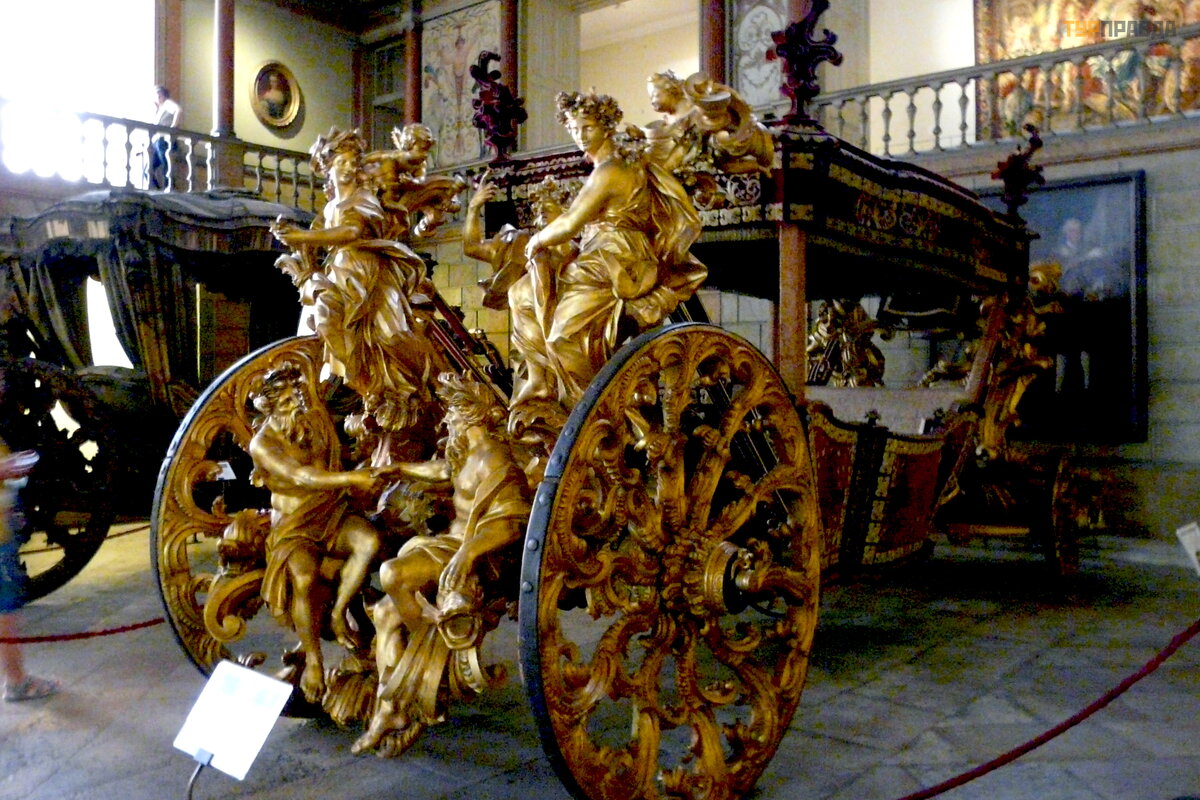
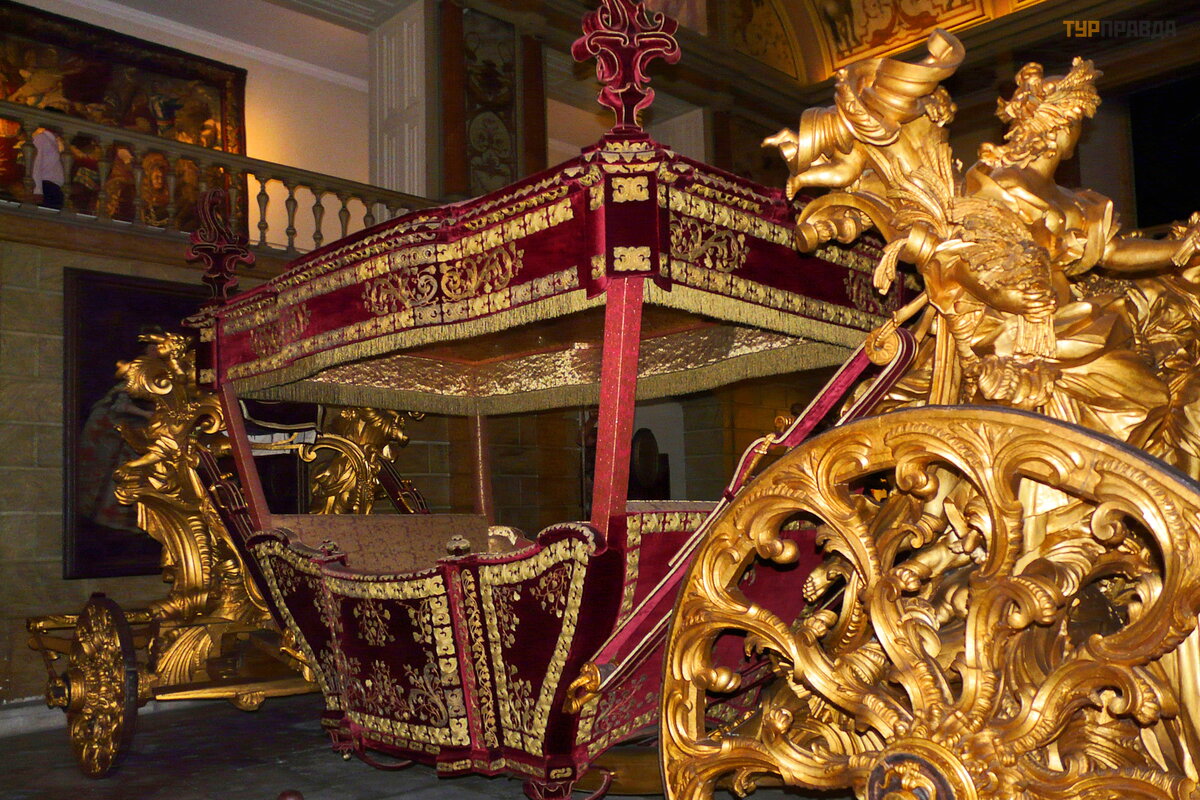
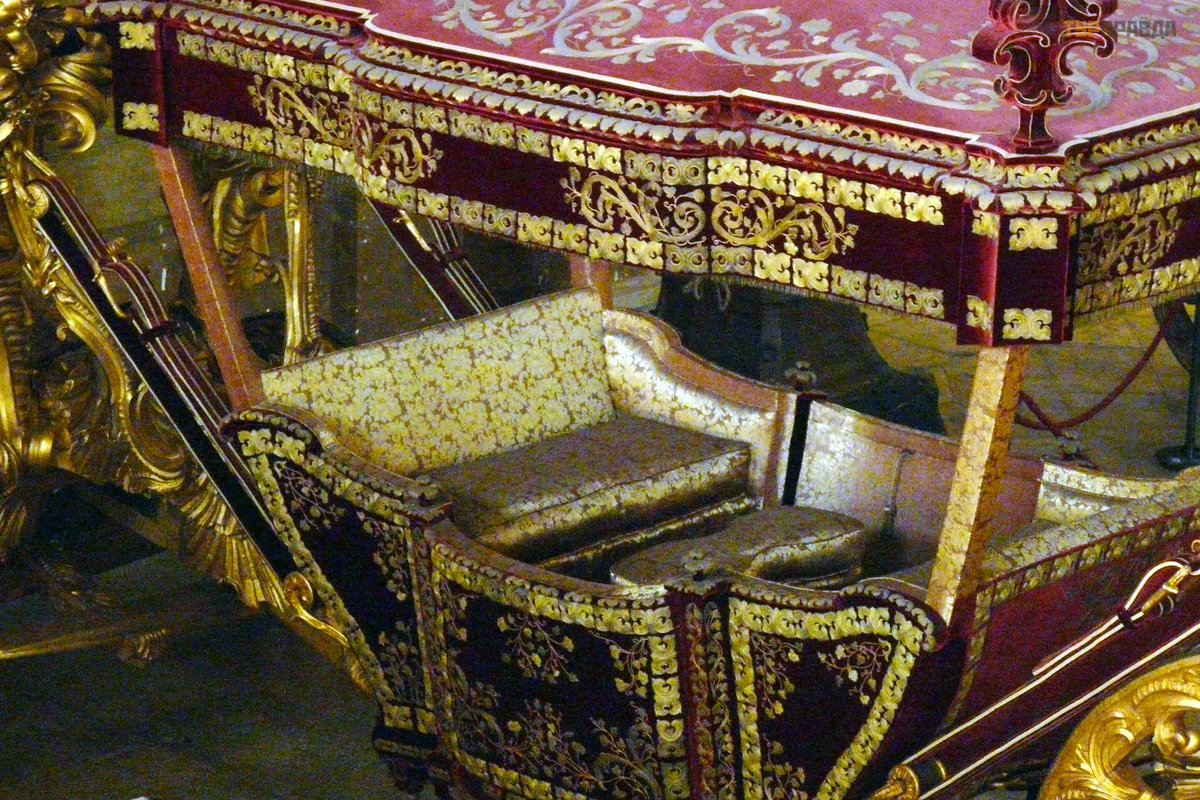
В верхней части манежа находились трибуны, связанные узкими галереями, а по обоим концам здания располагались балконы для судей и королевской семьи, откуда они наблюдали за состязаниями. Ныне в верхней части зала представлены детски коляски, повозки для пони, шарабаны, ландо, а также различные замысловатые аксессуары для конных прогулок – шпоры, седла, сбруя и форменная одежда. Стены украшены портретами членов королевской семьи.
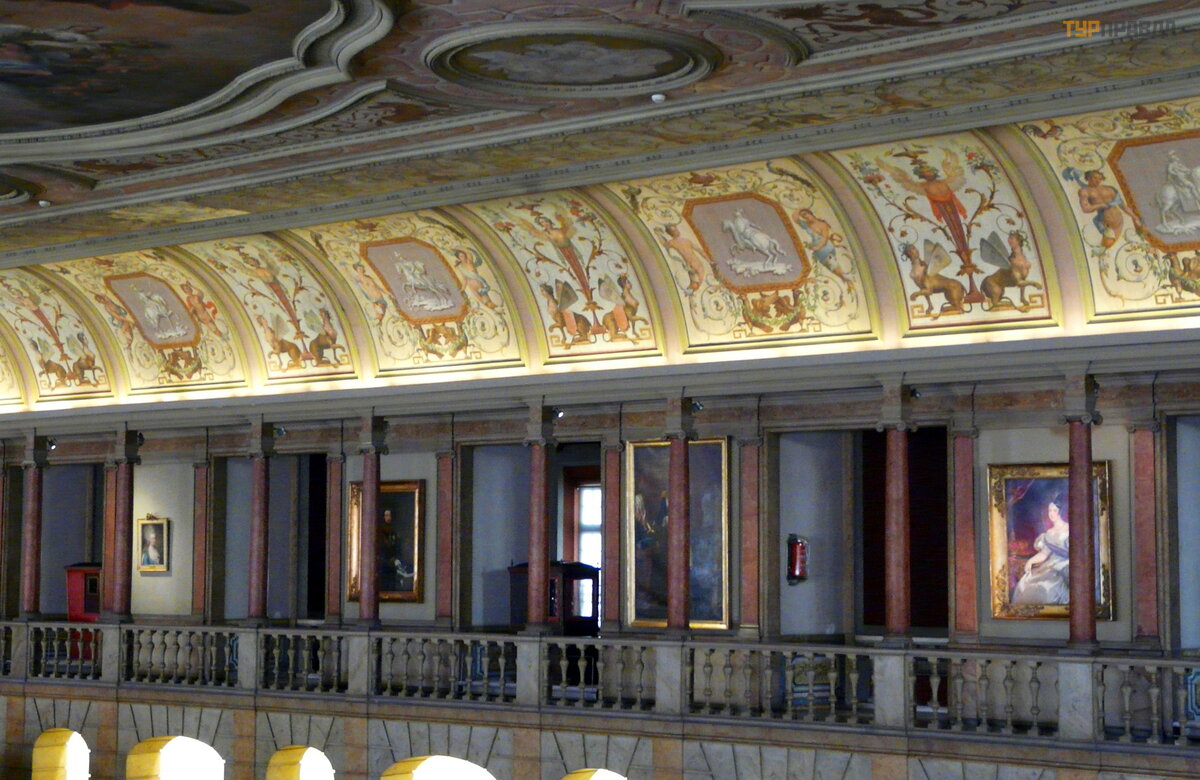
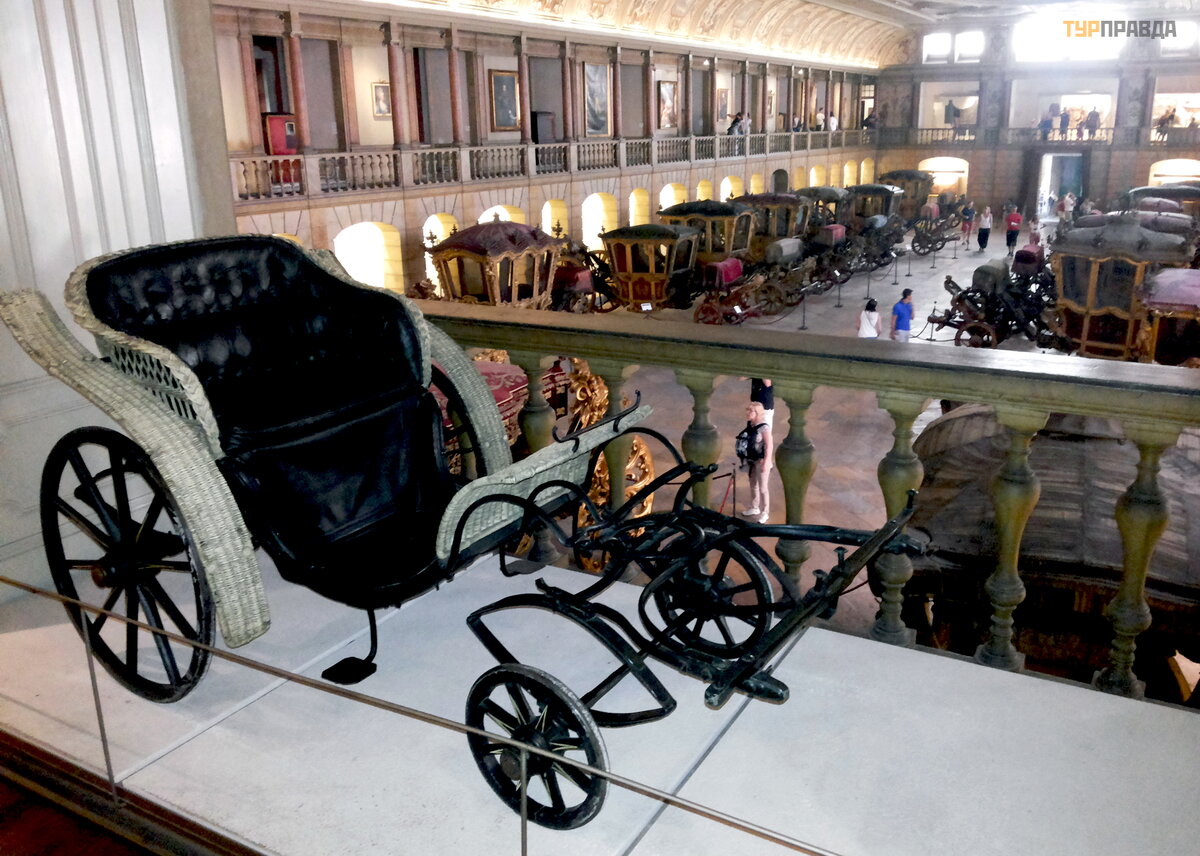
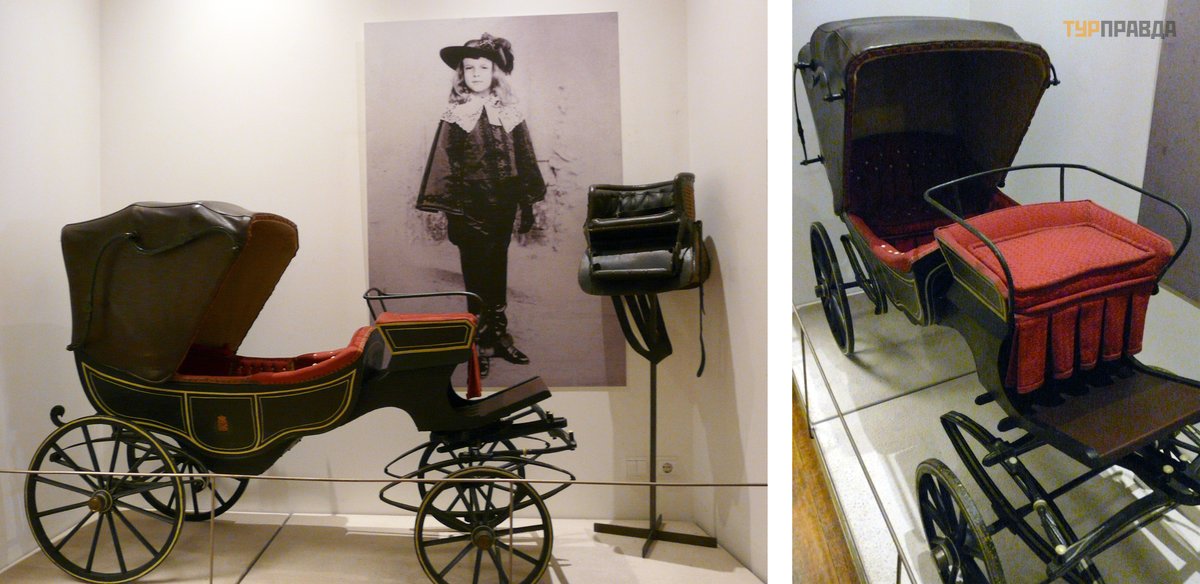
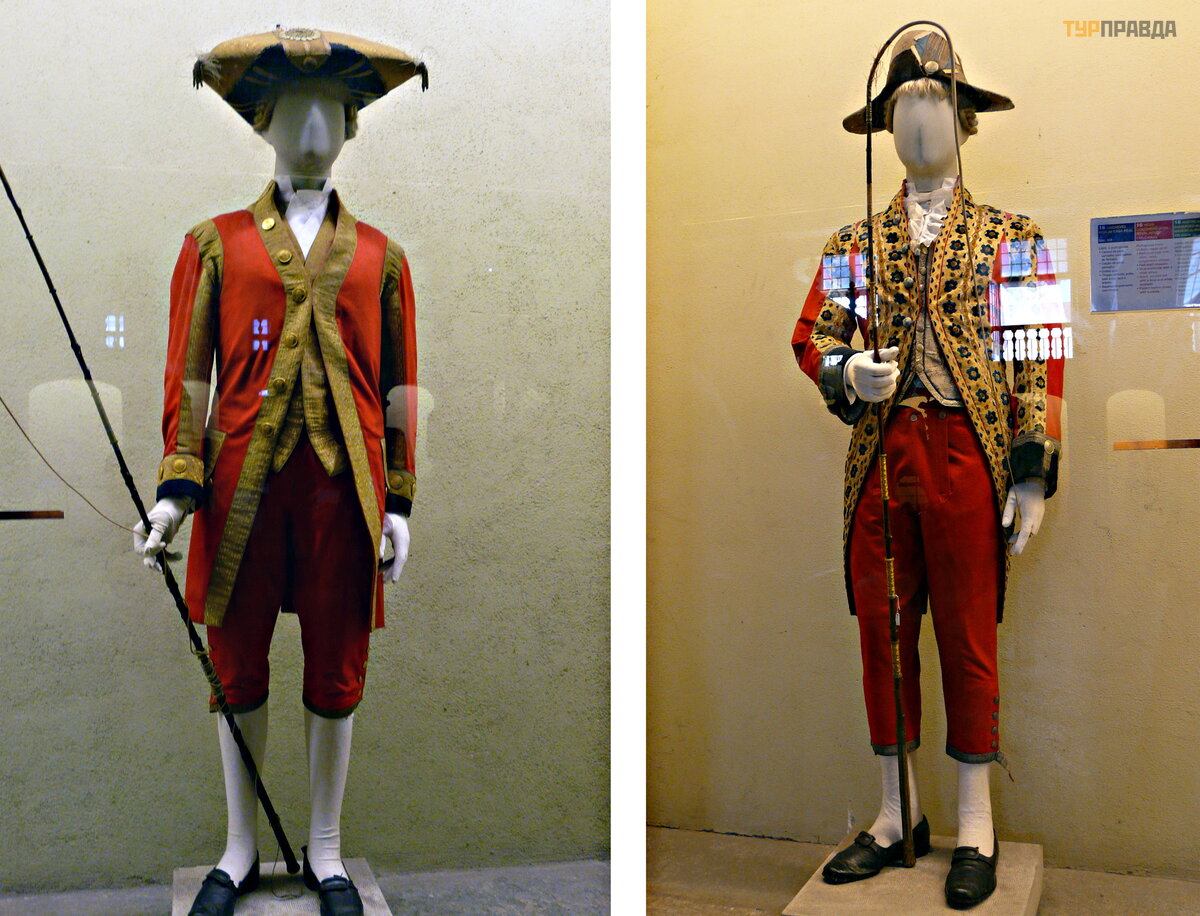
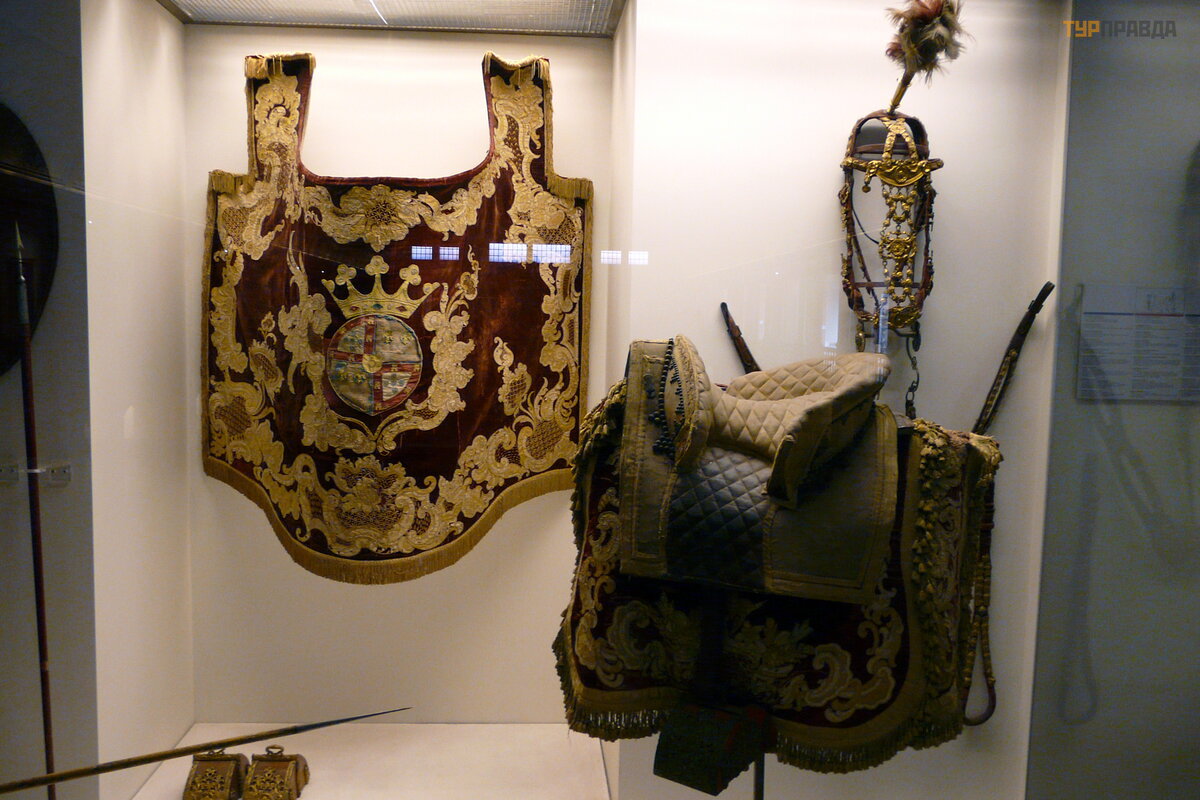
К сожалению, в зале манежа было приглушенное освещение, и потому фотографировать эту великолепную коллекцию обычным фотоаппаратом – совершенно неблагодарный труд. : ((
Официальный сайт музея: http://museudoscoches. pt/en/
Далее, малость уставшие и даже слегка очумевшие от количества впечатлений, присели на скамейке в парке напротив музея – немного передохнуть, т. к. следующий в нашем плане – Национальный дворец Ажуда (Palacio Nacional da Ajuda). Дворец находится в этом же районе – судя по карте, не очень далеко, и к нему можно подъехать автобусом. Пока отдыхали в парке и обсуждали увиденное, в нашем туристическом квартете начались разброд и шатание – половина устала и хотела домой, а вторая половина, более опытная в подобных путешествиях, была настроена посетить дворец. Победил, естественно, опыт, за что и был горячо благодарЁн после – за настойчивость и умение уговорить. : )
Казалось бы, мы уже столько дворцов повидали за несколько лет путешествий, и все равно Дворец Ажуда смог нас и удивить и восхитить! Роскошные интерьеры, просторные залы, гостеприимные сотрудники дворца, готовые показать, рассказать и ответить на все вопросы, заданные нами на корявом английском, и не менее важное – почти полное отсутствие туристов, что позволяло неспеша рассматривать королевскую обитель.
Дворец Ажуда расположен немного в стороне от основных туристических троп, и как мне показалось, туристов туда не « возят автобусами» . Поэтому посетителей были единицы, никто никому не наступал на пятки.
Правда, добираться нам таки пришлось пешком. Безуспешно просидев на остановке минут 30 и не дождавшись двух, обещанных расписанием маршрутных автобусов, мы потопали по улице, ведущей круто вверх. : ) Как оказалось, чуть выше ремонтировали дорогу, и на это время маршрут автобуса немного изменили.
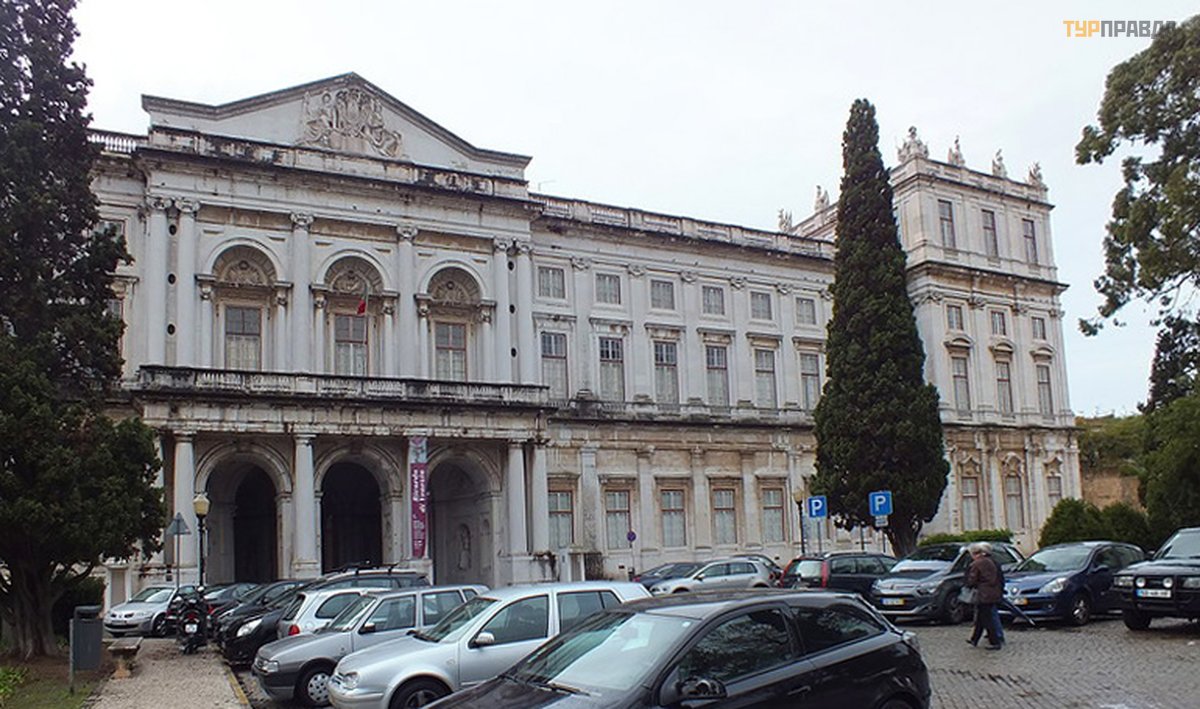 Лиссабон. Дворец Ажуда (снимок взят из интернета)
Лиссабон. Дворец Ажуда (снимок взят из интернета)
Дворец огромный, но его серый цвет с легкой обшарпанностью и кое-где отставшей штукатуркой, особенно после красивенного монастыря иеронимитов, сначала немного разочаровал и насторожил. Но закравшиеся сомнения рассеялись в первых же залах. Покои королевы, кабинет короля, биллиардная, столовая, ванные комнаты с проточной водой и предметами для гигиены… Танцевальный зал, Банкетный и Тронный залы, Зимний сад… Резная позолоченная мебель, старинные гобелены, коллекции мейсенского и севрского фарфора, великолепные хрустальные люстры и канделябры, художественные полотна известных живописцев, а также подлинные рисунки, сделанные членами королевского семейства – все это впечатляет изысканностью и красотой.
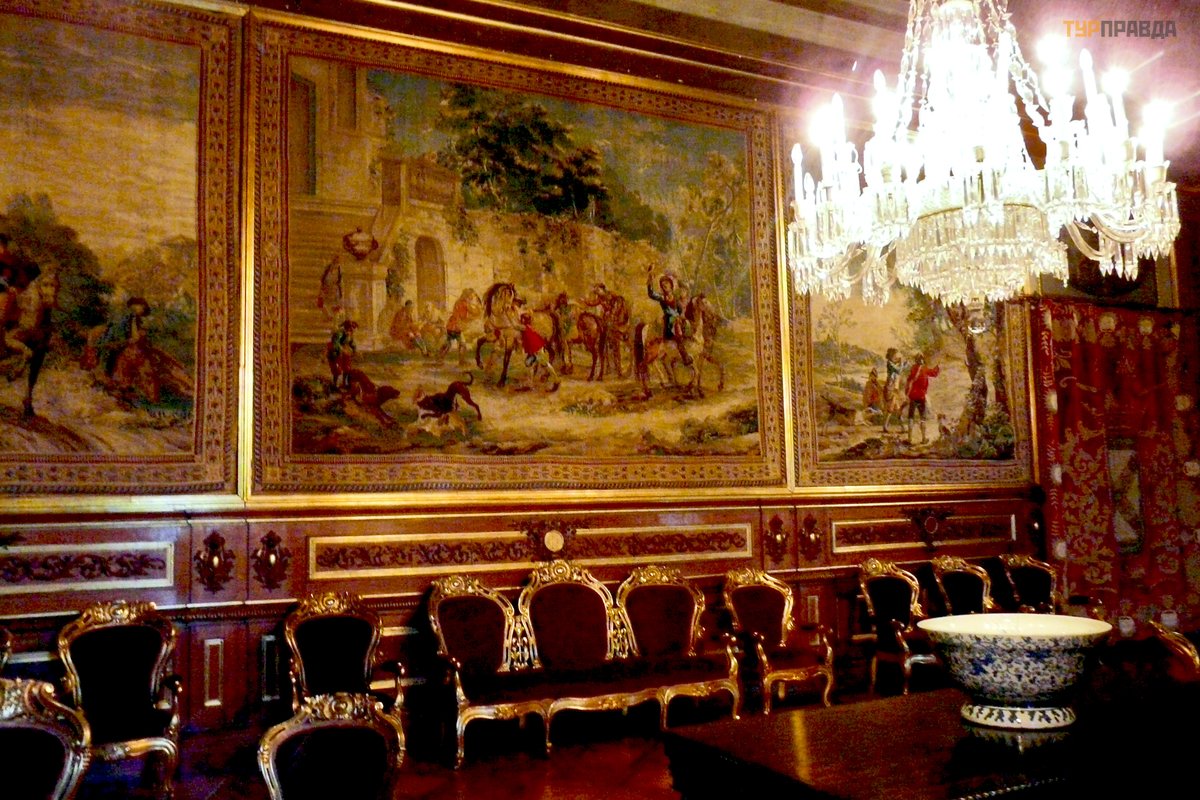 Лиссабон. Дворец Ажуда
Лиссабон. Дворец Ажуда
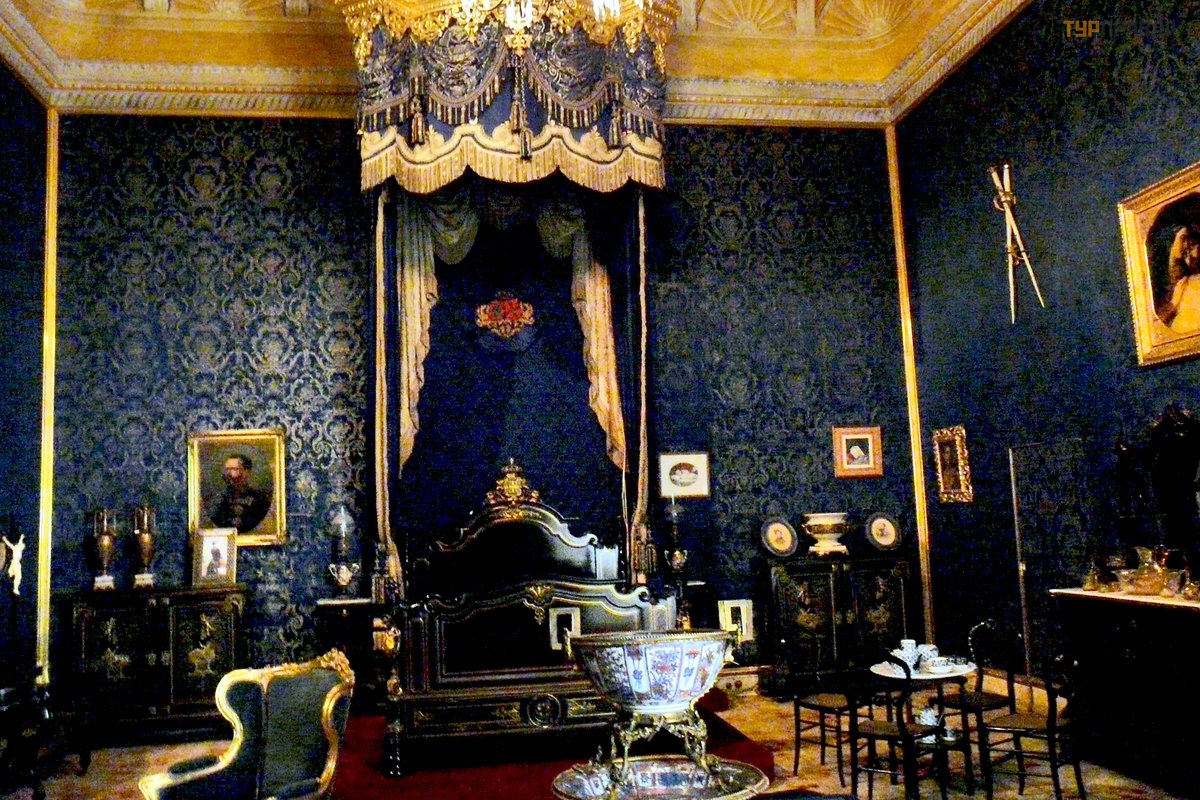 Лиссабон. Дворец Ажуда. Покои королевы
Лиссабон. Дворец Ажуда. Покои королевы
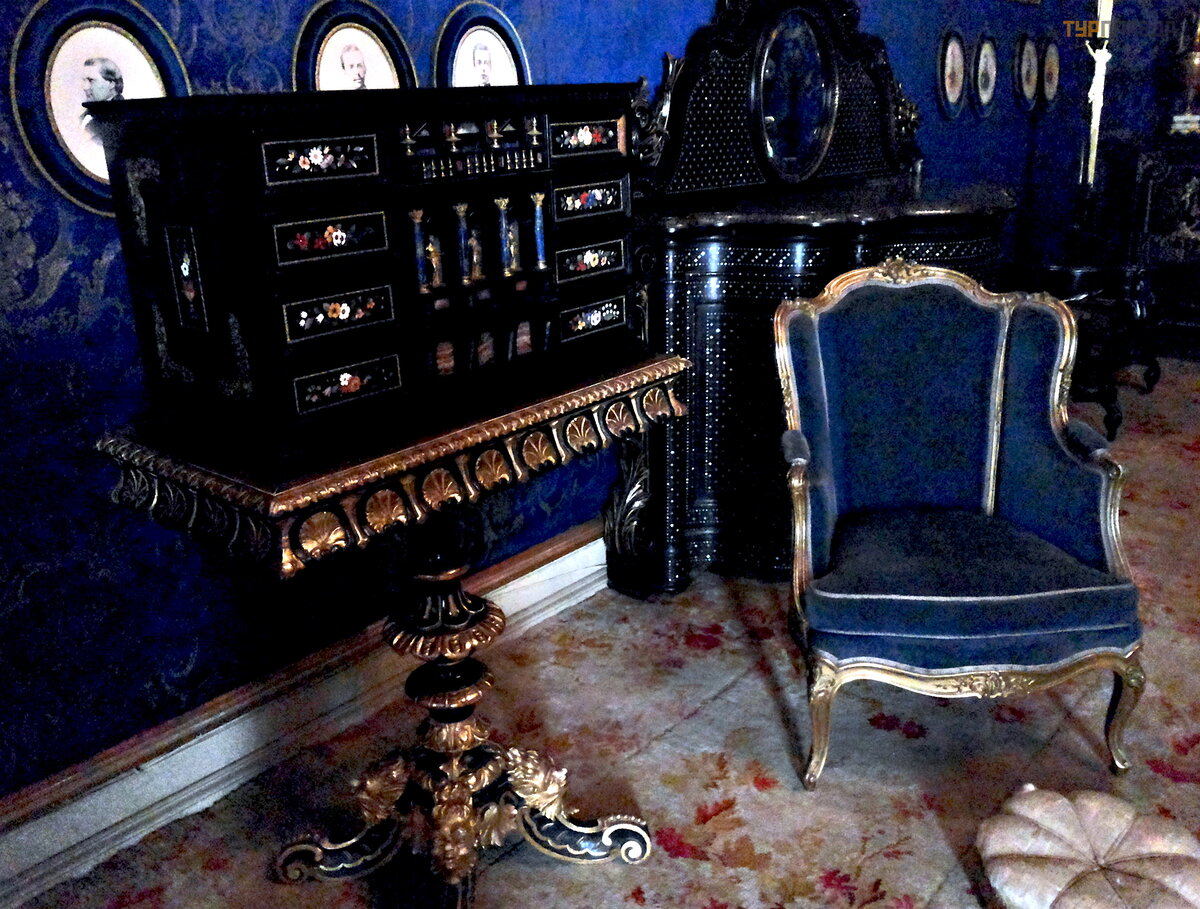
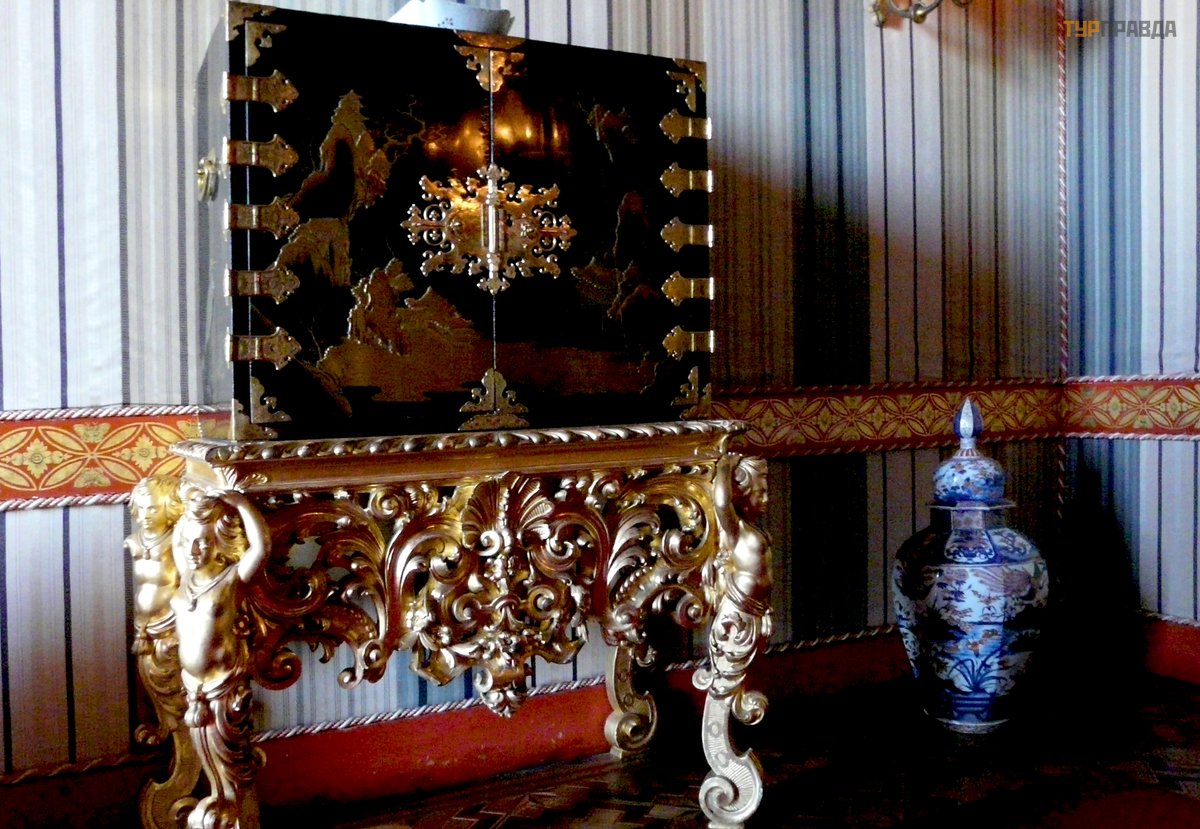
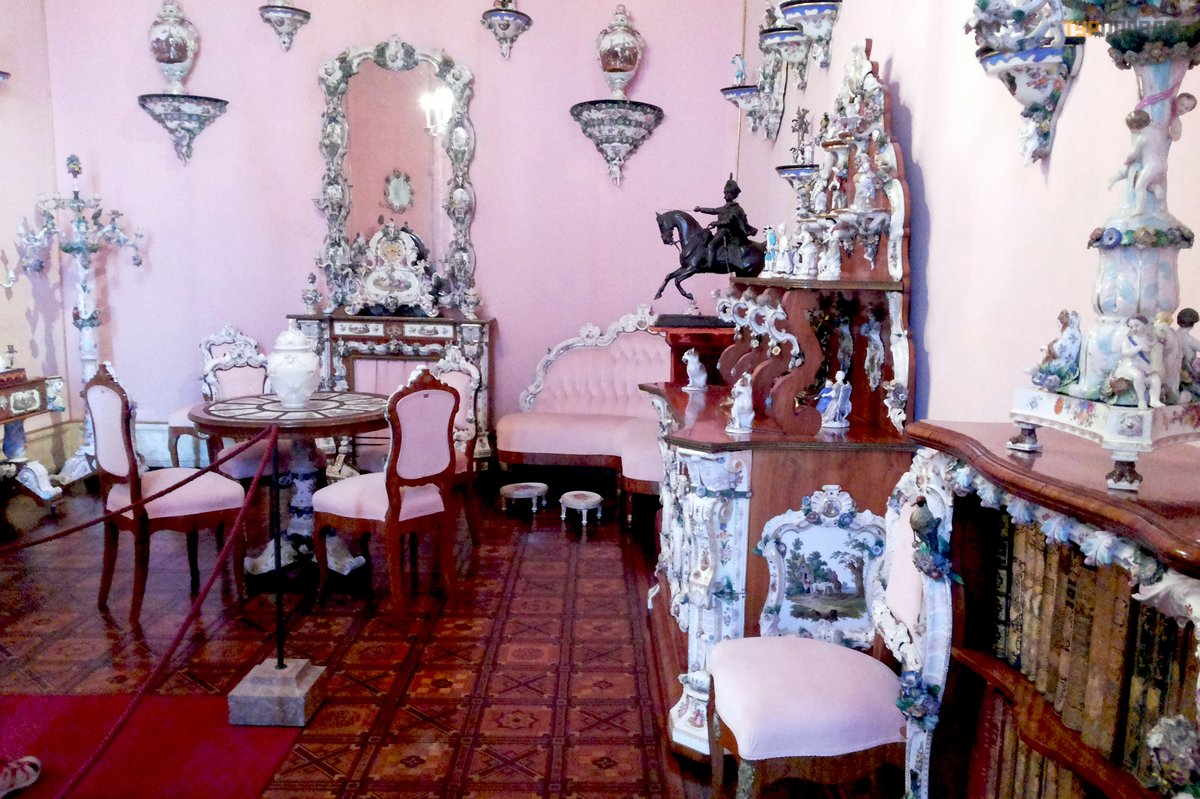
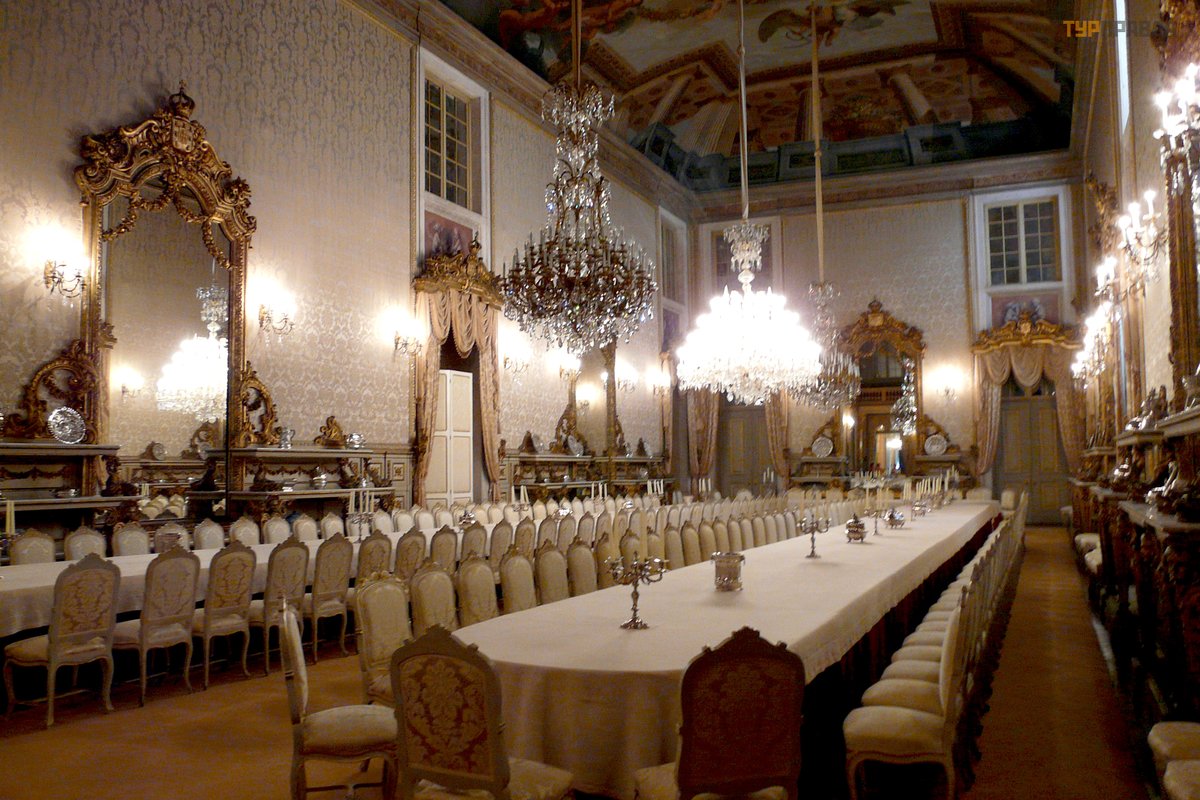 Лиссабон. Дворец Ажуда. Столовая
Лиссабон. Дворец Ажуда. Столовая
У входа во дворец стоит табличка, сообщающая о запрете фотографировать. И мы свято чтили правило, пока не заметили, что идущая следом пара местных туристов открыто фотографирует понравившиеся интерьеры… Правда, мы не осмелились снимать столь откровенно, поэтому фотографировали немного, быстро и, как оказалось, к сожалению, не всегда качественно. : (
Дворец Ажуда стал последней резиденцией королевского семейства в Португалии – королевская династия жила здесь с 1861 года до 1910 года, когда военным переворотом в стране была свергнута монархия.
Большую часть старинного королевского дворца сегодня занимает музей, в остальных помещениях размещается Национальная библиотека Ажуда, Министерство культуры. Изредка во дворце проводятся официальные встречи высокопоставленных лиц Португалии и торжественные церемонии государственного уровня.
Официальный сайт: http://www. palacioajuda. pt
Недалеко от дворца расположился Ботанический сад Ажуда. Это самый старый ботанический сад Португалии. Он был создан в 1768 году по распоряжению маркиза Помбала. Во время вторжения французской армии в 1808 году значительная часть коллекции Королевского сада была уничтожена. После свержения монархии и объявления Республики сад открыли для посетителей.
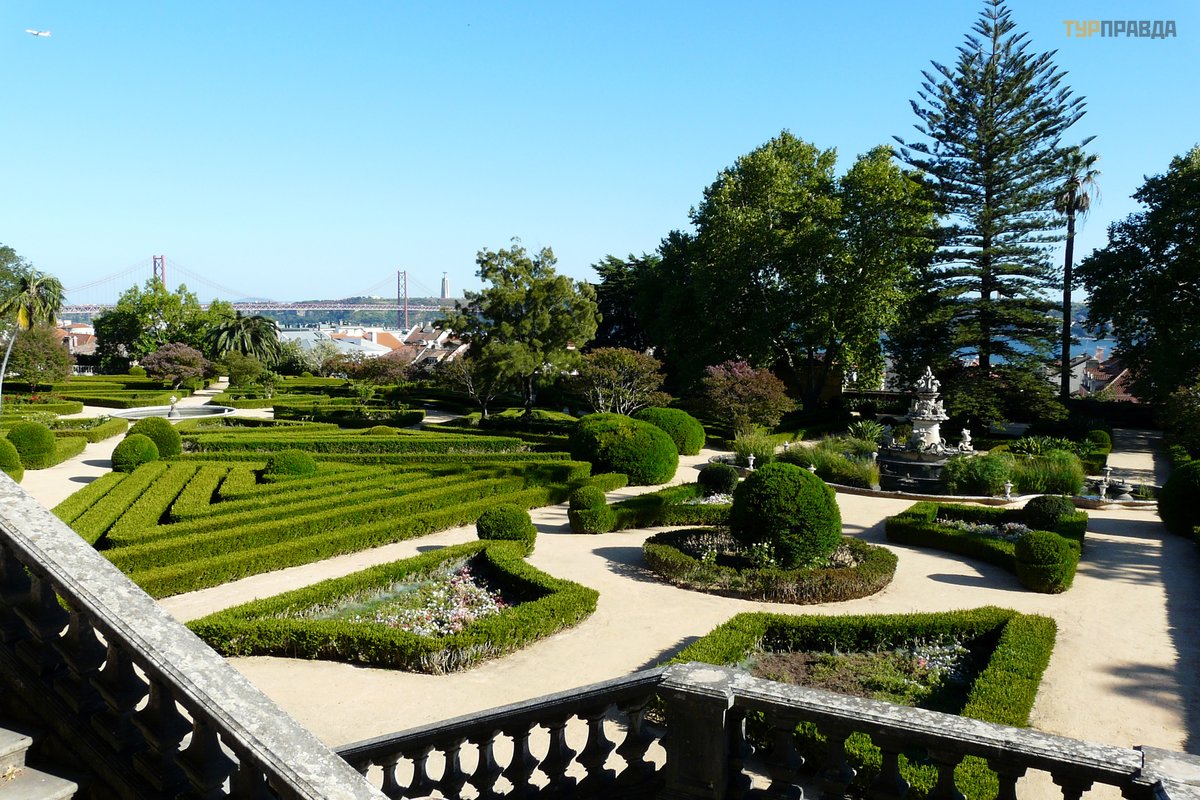 Лиссабон. Ботанический сад Ажуда.
Лиссабон. Ботанический сад Ажуда.
Сад небольшой, и мы довольно таки быстро его обошли. В центре – фонтан XVIII века с морским сюжетом. Гордостью сада является 400-летняя драцена, привезенная с острова Мадейра.
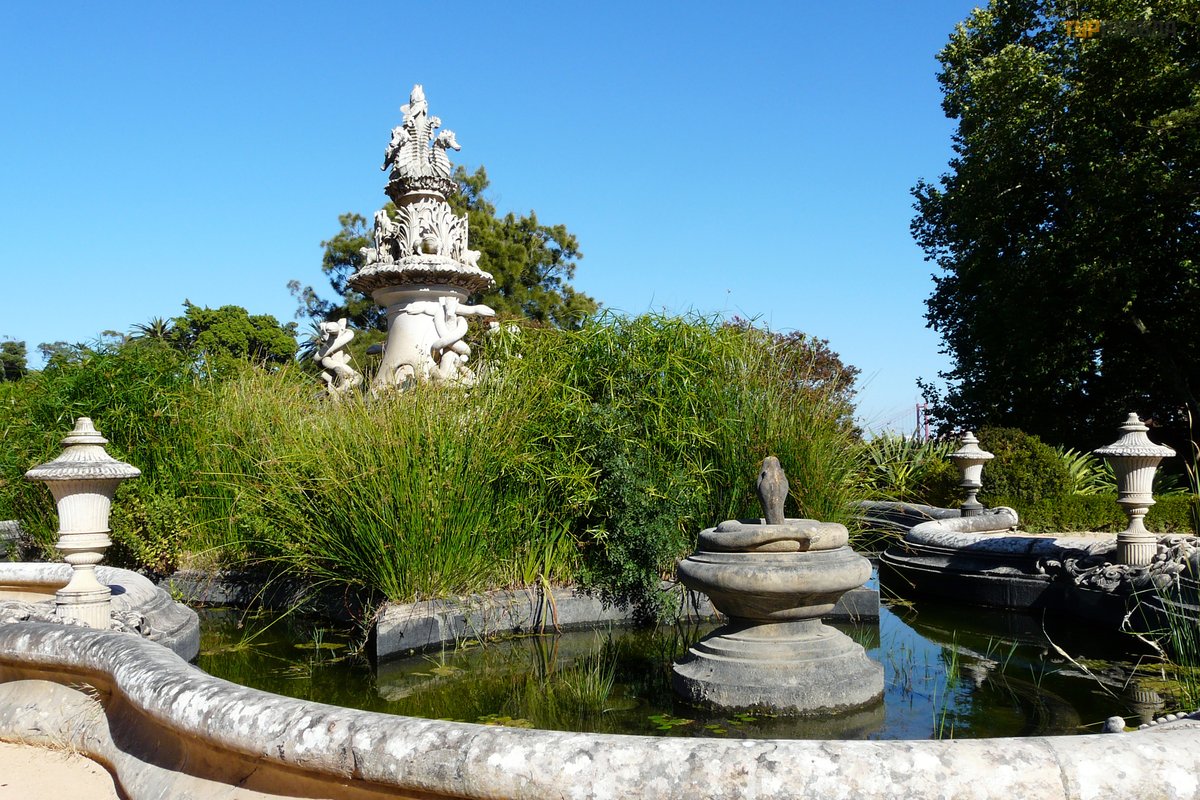 Лиссабон. Ботанический сад Ажуда.
Лиссабон. Ботанический сад Ажуда.
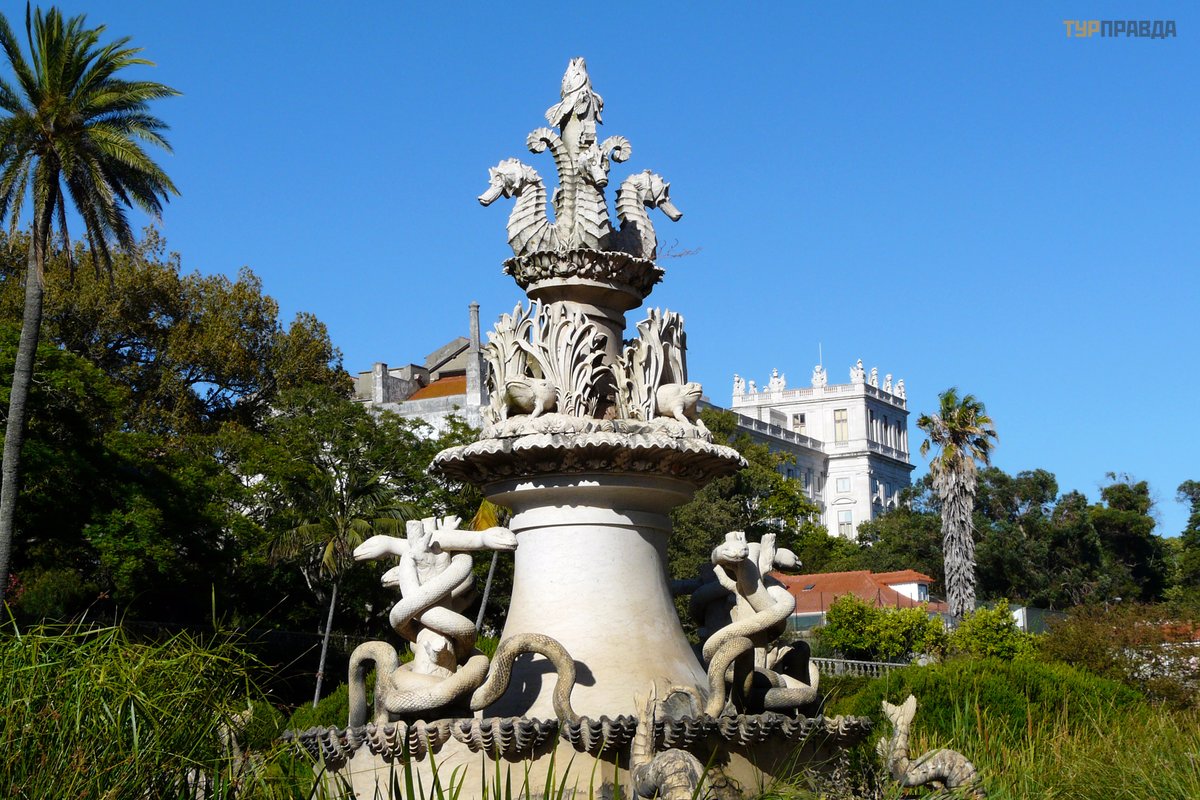 Лиссабон. Ботанический сад Ажуда. Фонтан
Лиссабон. Ботанический сад Ажуда. Фонтан
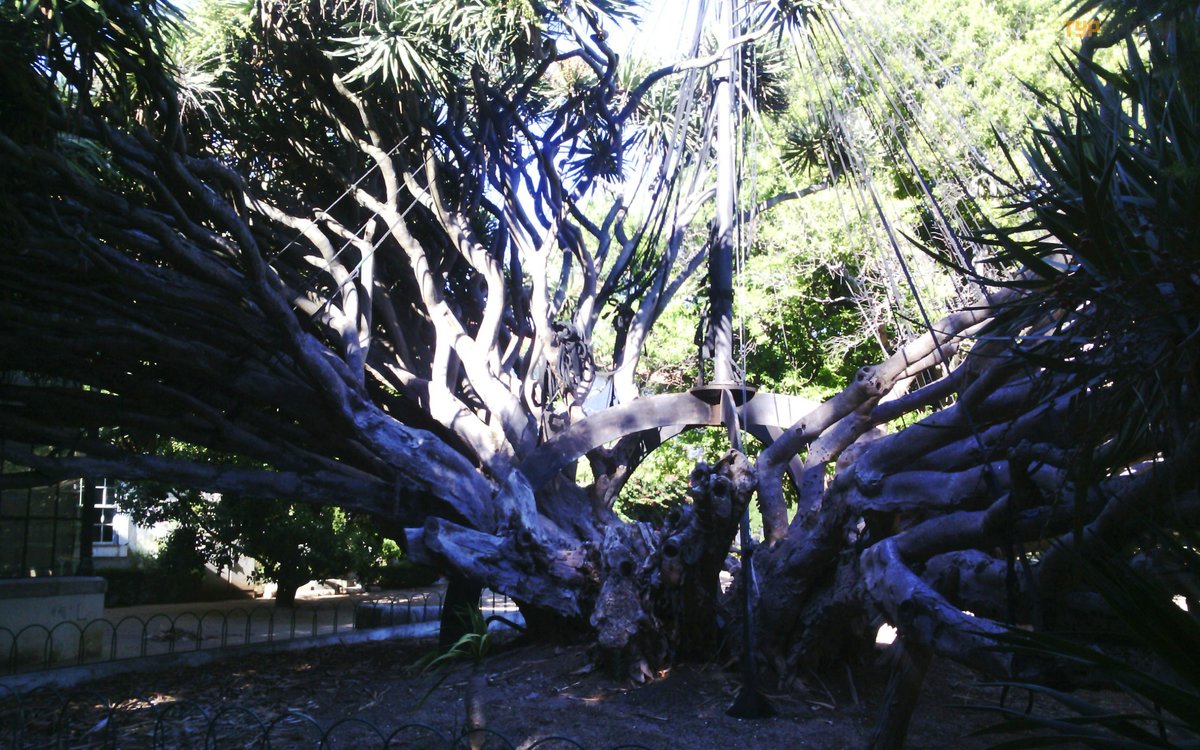 Лиссабон. Ботанический сад Ажуда. 400-летняя драцена
Лиссабон. Ботанический сад Ажуда. 400-летняя драцена
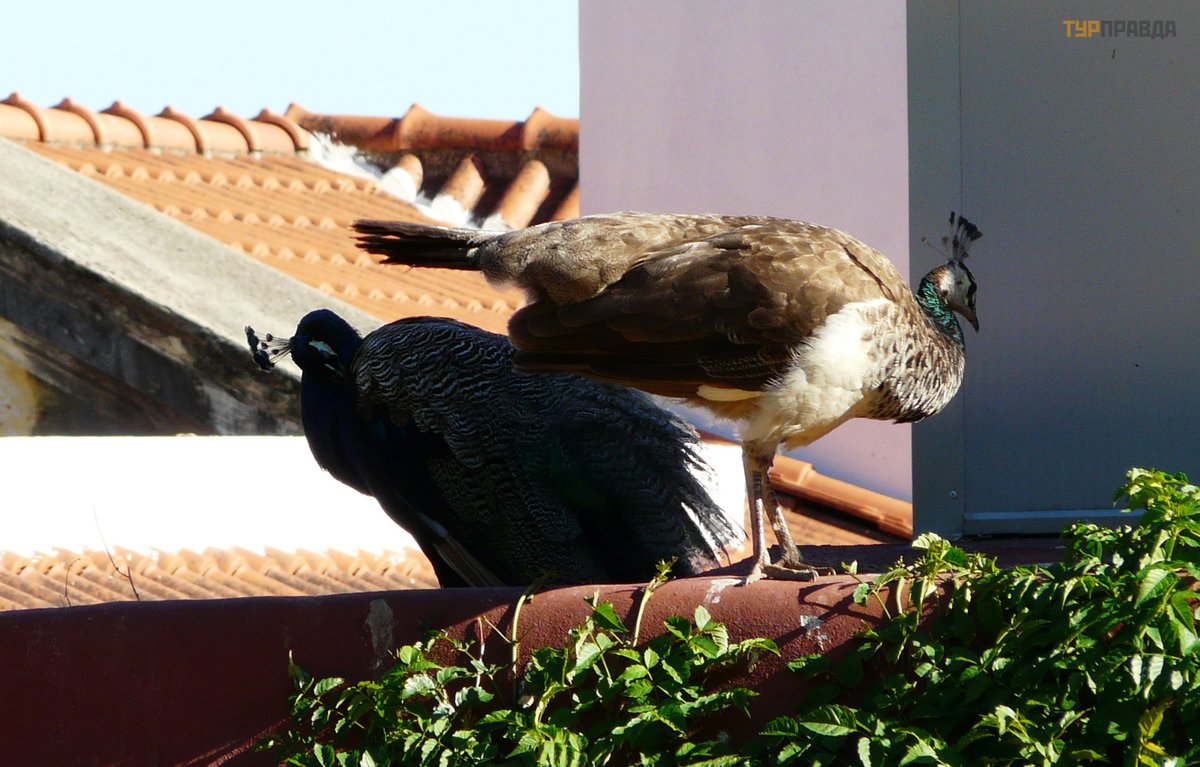 Лиссабон. Ботанический сад Ажуда.
Лиссабон. Ботанический сад Ажуда.
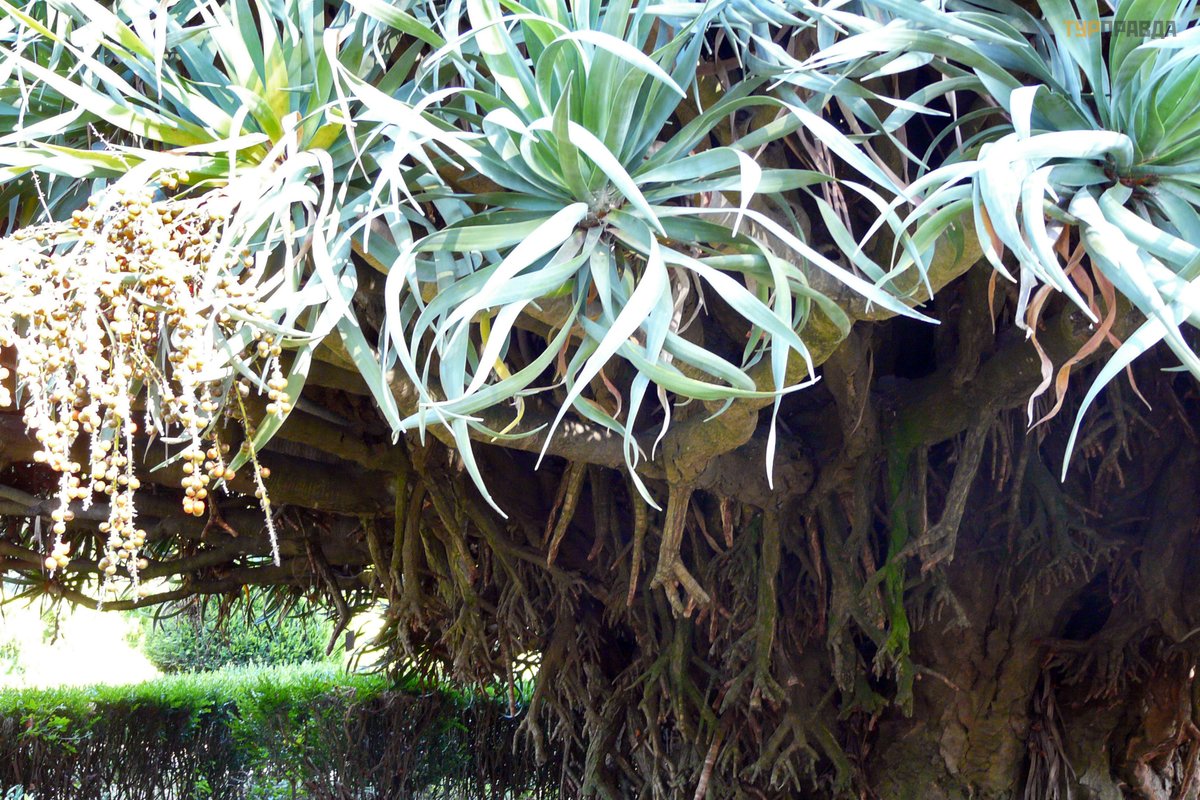 Лиссабон. Ботанический сад Ажуда.
Лиссабон. Ботанический сад Ажуда.
К тому моменту, когда мы попали в сад, у нас, у всех четверых, по очереди начали « садиться» фотоаппараты, телефоны и планшеты, сигнализируя нам, что ничьи ресурсы не безграничны, и пора закругляться. : ) Да и ноги уже гудели от усталости. К нашей радости, в конце сада оказался второй выход и прямо напротив – автобусная остановка. В этот раз автобус пришел и – точно по расписанию. : ))
It was the third day of our acquaintance with Lisbon. In the first one, we walked the city from north to south, to Commerce Square (Praca do Commercio), in the second, we explored the city with the help of the 28th tram, funiculars, observation platforms and, of course, our feet. We decided to dedicate the third day to the Belen area, where tram number 15 brings all the tourists.
We started from the farthest point of our route - Belem Tower (Torre de Belem), built more than five centuries ago as an important strategic and defensive structure.
 Lisbon. Belem Tower
Lisbon. Belem Tower
Built in 1515 in the middle of the river, it was supposed to protect the entrance to the harbor of Lisbon. It was she who was seen by sailors, returning home after long wanderings, she was also the “last look at their homeland” for the Portuguese, who were serving on long-distance sea expeditions. And a small statue of Our Lady and Child on the terrace of the tower has become a symbol of the protection of sailors during their voyages.
 Belem Tower, statue of Our Lady
Belem Tower, statue of Our Lady
We arrived at the Belem Tower shortly before the opening, a small queue had already gathered. We immediately took a complex ticket to visit the tower and the monastery of Jeronimos. I don’t remember the price exactly, I only remember that such a ticket turned out to be cheaper than if we bought tickets separately for each object. And after that we entered the monastery, bypassing a huge queue.
 Lisbon. Belem Tower
Lisbon. Belem Tower
The tower is a kind of mini-castle surrounded by battlements with loopholes on the defensive tiers, with many watchtowers topped with Moorish domes, with Venetian-style balconies and loggias. On the ground floor there is a small covered gallery with access to the patio. On the second level there is an open terrace with an openwork balustrade. From there, narrow steep steps lead to the top of the castle. On the upper floors are the Royal and Governor's Halls and the Audience Hall.
 Belem Tower
Belem Tower
 Belem Tower, Terrace
Belem Tower, Terrace
 Belem Tower
Belem Tower
 Belem Tower
Belem Tower
 Belem Tower
Belem Tower
An earthquake in 1755 changed the course of the river, and now the tower stands almost on the bank.
Curiously, in order to separate the oncoming streams of tourists on a narrow steep staircase, special traffic lights with a timer were made to regulate traffic.
The next point of our route is the Jeronimos Monastery, the most grandiose building in Lisbon, one of the seven wonders of Portugal. You can get to it by returning to the tram and driving one stop, but we decided to walk along the embankment past the monument to the Discoverers erected in 1960.
The monument resembles a giant caravel. At the head is the famous Prince Enrique the Navigator, under whose influence Portugal once became a great maritime power. Behind him - King Afonso V and Vasco da Gama. In total, on both sides of the monument there are 32 figures of prominent people of the country who contributed to the formation of Portugal as a maritime empire. At the top there is an observation deck, which can be reached by elevator.
 Lisbon. Monument to the Discoverers
Lisbon. Monument to the Discoverers

Lisbon. Square in front of the monument to the Discoverers. Picture taken from the Internet
The monument was covered with a net - something we were lucky on this trip to the restored sights : )). But a huge map of the world, lined with colored marble on the square in front of the stele, attracted our attention and the attention of many tourists for a long time.
 Lisbon. Square in front of the Monument to the Discoverers
Lisbon. Square in front of the Monument to the Discoverers
 Lisbon. Square in front of the monument to the Discoverers
Lisbon. Square in front of the monument to the Discoverers
After reading all the inscriptions on the map : ), we cross a huge, beautiful square with a fountain. Directly in front of us is the Jeronimos Monastery (Mosteiro dos Jeronimos), an impressive building, a symbol of the power and wealth of Portugal during the Age of Discovery.
 Lisbon. Square in front of the monument to the Discoverers
Lisbon. Square in front of the monument to the Discoverers
 Lisbon. Jeronimos Monastery
Lisbon. Jeronimos Monastery
 Lisbon. Jeronimos Monastery
Lisbon. Jeronimos Monastery
 Lisbon. Jeronimos Monastery
Lisbon. Jeronimos Monastery
King Manuel I began building the monastery in 1501 on the site of a chapel erected by Prince Henry the Navigator. In this chapel, Vasco da Gama and his team spent the last night in prayer before their departure for India.
Heinrich was known for his passion for discovering new lands. He equipped expeditions for the systematic exploration of the near coast of the Atlantic and the coast of Africa, and further to India. It was the proceeds from the sale of spices and treasures brought from Asia, Africa and South America that became a constant source of funding for the construction and expansion of the monastery, which lasted more than half a century. And it cost the treasury annually 750 tons of gold.
The monastery was built in memory of the expedition of Vasco da Gama and as gratitude to the Virgin Mary for the successful journey of the navigator.
The king named the new monastery de Santa Maria de Belen and gave it to the Order of Saint Jerome - so that the monks pray daily for the souls of the king and his successors, as well as all sailors sailing from Portugal.
It so happened that we slipped through the entrance to the monastery church and immediately got into the cloister, surrounded by galleries with monastery premises. Openwork arches and balustrades, decorated with marine motifs - interlacing of ropes, images of corals and sea shells, figures of animals, sea monsters, unique carved ornaments, each element of which was not repeated twice - everything they saw took their breath away, their eyes ran from the inability to cover everything. I wanted to consider every detail of the jewelry, called the "Manueline style" - a style that combined late Gothic, Moorish style and the influence of the early Renaissance.
 Jeronimos Monastery. Cloister
Jeronimos Monastery. Cloister
 Jeronimos Monastery. Cloister
Jeronimos Monastery. Cloister
 Jeronimos Monastery
Jeronimos Monastery
 Jeronimos Monastery
Jeronimos Monastery
 Jeronimos Monastery
Jeronimos Monastery
 Jeronimos Monastery. Refectory
Jeronimos Monastery. Refectory
 Jeronimos Monastery. Refectory
Jeronimos Monastery. Refectory
Inside the monastery are the tombs of Vasco da Gama and the poet Luis de Camõ es, author of the poem "The Lusiades", in which he glorifies the triumph of da Gama and his comrades. Kings Manuel I and Juan III, poets Fernando Pessoa and Alessandro Herculano and other great personalities who created the history of Portugal are also buried here.

Tomb of Vasco da Gama, this image from the Internet
 Jeronimos Monastery. Tomb of Luis Camõ es
Jeronimos Monastery. Tomb of Luis Camõ es
And here an incident happened - trying to find the entrance to the monastery church, we got lost. Several times they walked around all the premises around the monastery courtyard, climbed to the second tier, got to the balcony overlooking the church hall and examined it “from above”, but could not find the main entrance. : ) We decided to return to the main entrance to the monastery, to where there is a large queue of those wishing to get in from the street : ), and immediately found the right door on the right. : )
 Jeronimos Monastery. Cathedral
Jeronimos Monastery. Cathedral
 Jeronimos Monastery. Cathedral
Jeronimos Monastery. Cathedral
 Jeronimos Monastery. Church
Jeronimos Monastery. Church
The church of the monastery of Jeronimos is famous for its portals. The most beautiful is the southern portal on the facade stretching along the river. In the center of the portal is a sculpture of the Mother of God with a baby, holding a vase with the gifts of the Magi, on the sides of it are the figures of the prophets, apostles, church leaders and saints. Here are scenes from the life of St. Jerome, a little higher - the coat of arms of Portugal. Below, between the doors of the church, is a sculpture of Henry the Navigator with a sword, at whose feet stone lions froze in battle.
 Jeronimos Monastery. South Portal
Jeronimos Monastery. South Portal
 Jeronimos Monastery. South Portal
Jeronimos Monastery. South Portal
The National Archaeological Museum and part of the Maritime Museum are located in the western wing of the monastery. Official site: www. mosteirojeronimos. pt
The Belem Tower and the Jeronimos Monastery are the only large monuments of the Age of Discovery that survived the 1755 earthquake in Lisbon.
Coming out of the monastery, completely delighted with what we saw, we decided to have coffee in the Pasteis de Belem cafe, where, they say, the most delicious pasteis de nata cakes (pasteis de nata). And how can you pass by the most famous Lisbon cafe, whose reputation has not changed since 1837, if it is located next to the Jeronimos Monastery ? ? : )) In addition to coffee and pasta, we took a piece of pie with different fillings - time imperceptibly approached dinner. Sitting at a table in a cafe, we got acquainted with Muscovites - exchanged impressions about Portugal, asked them about Sintra, where we were going the next day.
 Lisbon, Cafe Pasteis de Belem. The line at the cafe in the afternoon
Lisbon, Cafe Pasteis de Belem. The line at the cafe in the afternoon
 Pasteis de Belem, Lisbon
Pasteis de Belem, Lisbon
As girls who loved the fairy tale about Cinderella in their childhood and dreamed of riding in a luxurious carriage at least once, we could not miss the museum of carriages, which is considered the best in the world. Moreover, it is located a little further along the same street as the monastery of the Hieronymites. : )
The National Carriage Museum (Museu Nacional dos Coches) is located in the building of the former riding school at the royal palace, which has now become the residence of the President of Portugal.
 Lisbon. National Carriage Museum. (picture from internet)
Lisbon. National Carriage Museum. (picture from internet)
In order to preserve the props of the Portuguese royal court, Queen Amelia decided in 1905 to create a museum of carriages in the building of the royal arena. Most of the carriages belonged to the Portuguese royal family. But the collection also includes carriages of embassies, and carriages that once belonged to the Pope, the head of the Catholic Church.
 Lisbon. National Carriage Museum
Lisbon. National Carriage Museum
The museum's collection is considered one of the most unique collections in the world - it contains carriages made in Portugal, Italy, Austria, Spain and France. In addition to carriages, there are cabriolets, landau, sedan chairs, charabans, phaetons and children's carts in which ponies were harnessed, etc.









The oldest and most valuable item in the collection, dating from the end of the 16th to the beginning of the 17th century, is the carriage of King Philip II of Spain, on which he came to Portugal in 1619. The carriage is not only the oldest, but also the most modest. Fashion has changed - the design of the crew has also changed. Over time, the carriages became more luxurious and refined, velvet, gilding and mahogany trim appeared, they began to be decorated with statues and candelabra.






In the upper part of the arena there were stands connected by narrow galleries, and at both ends of the building there were balconies for the judges and the royal family, from where they watched the competitions. Now in the upper part of the hall there are prams, pony carts, charabans, landau, as well as various intricate accessories for horseback riding - spurs, saddles, harness and uniforms. The walls are decorated with portraits of members of the royal family.





Unfortunately, there was subdued lighting in the arena hall, and therefore photographing this magnificent collection with an ordinary camera is an absolutely thankless task. : ((
The official website of the museum: http://museudoscoches. pt/en/
Further, a little tired and even a little crazy from the number of impressions, we sat down on a bench in the park opposite the museum - to take a break, because the next one in our plan is the Ajuda National Palace (Palacio Nacional da Ajuda). The palace is located in the same area - judging by the map, not very far away, and you can drive up to it by bus. While we were resting in the park and discussing what we saw, confusion and vacillation began in our tourist quartet - half were tired and wanted to go home, and the other half, more experienced in such travels, was determined to visit the palace. Naturally, experience won, for which I was warmly grateful afterward - for perseverance and the ability to persuade. : )
It would seem that we have already seen so many palaces in a few years of travel, and still the Palace of Ajuda was able to surprise and delight us! Luxurious interiors, spacious halls, hospitable staff of the palace, ready to show, tell and answer all the questions we asked in clumsy English, and no less important - the almost complete absence of tourists, which allowed us to leisurely examine the royal monastery.
Ajuda Palace is located a little away from the main tourist trails, and it seemed to me that tourists are not “taken by buses” there. Therefore, there were only a few visitors, no one stepped on anyone's heels.
True, we still had to get there on foot. After unsuccessfully sitting at the bus stop for 30 minutes and not waiting for the two shuttle buses promised by the schedule, we stomped along the street leading up steeply. : ) As it turned out, the road was being repaired a little higher, and for this time the bus route was slightly changed.
 Lisbon. Ajuda Palace (picture taken from the Internet)
Lisbon. Ajuda Palace (picture taken from the Internet)
The palace is huge, but its gray color with a slight shabby and in some places lagging plaster, especially after the beautiful monastery of Hieronymites, at first disappointed and alerted a little. But the doubts that crept in dissipated in the very first halls. The queen's chambers, the king's study, the billiard room, the dining room, bathrooms with running water and hygiene items... The dance hall, the Banquet and Throne rooms, the Winter Garden... Carved gilded furniture, antique tapestries, collections of Meissen and Sevres porcelain, magnificent crystal chandeliers and candelabra, art canvases by famous painters, as well as original drawings made by members of the royal family - all this impresses with sophistication and beauty.
 Lisbon. Ajuda Palace
Lisbon. Ajuda Palace
 Lisbon. Ajuda Palace. Queen's quarters
Lisbon. Ajuda Palace. Queen's quarters



 Lisbon. Ajuda Palace. Dining room
Lisbon. Ajuda Palace. Dining room
At the entrance to the palace there is a sign saying that photography is prohibited. And we sacredly honored the rule until we noticed that a couple of local tourists walking behind were openly photographing the interiors they liked... True, we did not dare to shoot so frankly, so we took pictures a little, quickly and, as it turned out, unfortunately, not always of high quality. : (
Ajuda Palace was the last residence of the royal family in Portugal - the royal dynasty lived here from 1861 until 1910, when the monarchy was overthrown by a military coup in the country.
Most of the ancient royal palace today is occupied by a museum, the rest of the premises house the National Library of Ajuda, the Ministry of Culture. Occasionally, official meetings of dignitaries of Portugal and state-level ceremonies are held in the palace.
Official site: http://www. palacioajuda. pt
Not far from the palace is the Ajuda Botanical Garden. This is the oldest botanical garden in Portugal. It was created in 1768 by order of the Marquis of Pombal. During the invasion of the French army in 1808, a significant part of the Royal Garden collection was destroyed. After the overthrow of the monarchy and the announcement of the Republic, the garden was opened to visitors.
 Lisbon. Ajuda Botanical Garden.
Lisbon. Ajuda Botanical Garden.
The garden is small, and we walked around it pretty quickly. In the center is an 18th-century fountain with a marine theme. The pride of the garden is a 400-year-old dracaena brought from the island of Madeira.
 Lisbon. Ajuda Botanical Garden.
Lisbon. Ajuda Botanical Garden.
 Lisbon. Ajuda Botanical Garden. Fountain
Lisbon. Ajuda Botanical Garden. Fountain
 Lisbon. Ajuda Botanical Garden. 400 year old dracaena
Lisbon. Ajuda Botanical Garden. 400 year old dracaena
 Lisbon. Ajuda Botanical Garden.
Lisbon. Ajuda Botanical Garden.
 Lisbon. Ajuda Botanical Garden.
Lisbon. Ajuda Botanical Garden.
By the time we got into the garden, all four of us, in turn, began to "sit down" cameras, phones and tablets, signaling to us that no one's resources are unlimited, and it's time to wrap up. : ) Yes, and the legs were already buzzing with fatigue. To our joy, at the end of the garden there was a second exit and directly opposite - a bus stop. This time the bus came and - right on schedule. : ))
 Belem Tower, statue of Our Lady
Belem Tower, statue of Our Lady Lisbon. Monument to the Discoverers
Lisbon. Monument to the Discoverers
 Lisbon. Square in front of the Monument to the Discoverers
Lisbon. Square in front of the Monument to the Discoverers  Lisbon. Square in front of the monument to the Discoverers
Lisbon. Square in front of the monument to the Discoverers Lisbon. Square in front of the monument to the Discoverers
Lisbon. Square in front of the monument to the Discoverers Jeronimos Monastery. Refectory
Jeronimos Monastery. Refectory Jeronimos Monastery. Refectory
Jeronimos Monastery. Refectory
 Jeronimos Monastery. Tomb of Luis Camõ es
Jeronimos Monastery. Tomb of Luis Camõ es Jeronimos Monastery. Cathedral
Jeronimos Monastery. Cathedral Jeronimos Monastery. Cathedral
Jeronimos Monastery. Cathedral Jeronimos Monastery. South Portal
Jeronimos Monastery. South Portal Jeronimos Monastery. South Portal
Jeronimos Monastery. South Portal Lisbon, Cafe Pasteis de Belem. The line at the cafe in the afternoon
Lisbon, Cafe Pasteis de Belem. The line at the cafe in the afternoon  Lisbon. National Carriage Museum. (picture from internet)
Lisbon. National Carriage Museum. (picture from internet) Lisbon. National Carriage Museum
Lisbon. National Carriage Museum Lisbon. Ajuda Palace (picture taken from the Internet)
Lisbon. Ajuda Palace (picture taken from the Internet) Lisbon. Ajuda Palace. Queen's quarters
Lisbon. Ajuda Palace. Queen's quarters  Lisbon. Ajuda Palace. Dining room
Lisbon. Ajuda Palace. Dining room Lisbon. Ajuda Botanical Garden.
Lisbon. Ajuda Botanical Garden.  Lisbon. Ajuda Botanical Garden.
Lisbon. Ajuda Botanical Garden.  Lisbon. Ajuda Botanical Garden. Fountain
Lisbon. Ajuda Botanical Garden. Fountain Lisbon. Ajuda Botanical Garden. 400 year old dracaena
Lisbon. Ajuda Botanical Garden. 400 year old dracaena Lisbon. Ajuda Botanical Garden.
Lisbon. Ajuda Botanical Garden.  Lisbon. Ajuda Botanical Garden.
Lisbon. Ajuda Botanical Garden. 











































































































































































